Quick filters:
Ukiyo Stock Photos and Images
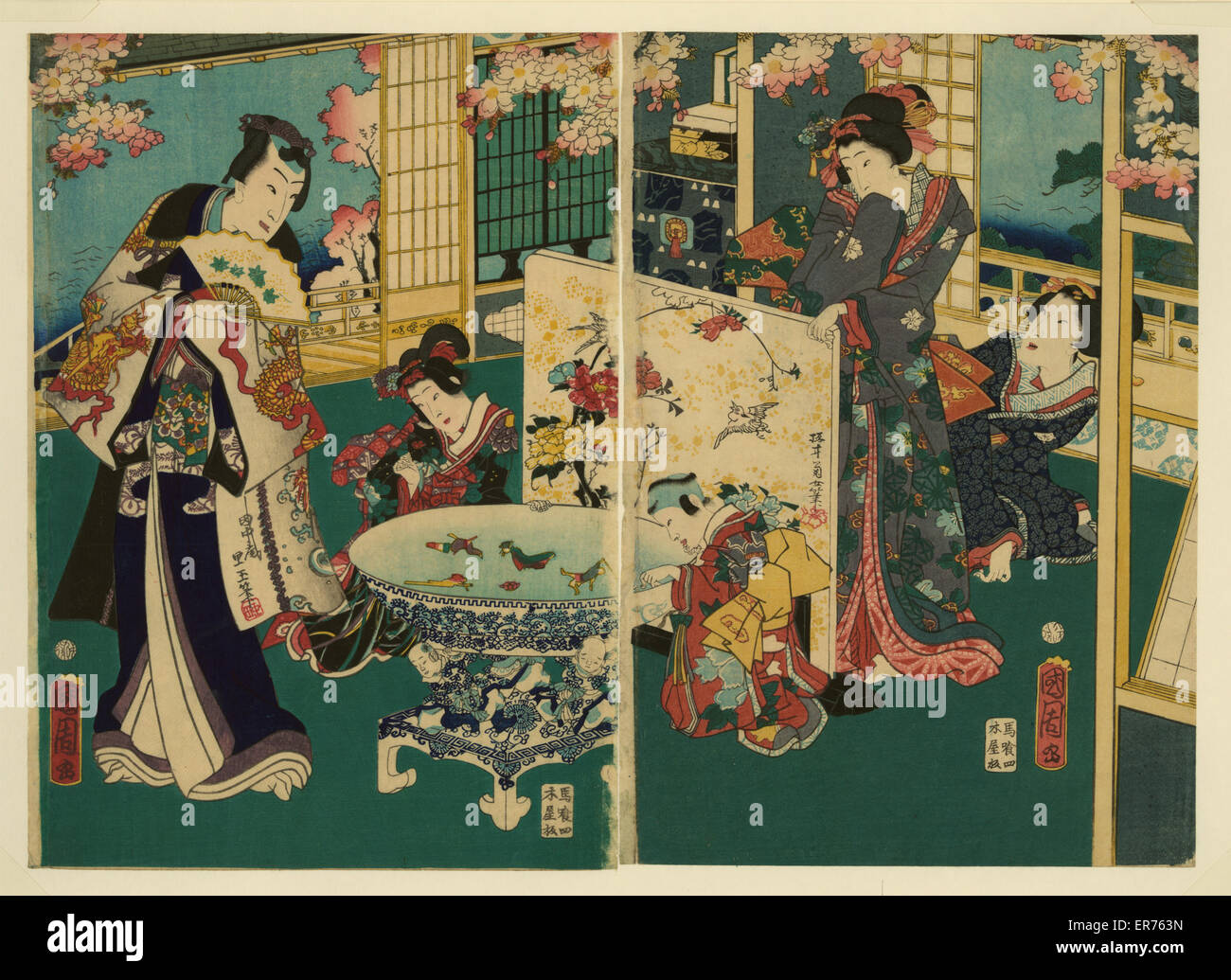 Flower performance. Ukiyo-e diptych showing richly-dressed man, two children, and two women in a richly-appointed interior. Date 1862. Stock Photohttps://www.alamy.com/image-license-details/?v=1https://www.alamy.com/stock-photo-flower-performance-ukiyo-e-diptych-showing-richly-dressed-man-two-83137033.html
Flower performance. Ukiyo-e diptych showing richly-dressed man, two children, and two women in a richly-appointed interior. Date 1862. Stock Photohttps://www.alamy.com/image-license-details/?v=1https://www.alamy.com/stock-photo-flower-performance-ukiyo-e-diptych-showing-richly-dressed-man-two-83137033.htmlRMER763N–Flower performance. Ukiyo-e diptych showing richly-dressed man, two children, and two women in a richly-appointed interior. Date 1862.
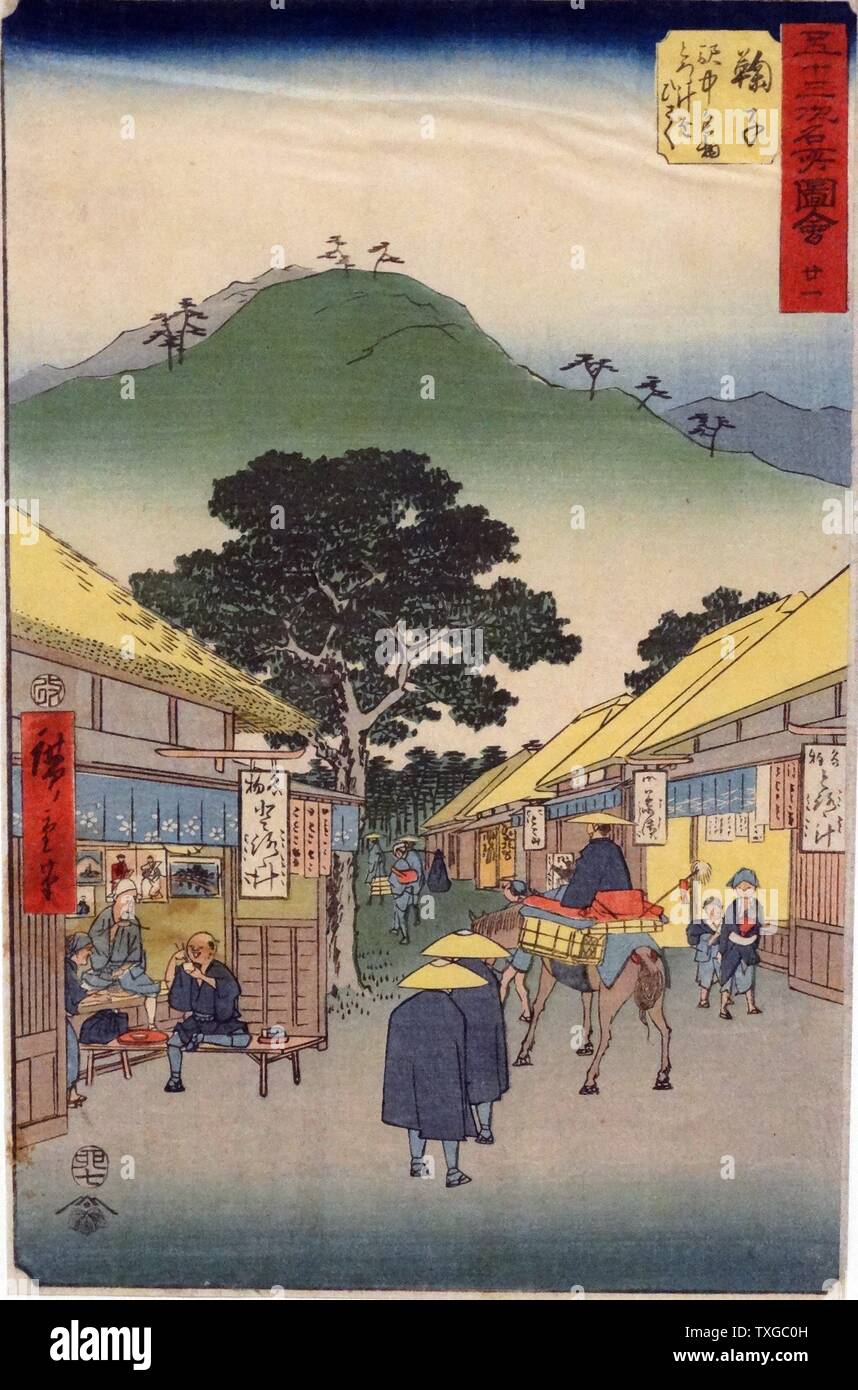 Mariko (T kaid station) And? Hiroshige (1797-1858) Japanese ukiyo-e artist. Dated 1834 Stock Photohttps://www.alamy.com/image-license-details/?v=1https://www.alamy.com/mariko-t-kaid-station-and-hiroshige-1797-1858-japanese-ukiyo-e-artist-dated-1834-image257286865.html
Mariko (T kaid station) And? Hiroshige (1797-1858) Japanese ukiyo-e artist. Dated 1834 Stock Photohttps://www.alamy.com/image-license-details/?v=1https://www.alamy.com/mariko-t-kaid-station-and-hiroshige-1797-1858-japanese-ukiyo-e-artist-dated-1834-image257286865.htmlRMTXGC0H–Mariko (T kaid station) And? Hiroshige (1797-1858) Japanese ukiyo-e artist. Dated 1834
 Archive Hiroshige Utagawa Hiroshige - Seascape in Satta in the Province of Suruga (1858) - Classic Painting Photo Poster Japanese Japan Hokusai Japan Art - Mount Fuji - Hiroshige Artwork Ukiyo-e Japanese Japanese Art Edo Period Mount Fuji Poster Stock Photohttps://www.alamy.com/image-license-details/?v=1https://www.alamy.com/archive-hiroshige-utagawa-hiroshige-seascape-in-satta-in-the-province-of-suruga-1858-classic-painting-photo-poster-japanese-japan-hokusai-japan-art-mount-fuji-hiroshige-artwork-ukiyo-e-japanese-japanese-art-edo-period-mount-fuji-poster-image362678452.html
Archive Hiroshige Utagawa Hiroshige - Seascape in Satta in the Province of Suruga (1858) - Classic Painting Photo Poster Japanese Japan Hokusai Japan Art - Mount Fuji - Hiroshige Artwork Ukiyo-e Japanese Japanese Art Edo Period Mount Fuji Poster Stock Photohttps://www.alamy.com/image-license-details/?v=1https://www.alamy.com/archive-hiroshige-utagawa-hiroshige-seascape-in-satta-in-the-province-of-suruga-1858-classic-painting-photo-poster-japanese-japan-hokusai-japan-art-mount-fuji-hiroshige-artwork-ukiyo-e-japanese-japanese-art-edo-period-mount-fuji-poster-image362678452.htmlRM2C21C1T–Archive Hiroshige Utagawa Hiroshige - Seascape in Satta in the Province of Suruga (1858) - Classic Painting Photo Poster Japanese Japan Hokusai Japan Art - Mount Fuji - Hiroshige Artwork Ukiyo-e Japanese Japanese Art Edo Period Mount Fuji Poster
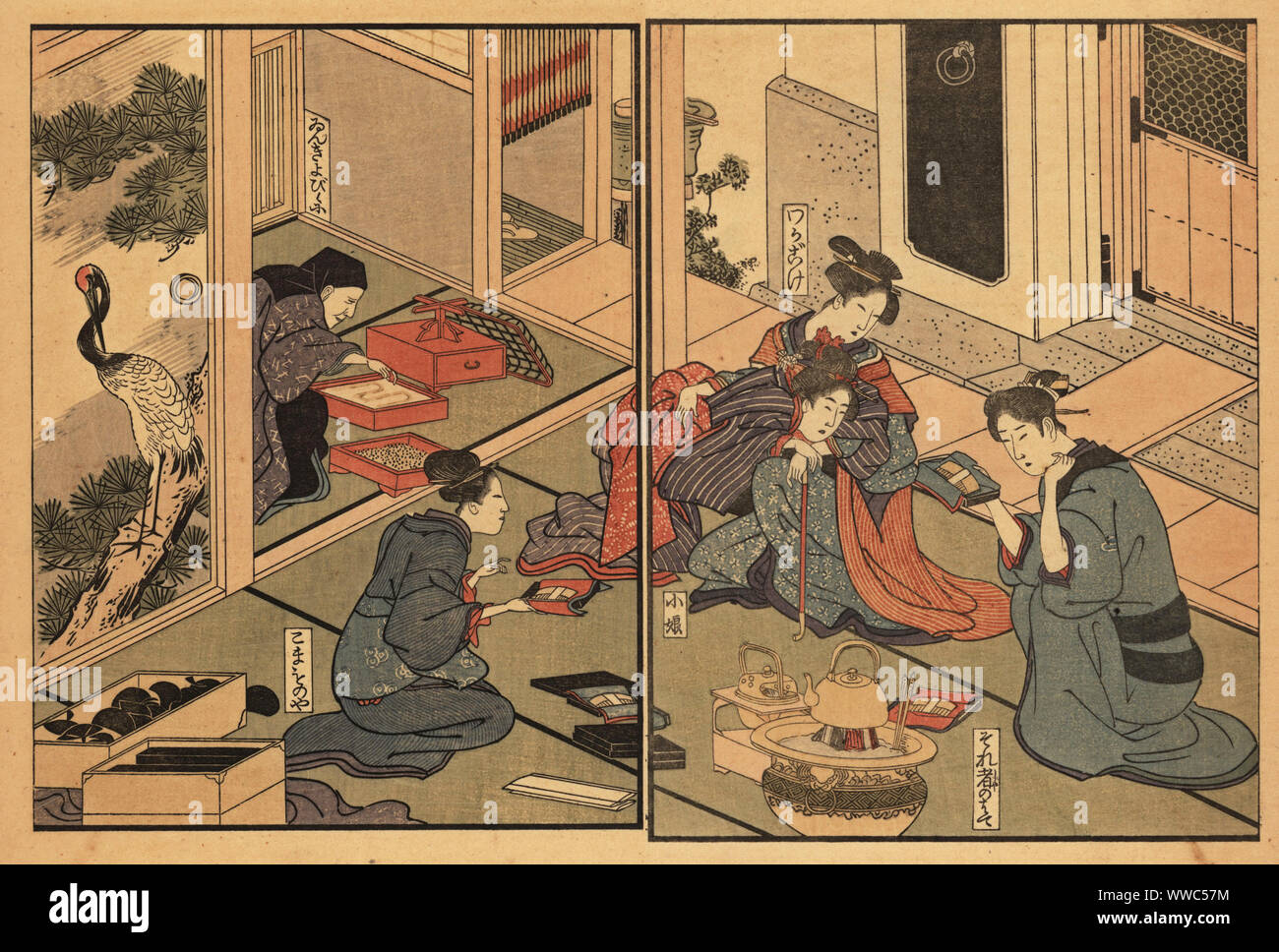 A cosmetics and accessories seller making a house call. The customers are a geisha madam and two young geisha in an okiya. Handcoloured ukiyo-e woodblock print by Toyokuni Utagawa from Shikitei Sanba’s Ehon Imayo Sugata (Picture Book of the Modern Forms and Figures, Tokyo, 1916. Reprint of the original from 1802. Stock Photohttps://www.alamy.com/image-license-details/?v=1https://www.alamy.com/a-cosmetics-and-accessories-seller-making-a-house-call-the-customers-are-a-geisha-madam-and-two-young-geisha-in-an-okiya-handcoloured-ukiyo-e-woodblock-print-by-toyokuni-utagawa-from-shikitei-sanbas-ehon-imayo-sugata-picture-book-of-the-modern-forms-and-figures-tokyo-1916-reprint-of-the-original-from-1802-image273789480.html
A cosmetics and accessories seller making a house call. The customers are a geisha madam and two young geisha in an okiya. Handcoloured ukiyo-e woodblock print by Toyokuni Utagawa from Shikitei Sanba’s Ehon Imayo Sugata (Picture Book of the Modern Forms and Figures, Tokyo, 1916. Reprint of the original from 1802. Stock Photohttps://www.alamy.com/image-license-details/?v=1https://www.alamy.com/a-cosmetics-and-accessories-seller-making-a-house-call-the-customers-are-a-geisha-madam-and-two-young-geisha-in-an-okiya-handcoloured-ukiyo-e-woodblock-print-by-toyokuni-utagawa-from-shikitei-sanbas-ehon-imayo-sugata-picture-book-of-the-modern-forms-and-figures-tokyo-1916-reprint-of-the-original-from-1802-image273789480.htmlRMWWC57M–A cosmetics and accessories seller making a house call. The customers are a geisha madam and two young geisha in an okiya. Handcoloured ukiyo-e woodblock print by Toyokuni Utagawa from Shikitei Sanba’s Ehon Imayo Sugata (Picture Book of the Modern Forms and Figures, Tokyo, 1916. Reprint of the original from 1802.
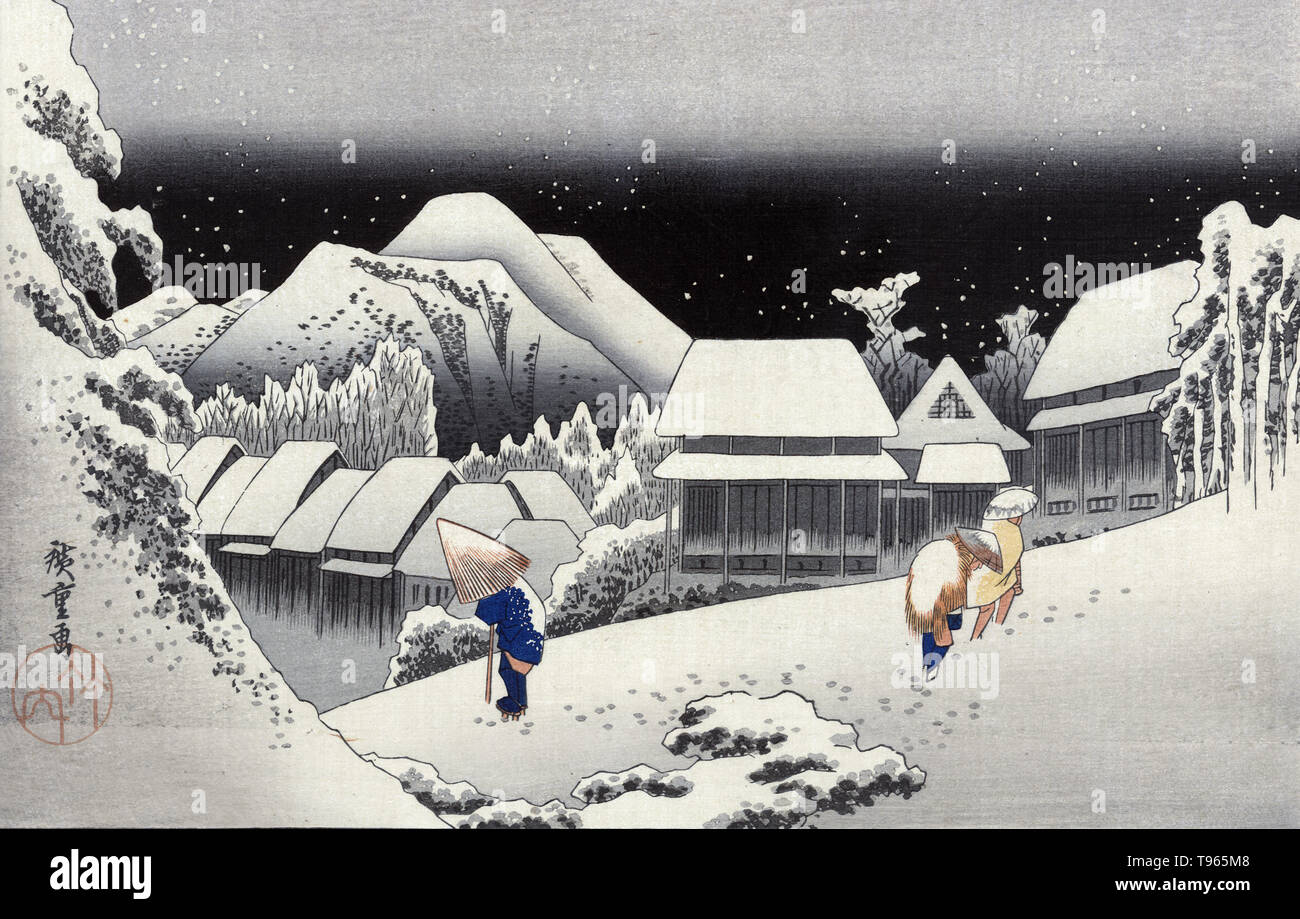 Kanbara. Travelers walking in the snow at night at the Kanbara station on the Tokaido Road. Ukiyo-e (picture of the floating world) is a genre of Japanese art which flourished from the 17th through 19th centuries. Ukiyo-e was central to forming the West's perception of Japanese art in the late 19th century. The landscape genre has come to dominate Western perceptions of ukiyo-e. Stock Photohttps://www.alamy.com/image-license-details/?v=1https://www.alamy.com/kanbara-travelers-walking-in-the-snow-at-night-at-the-kanbara-station-on-the-tokaido-road-ukiyo-e-picture-of-the-floating-world-is-a-genre-of-japanese-art-which-flourished-from-the-17th-through-19th-centuries-ukiyo-e-was-central-to-forming-the-wests-perception-of-japanese-art-in-the-late-19th-century-the-landscape-genre-has-come-to-dominate-western-perceptions-of-ukiyo-e-image246613256.html
Kanbara. Travelers walking in the snow at night at the Kanbara station on the Tokaido Road. Ukiyo-e (picture of the floating world) is a genre of Japanese art which flourished from the 17th through 19th centuries. Ukiyo-e was central to forming the West's perception of Japanese art in the late 19th century. The landscape genre has come to dominate Western perceptions of ukiyo-e. Stock Photohttps://www.alamy.com/image-license-details/?v=1https://www.alamy.com/kanbara-travelers-walking-in-the-snow-at-night-at-the-kanbara-station-on-the-tokaido-road-ukiyo-e-picture-of-the-floating-world-is-a-genre-of-japanese-art-which-flourished-from-the-17th-through-19th-centuries-ukiyo-e-was-central-to-forming-the-wests-perception-of-japanese-art-in-the-late-19th-century-the-landscape-genre-has-come-to-dominate-western-perceptions-of-ukiyo-e-image246613256.htmlRMT965M8–Kanbara. Travelers walking in the snow at night at the Kanbara station on the Tokaido Road. Ukiyo-e (picture of the floating world) is a genre of Japanese art which flourished from the 17th through 19th centuries. Ukiyo-e was central to forming the West's perception of Japanese art in the late 19th century. The landscape genre has come to dominate Western perceptions of ukiyo-e.
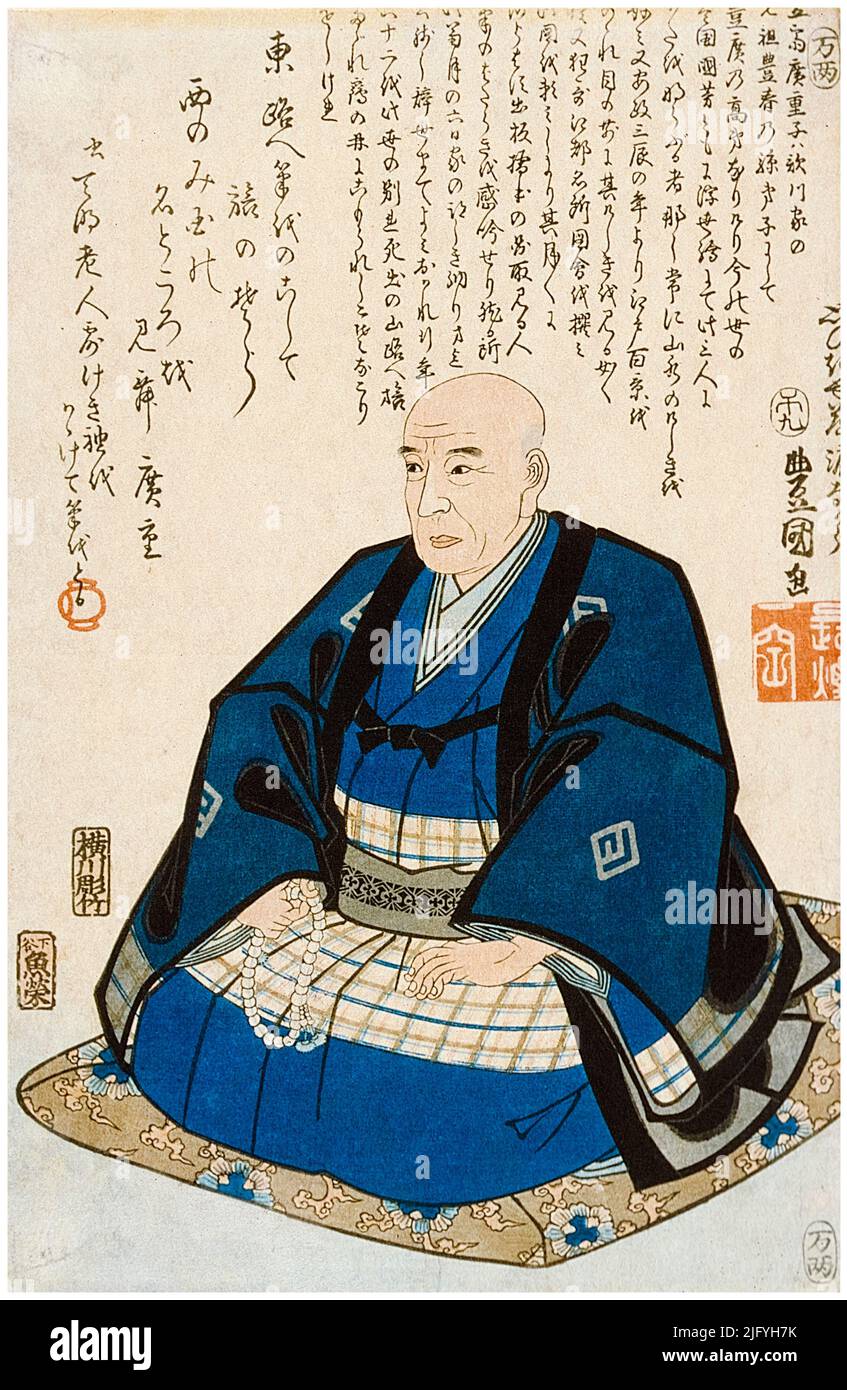 Memorial portrait of Utagawa Hiroshige (1797-1858), Japanese ukiyo-e artist, woodcut print by Utagawa Kunisada, 1858 Stock Photohttps://www.alamy.com/image-license-details/?v=1https://www.alamy.com/memorial-portrait-of-utagawa-hiroshige-1797-1858-japanese-ukiyo-e-artist-woodcut-print-by-utagawa-kunisada-1858-image474506023.html
Memorial portrait of Utagawa Hiroshige (1797-1858), Japanese ukiyo-e artist, woodcut print by Utagawa Kunisada, 1858 Stock Photohttps://www.alamy.com/image-license-details/?v=1https://www.alamy.com/memorial-portrait-of-utagawa-hiroshige-1797-1858-japanese-ukiyo-e-artist-woodcut-print-by-utagawa-kunisada-1858-image474506023.htmlRM2JFYH7K–Memorial portrait of Utagawa Hiroshige (1797-1858), Japanese ukiyo-e artist, woodcut print by Utagawa Kunisada, 1858
 Japan: 'Woman Feeding Child'. Ukiyo-e woodblock print by Kitagawa Utamaro (c. 1753 - 31 October 1806), 18th century. Kitagawa Utamaro was a Japanese printmaker and painter, who is considered one of the greatest artists of woodblock prints (ukiyo-e). He is known especially for his masterfully composed studies of women, known as bijinga. He also produced nature studies, particularly illustrated books of insects. Stock Photohttps://www.alamy.com/image-license-details/?v=1https://www.alamy.com/japan-woman-feeding-child-ukiyo-e-woodblock-print-by-kitagawa-utamaro-c-1753-31-october-1806-18th-century-kitagawa-utamaro-was-a-japanese-printmaker-and-painter-who-is-considered-one-of-the-greatest-artists-of-woodblock-prints-ukiyo-e-he-is-known-especially-for-his-masterfully-composed-studies-of-women-known-as-bijinga-he-also-produced-nature-studies-particularly-illustrated-books-of-insects-image344234844.html
Japan: 'Woman Feeding Child'. Ukiyo-e woodblock print by Kitagawa Utamaro (c. 1753 - 31 October 1806), 18th century. Kitagawa Utamaro was a Japanese printmaker and painter, who is considered one of the greatest artists of woodblock prints (ukiyo-e). He is known especially for his masterfully composed studies of women, known as bijinga. He also produced nature studies, particularly illustrated books of insects. Stock Photohttps://www.alamy.com/image-license-details/?v=1https://www.alamy.com/japan-woman-feeding-child-ukiyo-e-woodblock-print-by-kitagawa-utamaro-c-1753-31-october-1806-18th-century-kitagawa-utamaro-was-a-japanese-printmaker-and-painter-who-is-considered-one-of-the-greatest-artists-of-woodblock-prints-ukiyo-e-he-is-known-especially-for-his-masterfully-composed-studies-of-women-known-as-bijinga-he-also-produced-nature-studies-particularly-illustrated-books-of-insects-image344234844.htmlRM2B0171G–Japan: 'Woman Feeding Child'. Ukiyo-e woodblock print by Kitagawa Utamaro (c. 1753 - 31 October 1806), 18th century. Kitagawa Utamaro was a Japanese printmaker and painter, who is considered one of the greatest artists of woodblock prints (ukiyo-e). He is known especially for his masterfully composed studies of women, known as bijinga. He also produced nature studies, particularly illustrated books of insects.
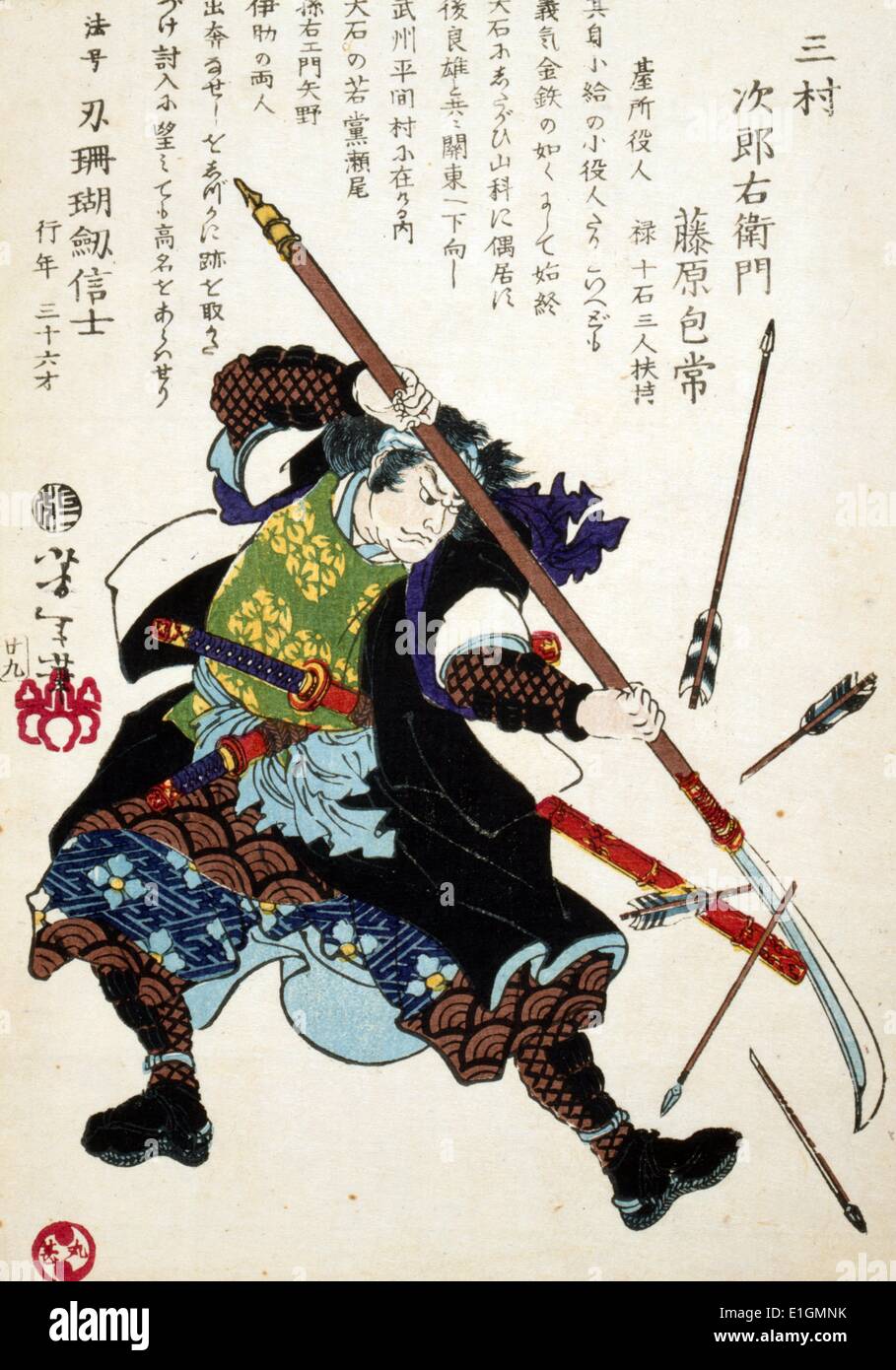 Ukiyo-e print illustration showing Ronin deflecting arrows with a long-handled sword. Dated 1869 Stock Photohttps://www.alamy.com/image-license-details/?v=1https://www.alamy.com/ukiyo-e-print-illustration-showing-ronin-deflecting-arrows-with-a-image69823647.html
Ukiyo-e print illustration showing Ronin deflecting arrows with a long-handled sword. Dated 1869 Stock Photohttps://www.alamy.com/image-license-details/?v=1https://www.alamy.com/ukiyo-e-print-illustration-showing-ronin-deflecting-arrows-with-a-image69823647.htmlRME1GMNK–Ukiyo-e print illustration showing Ronin deflecting arrows with a long-handled sword. Dated 1869
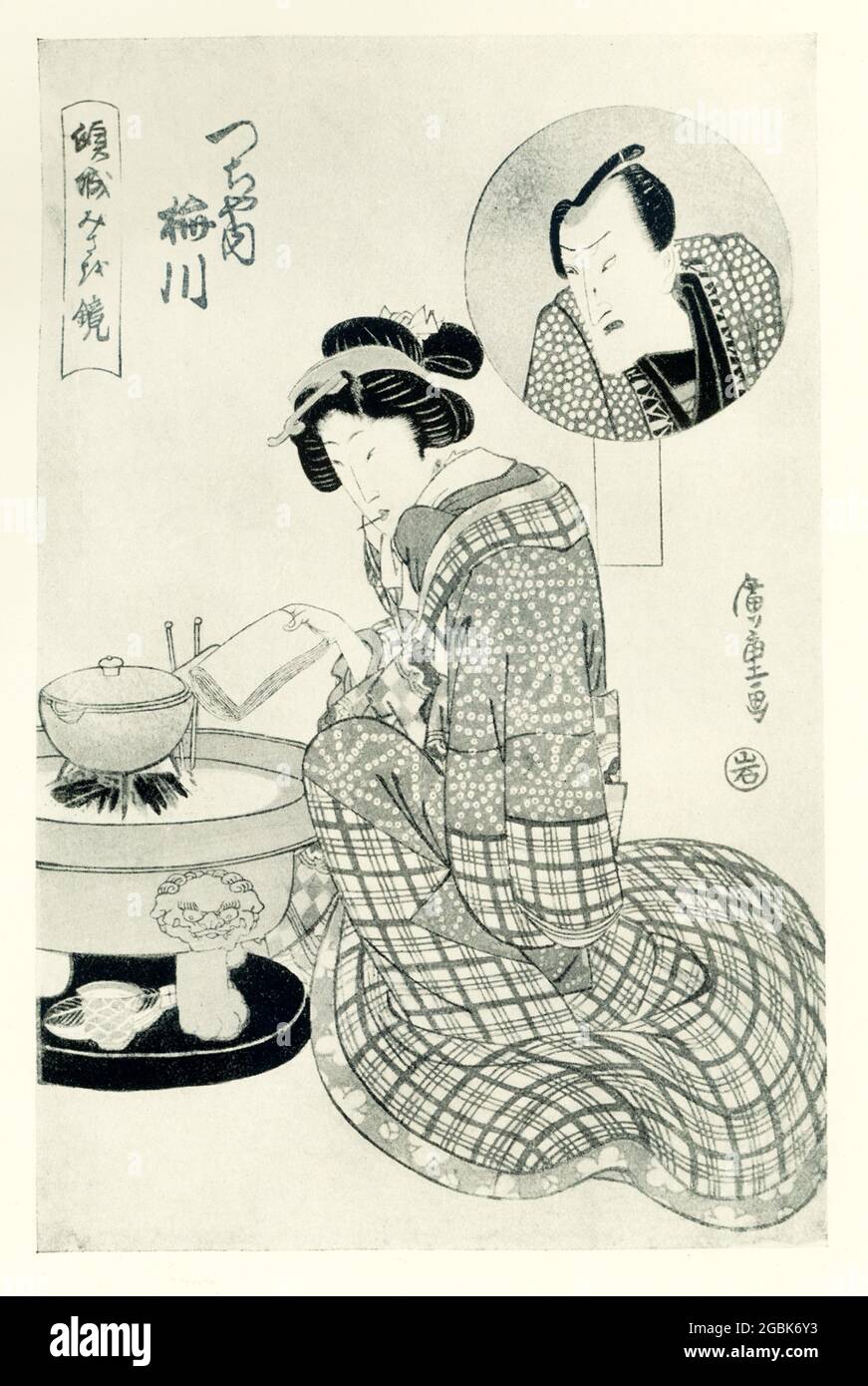 The 1920 caption reads: Umegawa of Tsuchi-ya. The inset in circle is her lover as an actor. It is one of a series 'A Mirror of faithful courtesans' that was signed by Hiroshige. The publisher is Iwato-ya. Umegawa of Tsuchi-ya was a courtesan .Utagawa Hiroshige, born Andō Hiroshige, was a Japanese ukiyo-e artist, considered the last great master of that tradition. Stock Photohttps://www.alamy.com/image-license-details/?v=1https://www.alamy.com/the-1920-caption-reads-umegawa-of-tsuchi-ya-the-inset-in-circle-is-her-lover-as-an-actor-it-is-one-of-a-series-a-mirror-of-faithful-courtesans-that-was-signed-by-hiroshige-the-publisher-is-iwato-ya-umegawa-of-tsuchi-ya-was-a-courtesan-utagawa-hiroshige-born-and-hiroshige-was-a-japanese-ukiyo-e-artist-considered-the-last-great-master-of-that-tradition-image437442967.html
The 1920 caption reads: Umegawa of Tsuchi-ya. The inset in circle is her lover as an actor. It is one of a series 'A Mirror of faithful courtesans' that was signed by Hiroshige. The publisher is Iwato-ya. Umegawa of Tsuchi-ya was a courtesan .Utagawa Hiroshige, born Andō Hiroshige, was a Japanese ukiyo-e artist, considered the last great master of that tradition. Stock Photohttps://www.alamy.com/image-license-details/?v=1https://www.alamy.com/the-1920-caption-reads-umegawa-of-tsuchi-ya-the-inset-in-circle-is-her-lover-as-an-actor-it-is-one-of-a-series-a-mirror-of-faithful-courtesans-that-was-signed-by-hiroshige-the-publisher-is-iwato-ya-umegawa-of-tsuchi-ya-was-a-courtesan-utagawa-hiroshige-born-and-hiroshige-was-a-japanese-ukiyo-e-artist-considered-the-last-great-master-of-that-tradition-image437442967.htmlRF2GBK6Y3–The 1920 caption reads: Umegawa of Tsuchi-ya. The inset in circle is her lover as an actor. It is one of a series 'A Mirror of faithful courtesans' that was signed by Hiroshige. The publisher is Iwato-ya. Umegawa of Tsuchi-ya was a courtesan .Utagawa Hiroshige, born Andō Hiroshige, was a Japanese ukiyo-e artist, considered the last great master of that tradition.
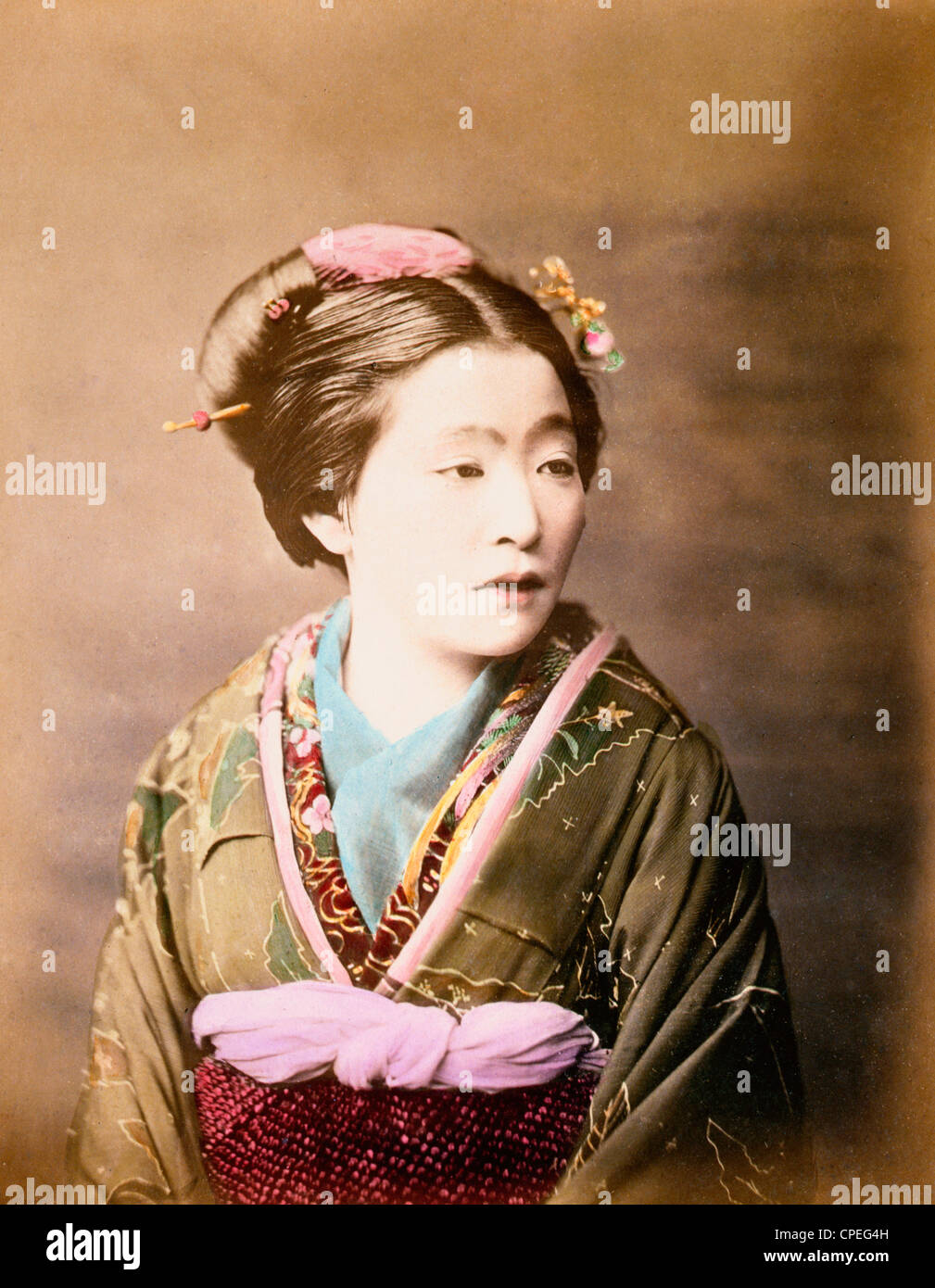 Ukiyo-e beauty, half-length studio portrait of a woman, facing slightly right, Japan woodblock print, circa 1877 Stock Photohttps://www.alamy.com/image-license-details/?v=1https://www.alamy.com/stock-photo-ukiyo-e-beauty-half-length-studio-portrait-of-a-woman-facing-slightly-48263169.html
Ukiyo-e beauty, half-length studio portrait of a woman, facing slightly right, Japan woodblock print, circa 1877 Stock Photohttps://www.alamy.com/image-license-details/?v=1https://www.alamy.com/stock-photo-ukiyo-e-beauty-half-length-studio-portrait-of-a-woman-facing-slightly-48263169.htmlRMCPEG4H–Ukiyo-e beauty, half-length studio portrait of a woman, facing slightly right, Japan woodblock print, circa 1877
 Ukiyo-e historic painting, Japan Stock Photohttps://www.alamy.com/image-license-details/?v=1https://www.alamy.com/ukiyo-e-historic-painting-japan-image69249862.html
Ukiyo-e historic painting, Japan Stock Photohttps://www.alamy.com/image-license-details/?v=1https://www.alamy.com/ukiyo-e-historic-painting-japan-image69249862.htmlRME0JGWA–Ukiyo-e historic painting, Japan
 Ukiyo-e print - Ichikawa Danjuro IV, c1780-1825. Artist: Utagawa Toyokuni. Stock Photohttps://www.alamy.com/image-license-details/?v=1https://www.alamy.com/ukiyo-e-print-ichikawa-danjuro-iv-c1780-1825-artist-utagawa-toyokuni-image186168682.html
Ukiyo-e print - Ichikawa Danjuro IV, c1780-1825. Artist: Utagawa Toyokuni. Stock Photohttps://www.alamy.com/image-license-details/?v=1https://www.alamy.com/ukiyo-e-print-ichikawa-danjuro-iv-c1780-1825-artist-utagawa-toyokuni-image186168682.htmlRMMPTM1E–Ukiyo-e print - Ichikawa Danjuro IV, c1780-1825. Artist: Utagawa Toyokuni.
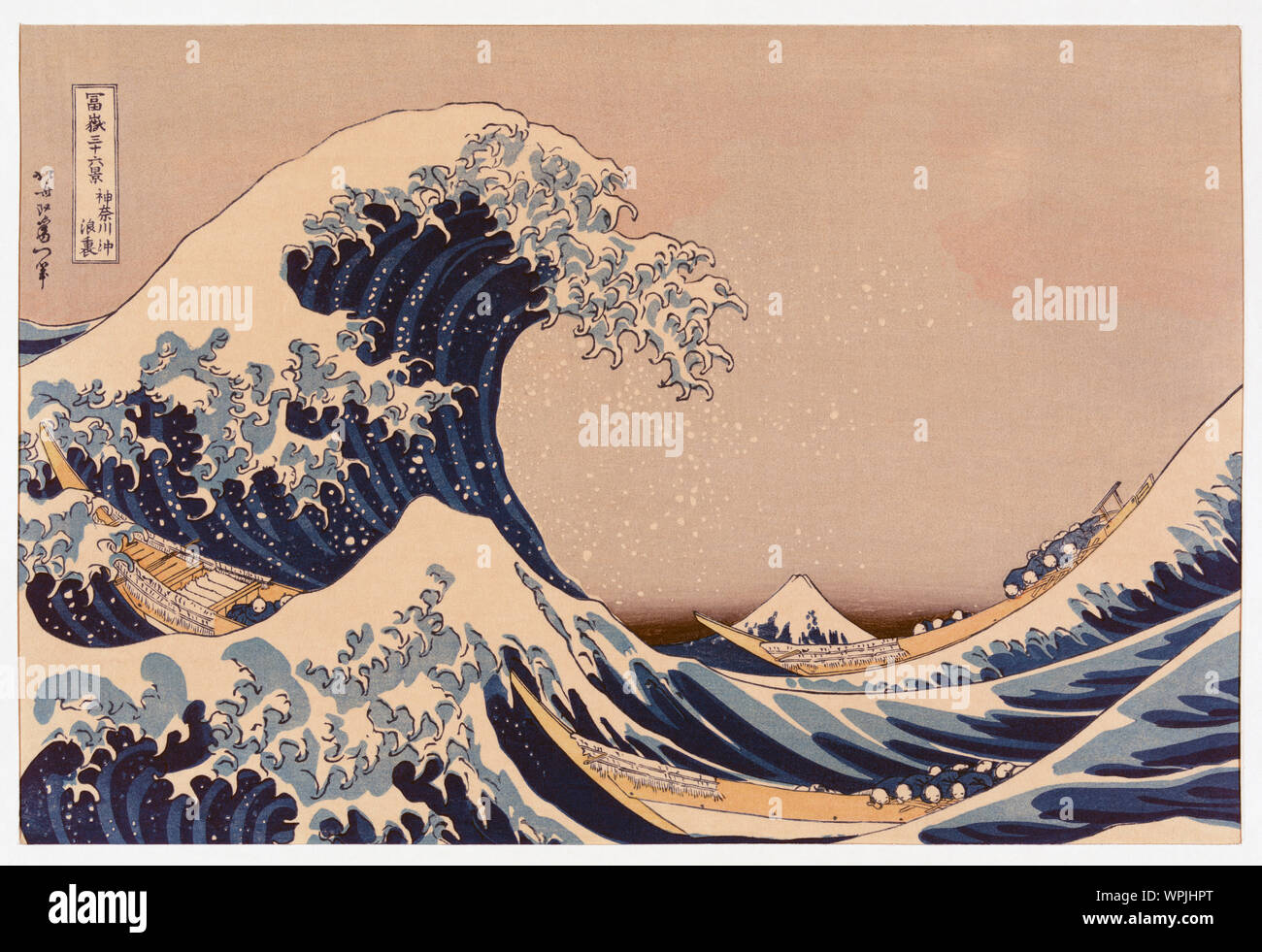 The Great Wave off Kanagawa also known as The Great Wave or simply The Wave, after a woodblock print by the Japanese ukiyo-e artist Katsushika Hokusai, 1760 - 1849. The Great Wave off Kanagawa has become the best known of a print series known as Thirty-six View of Mount Fuji created by Hokusai in the early 1830’s. Stock Photohttps://www.alamy.com/image-license-details/?v=1https://www.alamy.com/the-great-wave-off-kanagawa-also-known-as-the-great-wave-or-simply-the-wave-after-a-woodblock-print-by-the-japanese-ukiyo-e-artist-katsushika-hokusai-1760-1849-the-great-wave-off-kanagawa-has-become-the-best-known-of-a-print-series-known-as-thirty-six-view-of-mount-fuji-created-by-hokusai-in-the-early-1830s-image272087056.html
The Great Wave off Kanagawa also known as The Great Wave or simply The Wave, after a woodblock print by the Japanese ukiyo-e artist Katsushika Hokusai, 1760 - 1849. The Great Wave off Kanagawa has become the best known of a print series known as Thirty-six View of Mount Fuji created by Hokusai in the early 1830’s. Stock Photohttps://www.alamy.com/image-license-details/?v=1https://www.alamy.com/the-great-wave-off-kanagawa-also-known-as-the-great-wave-or-simply-the-wave-after-a-woodblock-print-by-the-japanese-ukiyo-e-artist-katsushika-hokusai-1760-1849-the-great-wave-off-kanagawa-has-become-the-best-known-of-a-print-series-known-as-thirty-six-view-of-mount-fuji-created-by-hokusai-in-the-early-1830s-image272087056.htmlRMWPJHPT–The Great Wave off Kanagawa also known as The Great Wave or simply The Wave, after a woodblock print by the Japanese ukiyo-e artist Katsushika Hokusai, 1760 - 1849. The Great Wave off Kanagawa has become the best known of a print series known as Thirty-six View of Mount Fuji created by Hokusai in the early 1830’s.
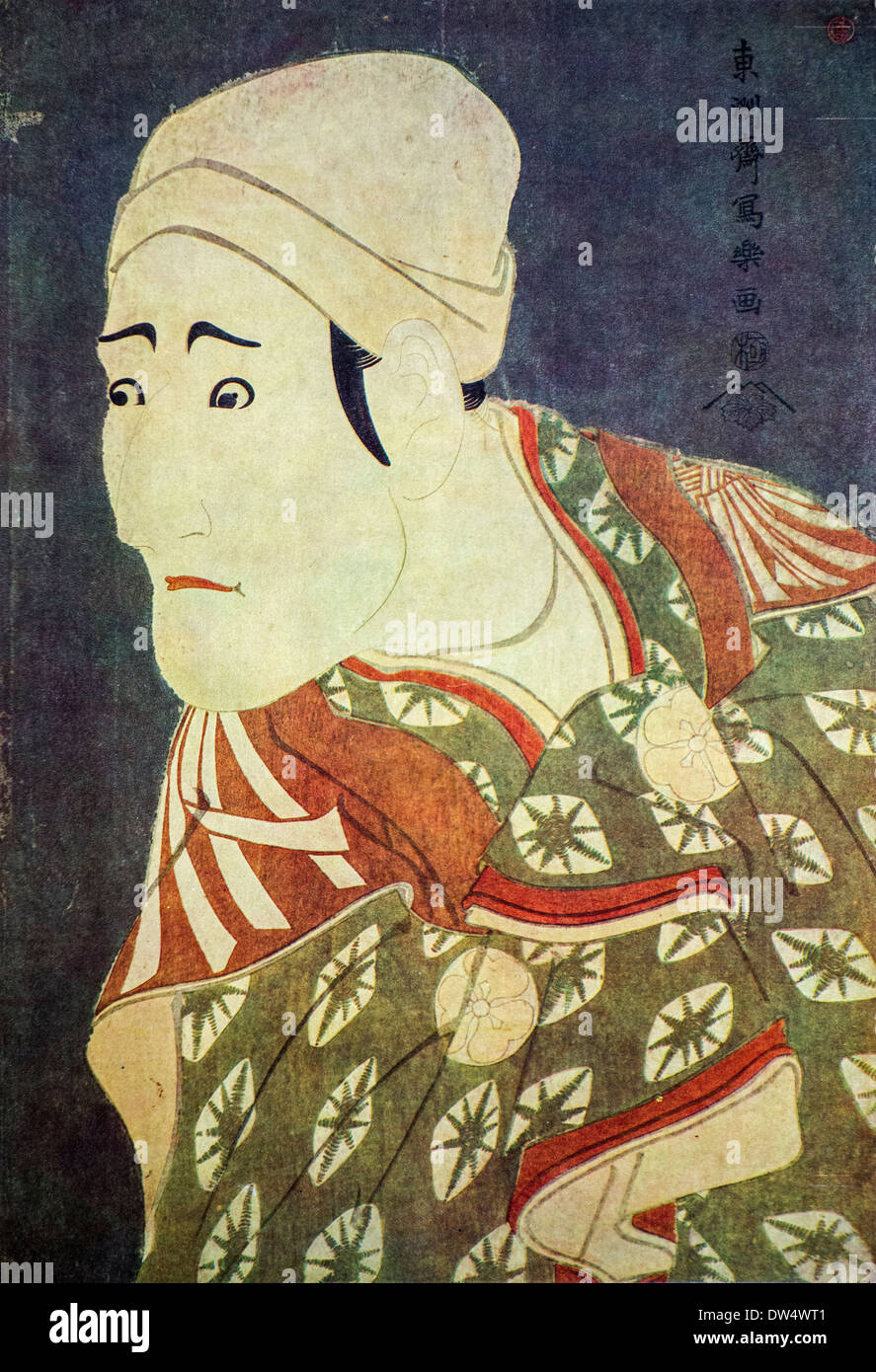 Ukiyo-e woodblock print of the actor Morita Kanya in the role of Ronin by Japanese artist Tōshūsai Sharaku, Japan Stock Photohttps://www.alamy.com/image-license-details/?v=1https://www.alamy.com/ukiyo-e-woodblock-print-of-the-actor-morita-kanya-in-the-role-of-ronin-image67105585.html
Ukiyo-e woodblock print of the actor Morita Kanya in the role of Ronin by Japanese artist Tōshūsai Sharaku, Japan Stock Photohttps://www.alamy.com/image-license-details/?v=1https://www.alamy.com/ukiyo-e-woodblock-print-of-the-actor-morita-kanya-in-the-role-of-ronin-image67105585.htmlRMDW4WT1–Ukiyo-e woodblock print of the actor Morita Kanya in the role of Ronin by Japanese artist Tōshūsai Sharaku, Japan
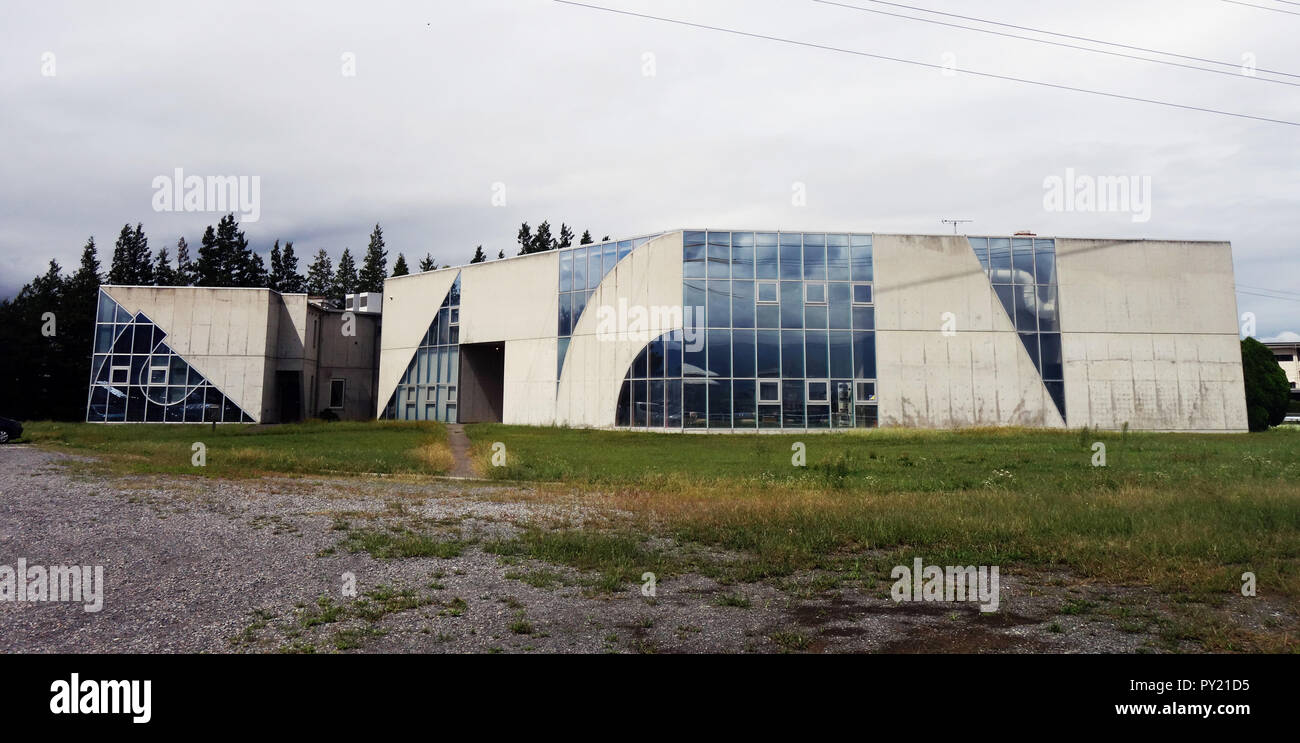 Japan Ukiyo-e Museum, Matsumoto, Japan. No PR Stock Photohttps://www.alamy.com/image-license-details/?v=1https://www.alamy.com/japan-ukiyo-e-museum-matsumoto-japan-no-pr-image223165185.html
Japan Ukiyo-e Museum, Matsumoto, Japan. No PR Stock Photohttps://www.alamy.com/image-license-details/?v=1https://www.alamy.com/japan-ukiyo-e-museum-matsumoto-japan-no-pr-image223165185.htmlRMPY21D5–Japan Ukiyo-e Museum, Matsumoto, Japan. No PR
 Ukiyo-e Triptych: Steam Train at Takanawa Seashore by Utagawa Yoshitora Stock Photohttps://www.alamy.com/image-license-details/?v=1https://www.alamy.com/stock-photo-ukiyo-e-triptych-steam-train-at-takanawa-seashore-by-utagawa-yoshitora-38218268.html
Ukiyo-e Triptych: Steam Train at Takanawa Seashore by Utagawa Yoshitora Stock Photohttps://www.alamy.com/image-license-details/?v=1https://www.alamy.com/stock-photo-ukiyo-e-triptych-steam-train-at-takanawa-seashore-by-utagawa-yoshitora-38218268.htmlRFC64YP4–Ukiyo-e Triptych: Steam Train at Takanawa Seashore by Utagawa Yoshitora
 Japan, Tokyo, Asakusa, Ukiyo-e Style Artwork on Shop Shutters Stock Photohttps://www.alamy.com/image-license-details/?v=1https://www.alamy.com/stock-photo-japan-tokyo-asakusa-ukiyo-e-style-artwork-on-shop-shutters-39613077.html
Japan, Tokyo, Asakusa, Ukiyo-e Style Artwork on Shop Shutters Stock Photohttps://www.alamy.com/image-license-details/?v=1https://www.alamy.com/stock-photo-japan-tokyo-asakusa-ukiyo-e-style-artwork-on-shop-shutters-39613077.htmlRMC8CETN–Japan, Tokyo, Asakusa, Ukiyo-e Style Artwork on Shop Shutters
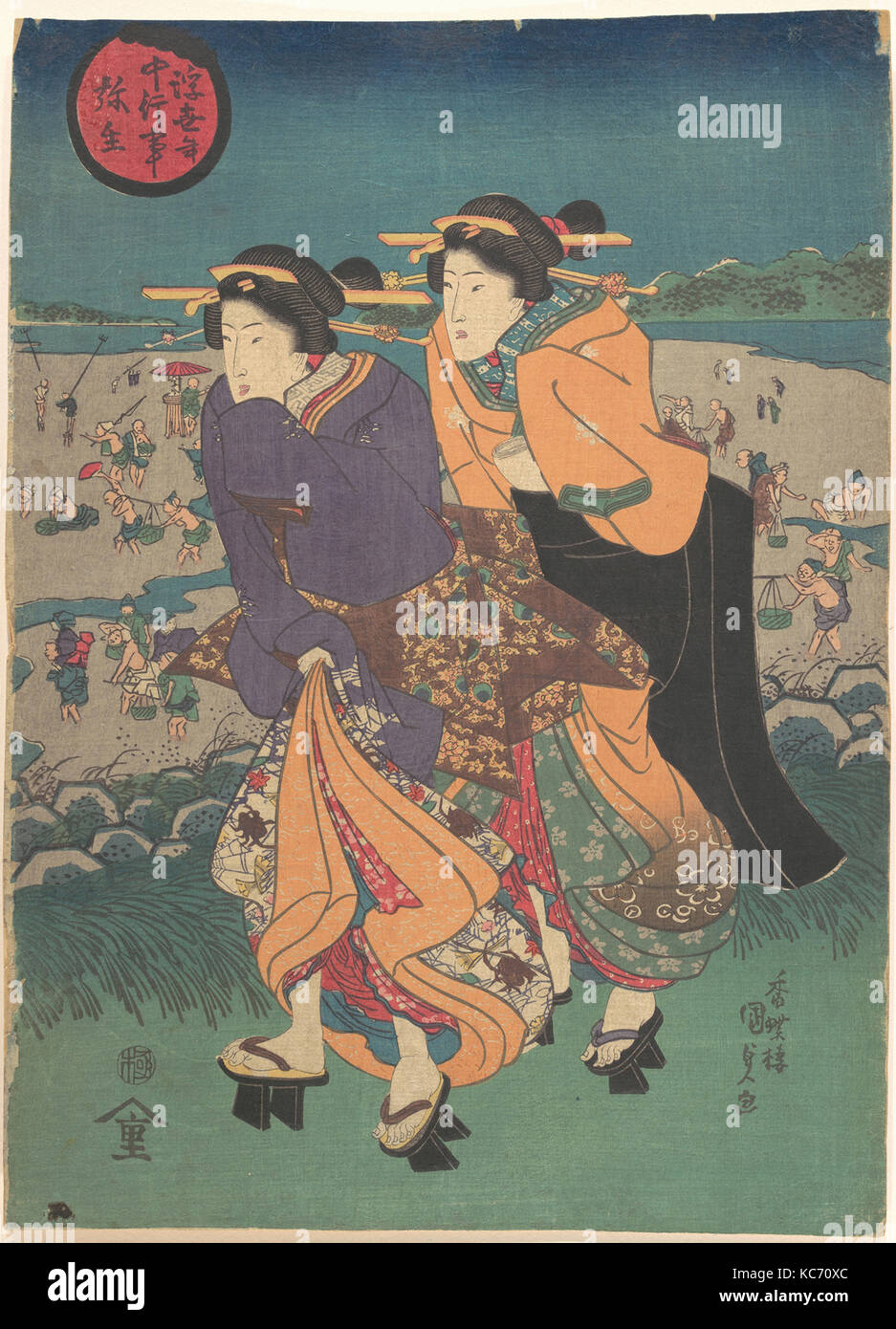 Annual event - the third month (Ukiyo nenjū gyōji: Yayoi), Utagawa Kunisada, mid-19th century Stock Photohttps://www.alamy.com/image-license-details/?v=1https://www.alamy.com/stock-image-annual-event-the-third-month-ukiyo-nenj-gyji-yayoi-utagawa-kunisada-162423588.html
Annual event - the third month (Ukiyo nenjū gyōji: Yayoi), Utagawa Kunisada, mid-19th century Stock Photohttps://www.alamy.com/image-license-details/?v=1https://www.alamy.com/stock-image-annual-event-the-third-month-ukiyo-nenj-gyji-yayoi-utagawa-kunisada-162423588.htmlRMKC70XC–Annual event - the third month (Ukiyo nenjū gyōji: Yayoi), Utagawa Kunisada, mid-19th century
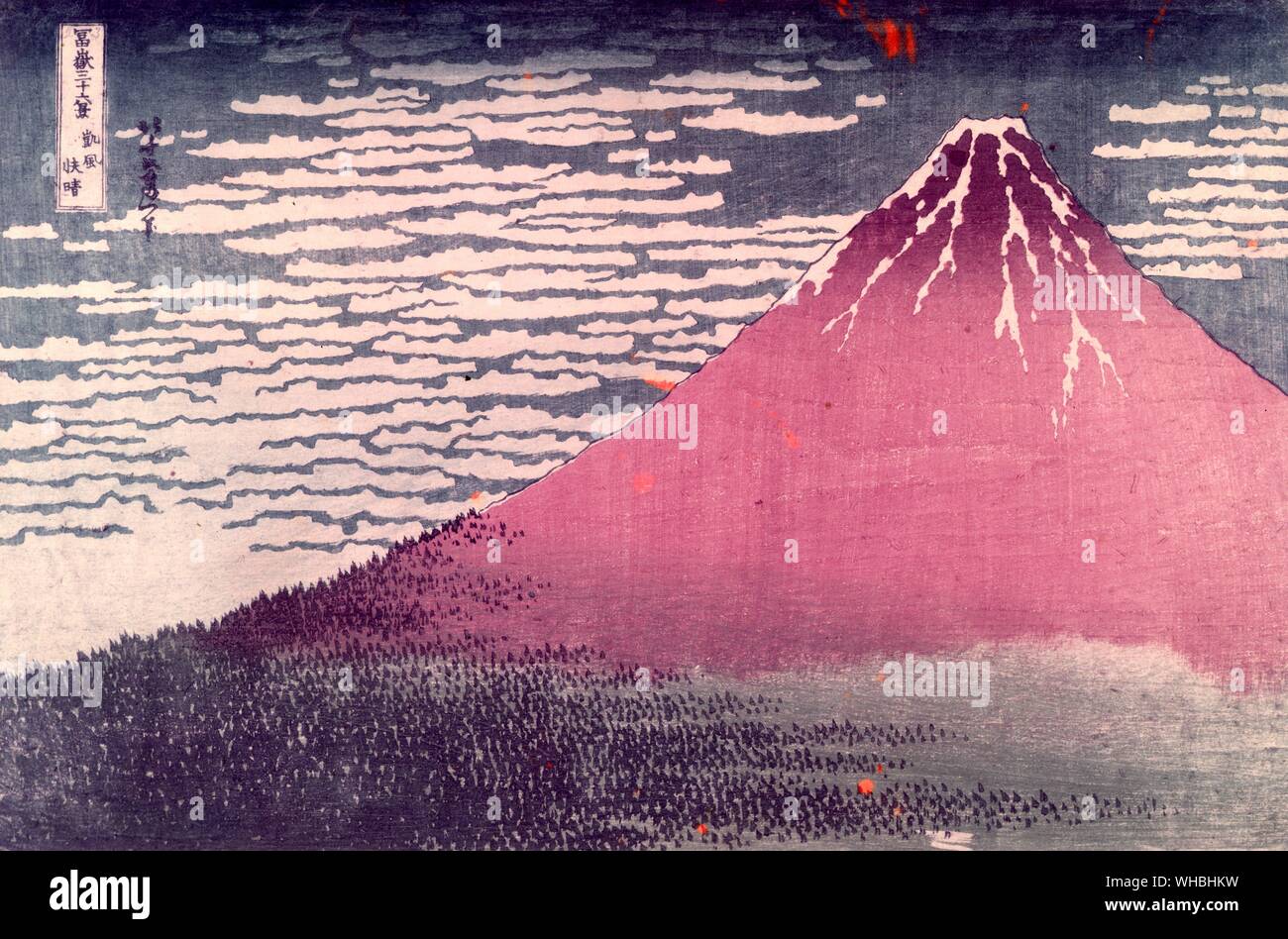 Katsushika Hokusai : 1760 - 10 May 1849 Japanese artist , ukiyo-e painter and printmaker of the Edo period , seen here Mount Fuji in Clear Weather Stock Photohttps://www.alamy.com/image-license-details/?v=1https://www.alamy.com/katsushika-hokusai-1760-10-may-1849-japanese-artist-ukiyo-e-painter-and-printmaker-of-the-edo-period-seen-here-mount-fuji-in-clear-weather-image268860029.html
Katsushika Hokusai : 1760 - 10 May 1849 Japanese artist , ukiyo-e painter and printmaker of the Edo period , seen here Mount Fuji in Clear Weather Stock Photohttps://www.alamy.com/image-license-details/?v=1https://www.alamy.com/katsushika-hokusai-1760-10-may-1849-japanese-artist-ukiyo-e-painter-and-printmaker-of-the-edo-period-seen-here-mount-fuji-in-clear-weather-image268860029.htmlRMWHBHKW–Katsushika Hokusai : 1760 - 10 May 1849 Japanese artist , ukiyo-e painter and printmaker of the Edo period , seen here Mount Fuji in Clear Weather
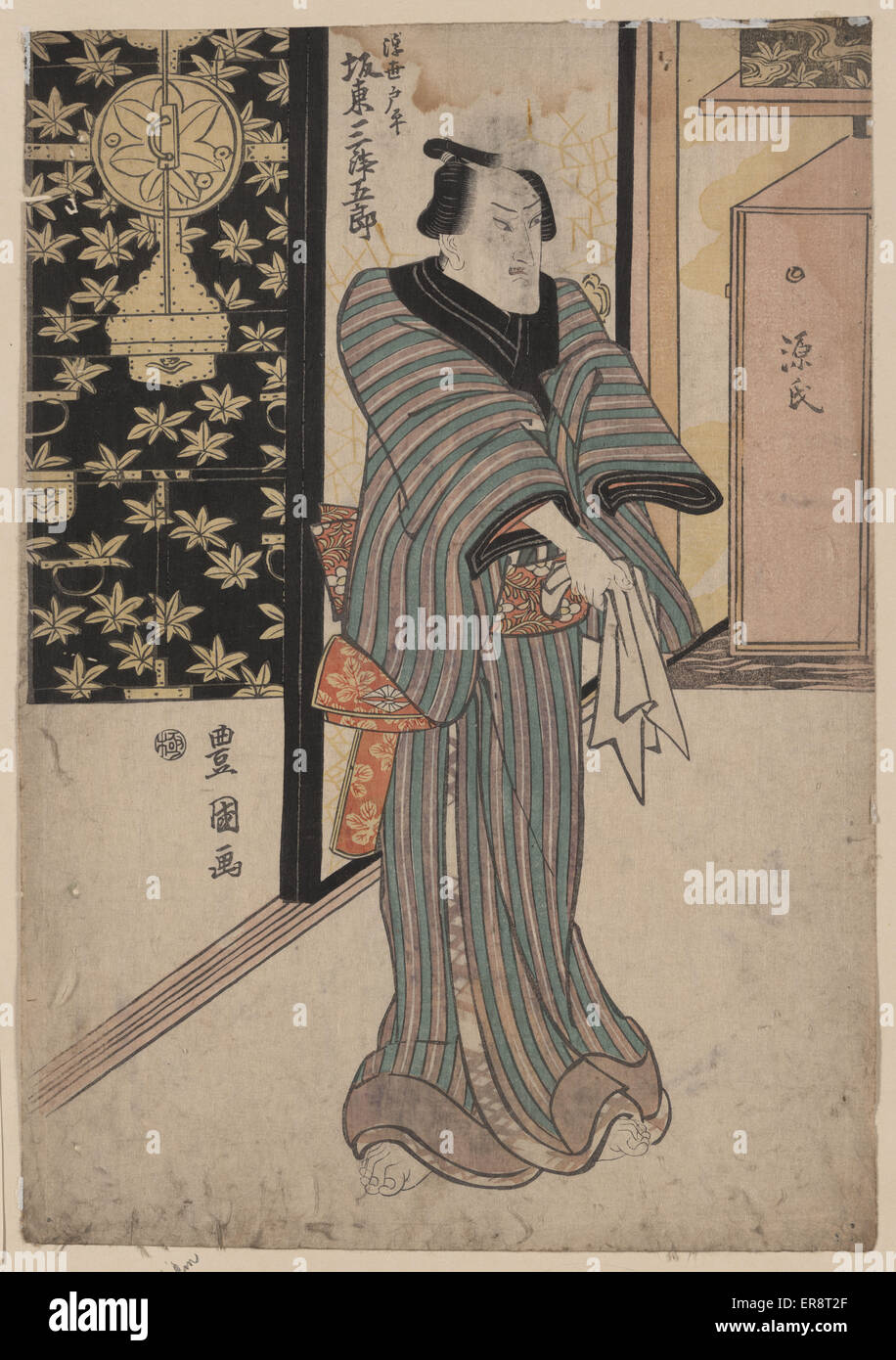 The actor Bando Mitsugoro in the role of Ukiyo Tohei Stock Photohttps://www.alamy.com/image-license-details/?v=1https://www.alamy.com/stock-photo-the-actor-bando-mitsugoro-in-the-role-of-ukiyo-tohei-83173063.html
The actor Bando Mitsugoro in the role of Ukiyo Tohei Stock Photohttps://www.alamy.com/image-license-details/?v=1https://www.alamy.com/stock-photo-the-actor-bando-mitsugoro-in-the-role-of-ukiyo-tohei-83173063.htmlRMER8T2F–The actor Bando Mitsugoro in the role of Ukiyo Tohei
 Theatre scene by Ishikawa Toyonobu (1711 - 1785) a Japanese ukiyo-e print artist. Stock Photohttps://www.alamy.com/image-license-details/?v=1https://www.alamy.com/theatre-scene-by-ishikawa-toyonobu-1711-1785-a-japanese-ukiyo-e-print-artist-image330678836.html
Theatre scene by Ishikawa Toyonobu (1711 - 1785) a Japanese ukiyo-e print artist. Stock Photohttps://www.alamy.com/image-license-details/?v=1https://www.alamy.com/theatre-scene-by-ishikawa-toyonobu-1711-1785-a-japanese-ukiyo-e-print-artist-image330678836.htmlRM2A5YM6C–Theatre scene by Ishikawa Toyonobu (1711 - 1785) a Japanese ukiyo-e print artist.
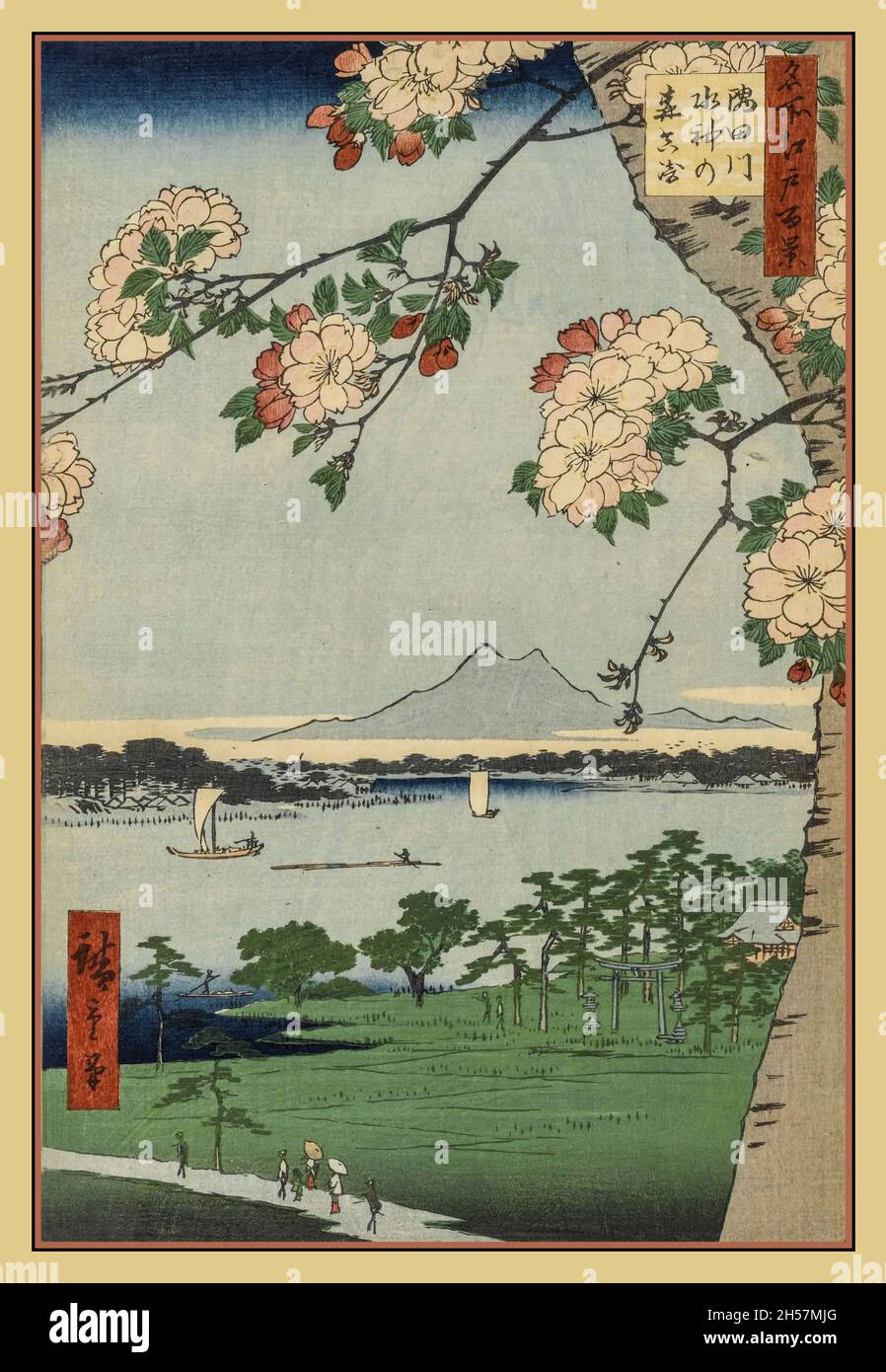 HIROSHIGE UKIYO-E ARTIST 100 Famous views of Edo by Hiroshige Suijin Shrine and Massaki on the Sumida River. People at the bottom of the print are on the way to the Hashiba ferry Utagawa Hiroshige, born Andō Hiroshige, was a Japanese ukiyo-e artist, considered the last great master of that tradition. Hiroshige is best known for his vertical-format landscape series One Hundred Famous Views of Edo. Suijin Shrine and Massaki on the Sumida River is number 35 of the 118 woodblock prints constituting Hiroshige's series One Hundred Famous Views of Edo. Stock Photohttps://www.alamy.com/image-license-details/?v=1https://www.alamy.com/hiroshige-ukiyo-e-artist-100-famous-views-of-edo-by-hiroshige-suijin-shrine-and-massaki-on-the-sumida-river-people-at-the-bottom-of-the-print-are-on-the-way-to-the-hashiba-ferry-utagawa-hiroshige-born-and-hiroshige-was-a-japanese-ukiyo-e-artist-considered-the-last-great-master-of-that-tradition-hiroshige-is-best-known-for-his-vertical-format-landscape-series-one-hundred-famous-views-of-edo-suijin-shrine-and-massaki-on-the-sumida-river-is-number-35-of-the-118-woodblock-prints-constituting-hiroshiges-series-one-hundred-famous-views-of-edo-image450712712.html
HIROSHIGE UKIYO-E ARTIST 100 Famous views of Edo by Hiroshige Suijin Shrine and Massaki on the Sumida River. People at the bottom of the print are on the way to the Hashiba ferry Utagawa Hiroshige, born Andō Hiroshige, was a Japanese ukiyo-e artist, considered the last great master of that tradition. Hiroshige is best known for his vertical-format landscape series One Hundred Famous Views of Edo. Suijin Shrine and Massaki on the Sumida River is number 35 of the 118 woodblock prints constituting Hiroshige's series One Hundred Famous Views of Edo. Stock Photohttps://www.alamy.com/image-license-details/?v=1https://www.alamy.com/hiroshige-ukiyo-e-artist-100-famous-views-of-edo-by-hiroshige-suijin-shrine-and-massaki-on-the-sumida-river-people-at-the-bottom-of-the-print-are-on-the-way-to-the-hashiba-ferry-utagawa-hiroshige-born-and-hiroshige-was-a-japanese-ukiyo-e-artist-considered-the-last-great-master-of-that-tradition-hiroshige-is-best-known-for-his-vertical-format-landscape-series-one-hundred-famous-views-of-edo-suijin-shrine-and-massaki-on-the-sumida-river-is-number-35-of-the-118-woodblock-prints-constituting-hiroshiges-series-one-hundred-famous-views-of-edo-image450712712.htmlRM2H57MJG–HIROSHIGE UKIYO-E ARTIST 100 Famous views of Edo by Hiroshige Suijin Shrine and Massaki on the Sumida River. People at the bottom of the print are on the way to the Hashiba ferry Utagawa Hiroshige, born Andō Hiroshige, was a Japanese ukiyo-e artist, considered the last great master of that tradition. Hiroshige is best known for his vertical-format landscape series One Hundred Famous Views of Edo. Suijin Shrine and Massaki on the Sumida River is number 35 of the 118 woodblock prints constituting Hiroshige's series One Hundred Famous Views of Edo.
 Puppet in kimono being manipulated by two bunraku puppeteers in black robes. Woodblock ukiyo-e print by Utagawa Kunisada II, Tokyo, 1850s. From a series of illustrations of popular bunraku plays, this showing the Yaoya Oshichi. Stock Photohttps://www.alamy.com/image-license-details/?v=1https://www.alamy.com/stock-photo-puppet-in-kimono-being-manipulated-by-two-bunraku-puppeteers-in-black-84871683.html
Puppet in kimono being manipulated by two bunraku puppeteers in black robes. Woodblock ukiyo-e print by Utagawa Kunisada II, Tokyo, 1850s. From a series of illustrations of popular bunraku plays, this showing the Yaoya Oshichi. Stock Photohttps://www.alamy.com/image-license-details/?v=1https://www.alamy.com/stock-photo-puppet-in-kimono-being-manipulated-by-two-bunraku-puppeteers-in-black-84871683.htmlRMEX26KF–Puppet in kimono being manipulated by two bunraku puppeteers in black robes. Woodblock ukiyo-e print by Utagawa Kunisada II, Tokyo, 1850s. From a series of illustrations of popular bunraku plays, this showing the Yaoya Oshichi.
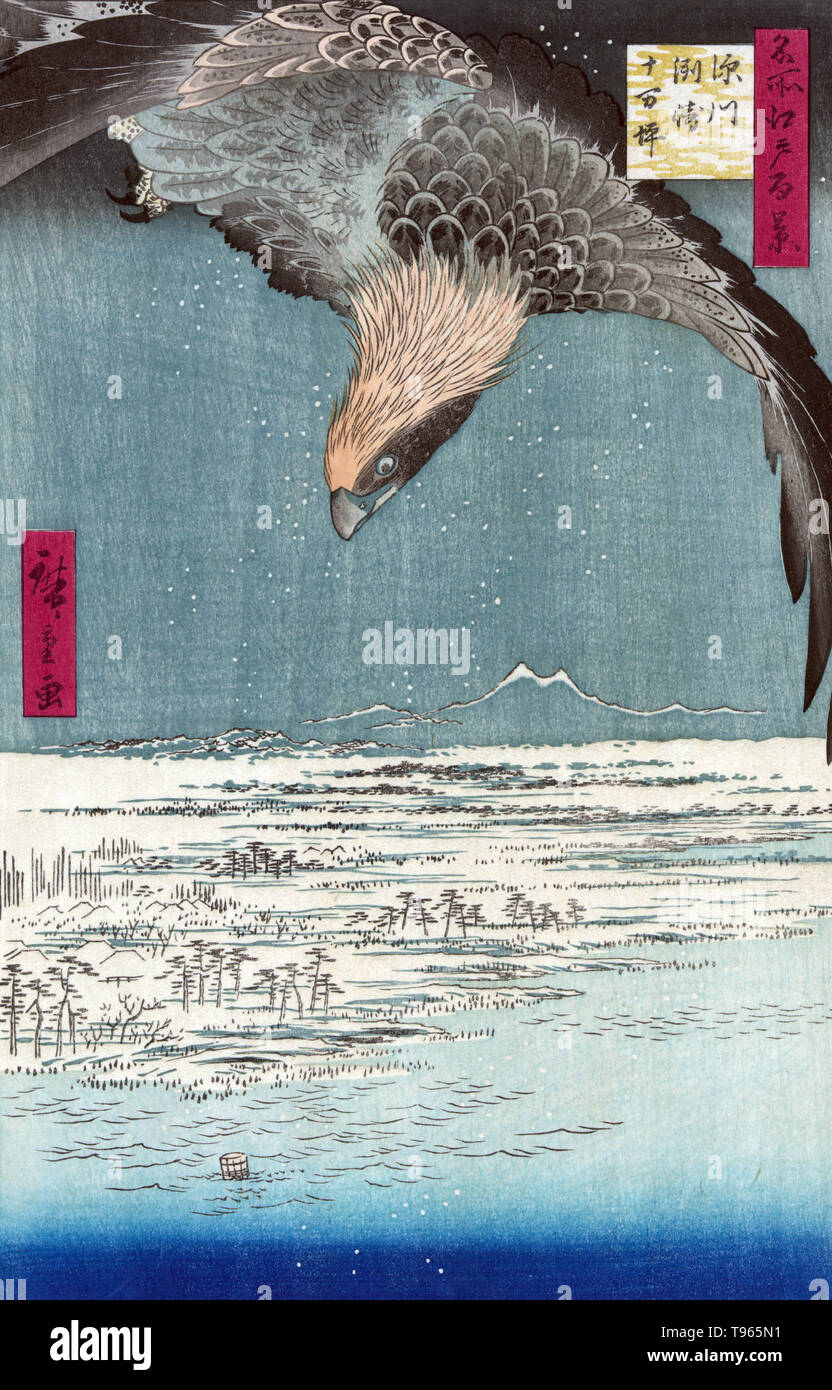 Fukagawa susaki jumantsubo. Hawk flying above a snowy landscape along the coastline. Ukiyo-e (picture of the floating world) is a genre of Japanese art which flourished from the 17th through 19th centuries. Ukiyo-e was central to forming the West's perception of Japanese art in the late 19th century.The landscape genre has come to dominate Western perceptions of ukiyo-e. Stock Photohttps://www.alamy.com/image-license-details/?v=1https://www.alamy.com/fukagawa-susaki-jumantsubo-hawk-flying-above-a-snowy-landscape-along-the-coastline-ukiyo-e-picture-of-the-floating-world-is-a-genre-of-japanese-art-which-flourished-from-the-17th-through-19th-centuries-ukiyo-e-was-central-to-forming-the-wests-perception-of-japanese-art-in-the-late-19th-centurythe-landscape-genre-has-come-to-dominate-western-perceptions-of-ukiyo-e-image246613277.html
Fukagawa susaki jumantsubo. Hawk flying above a snowy landscape along the coastline. Ukiyo-e (picture of the floating world) is a genre of Japanese art which flourished from the 17th through 19th centuries. Ukiyo-e was central to forming the West's perception of Japanese art in the late 19th century.The landscape genre has come to dominate Western perceptions of ukiyo-e. Stock Photohttps://www.alamy.com/image-license-details/?v=1https://www.alamy.com/fukagawa-susaki-jumantsubo-hawk-flying-above-a-snowy-landscape-along-the-coastline-ukiyo-e-picture-of-the-floating-world-is-a-genre-of-japanese-art-which-flourished-from-the-17th-through-19th-centuries-ukiyo-e-was-central-to-forming-the-wests-perception-of-japanese-art-in-the-late-19th-centurythe-landscape-genre-has-come-to-dominate-western-perceptions-of-ukiyo-e-image246613277.htmlRMT965N1–Fukagawa susaki jumantsubo. Hawk flying above a snowy landscape along the coastline. Ukiyo-e (picture of the floating world) is a genre of Japanese art which flourished from the 17th through 19th centuries. Ukiyo-e was central to forming the West's perception of Japanese art in the late 19th century.The landscape genre has come to dominate Western perceptions of ukiyo-e.
 Detail of Ukiyo-e Painting depicting a Geisha. Stock Photohttps://www.alamy.com/image-license-details/?v=1https://www.alamy.com/stock-photo-detail-of-ukiyo-e-painting-depicting-a-geisha-43303869.html
Detail of Ukiyo-e Painting depicting a Geisha. Stock Photohttps://www.alamy.com/image-license-details/?v=1https://www.alamy.com/stock-photo-detail-of-ukiyo-e-painting-depicting-a-geisha-43303869.htmlRMCECJEN–Detail of Ukiyo-e Painting depicting a Geisha.
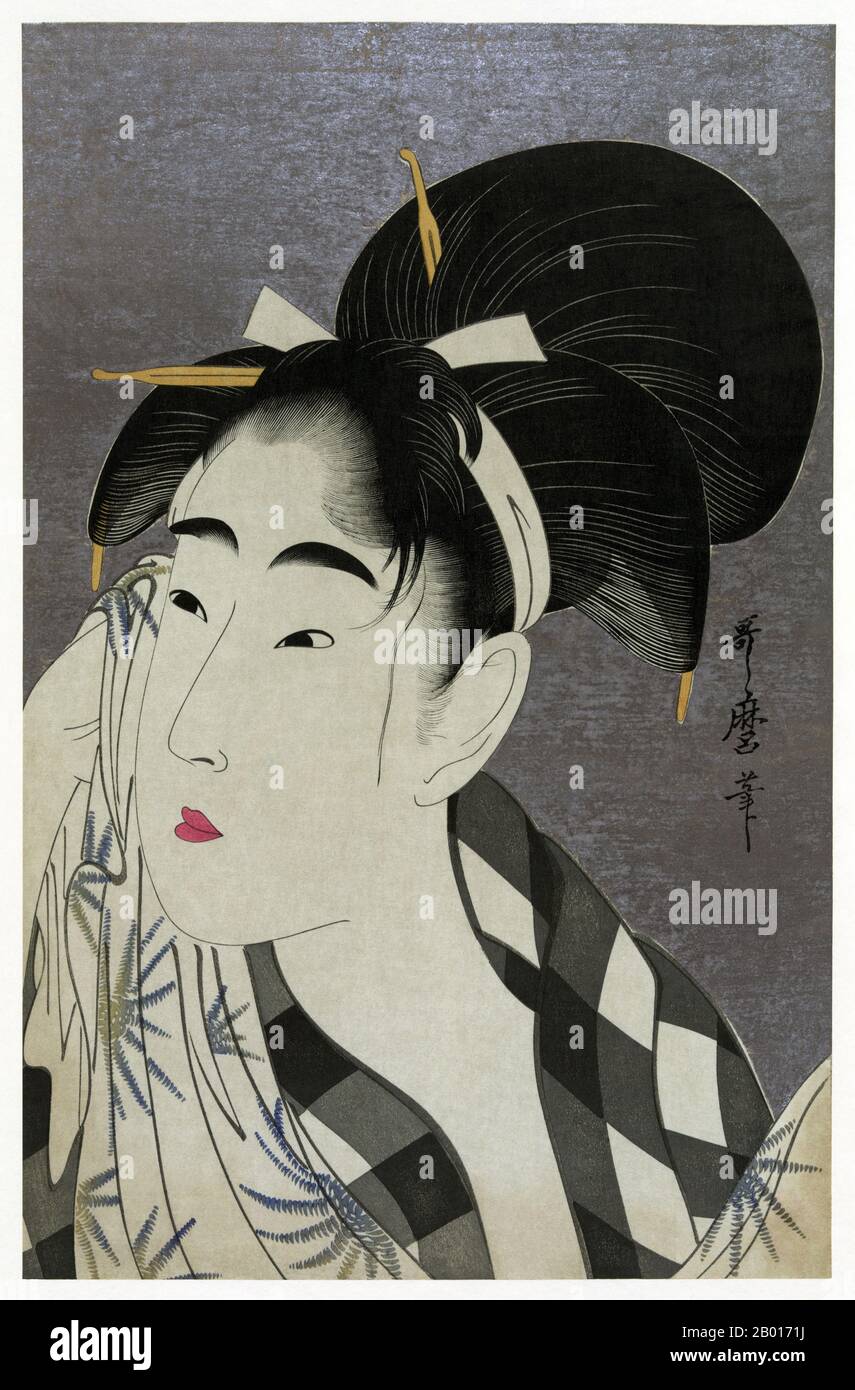 Japan: 'Woman Wiping Sweat'. Ukiyo-e woodblock print by Kitagawa Utamaro (c. 1753 - 31 October 1806), 1798. Kitagawa Utamaro was a Japanese printmaker and painter, who is considered one of the greatest artists of woodblock prints (ukiyo-e). He is known especially for his masterfully composed studies of women, known as bijinga. He also produced nature studies, particularly illustrated books of insects. Stock Photohttps://www.alamy.com/image-license-details/?v=1https://www.alamy.com/japan-woman-wiping-sweat-ukiyo-e-woodblock-print-by-kitagawa-utamaro-c-1753-31-october-1806-1798-kitagawa-utamaro-was-a-japanese-printmaker-and-painter-who-is-considered-one-of-the-greatest-artists-of-woodblock-prints-ukiyo-e-he-is-known-especially-for-his-masterfully-composed-studies-of-women-known-as-bijinga-he-also-produced-nature-studies-particularly-illustrated-books-of-insects-image344234846.html
Japan: 'Woman Wiping Sweat'. Ukiyo-e woodblock print by Kitagawa Utamaro (c. 1753 - 31 October 1806), 1798. Kitagawa Utamaro was a Japanese printmaker and painter, who is considered one of the greatest artists of woodblock prints (ukiyo-e). He is known especially for his masterfully composed studies of women, known as bijinga. He also produced nature studies, particularly illustrated books of insects. Stock Photohttps://www.alamy.com/image-license-details/?v=1https://www.alamy.com/japan-woman-wiping-sweat-ukiyo-e-woodblock-print-by-kitagawa-utamaro-c-1753-31-october-1806-1798-kitagawa-utamaro-was-a-japanese-printmaker-and-painter-who-is-considered-one-of-the-greatest-artists-of-woodblock-prints-ukiyo-e-he-is-known-especially-for-his-masterfully-composed-studies-of-women-known-as-bijinga-he-also-produced-nature-studies-particularly-illustrated-books-of-insects-image344234846.htmlRM2B0171J–Japan: 'Woman Wiping Sweat'. Ukiyo-e woodblock print by Kitagawa Utamaro (c. 1753 - 31 October 1806), 1798. Kitagawa Utamaro was a Japanese printmaker and painter, who is considered one of the greatest artists of woodblock prints (ukiyo-e). He is known especially for his masterfully composed studies of women, known as bijinga. He also produced nature studies, particularly illustrated books of insects.
 Japanese Ukiyo-e print showing English people and their customs, from a Japanese perspective. 1854 Stock Photohttps://www.alamy.com/image-license-details/?v=1https://www.alamy.com/stock-photo-japanese-ukiyo-e-print-showing-english-people-and-their-customs-from-84977559.html
Japanese Ukiyo-e print showing English people and their customs, from a Japanese perspective. 1854 Stock Photohttps://www.alamy.com/image-license-details/?v=1https://www.alamy.com/stock-photo-japanese-ukiyo-e-print-showing-english-people-and-their-customs-from-84977559.htmlRMEX71MR–Japanese Ukiyo-e print showing English people and their customs, from a Japanese perspective. 1854
 This 1920 image shows Hiroshige’s Kanagawa on the Tokaido. This is the forst station of Kanagawa, from the series 'Fifty-three Stations of the Tokaido (Tokaido gojusan tsugi),' also known as the Tokaido with Poem (Kyoka iri Tokaido). It was painted between 1832-1847. Utagawa Hiroshige, born Andō Hiroshige, was a Japanese ukiyo-e artist, considered the last great master of that tradition. Hiroshige is best known for his horizontal-format landscape series The Fifty-three Stations of the Tōkaidō and for his vertical-format landscape series One Hundred Famous Views of Edo. Stock Photohttps://www.alamy.com/image-license-details/?v=1https://www.alamy.com/this-1920-image-shows-hiroshiges-kanagawa-on-the-tokaido-this-is-the-forst-station-of-kanagawa-from-the-series-fifty-three-stations-of-the-tokaido-tokaido-gojusan-tsugi-also-known-as-the-tokaido-with-poem-kyoka-iri-tokaido-it-was-painted-between-1832-1847-utagawa-hiroshige-born-and-hiroshige-was-a-japanese-ukiyo-e-artist-considered-the-last-great-master-of-that-tradition-hiroshige-is-best-known-for-his-horizontal-format-landscape-series-the-fifty-three-stations-of-the-tkaid-and-for-his-vertical-format-landscape-series-one-hundred-famous-views-of-edo-image437443034.html
This 1920 image shows Hiroshige’s Kanagawa on the Tokaido. This is the forst station of Kanagawa, from the series 'Fifty-three Stations of the Tokaido (Tokaido gojusan tsugi),' also known as the Tokaido with Poem (Kyoka iri Tokaido). It was painted between 1832-1847. Utagawa Hiroshige, born Andō Hiroshige, was a Japanese ukiyo-e artist, considered the last great master of that tradition. Hiroshige is best known for his horizontal-format landscape series The Fifty-three Stations of the Tōkaidō and for his vertical-format landscape series One Hundred Famous Views of Edo. Stock Photohttps://www.alamy.com/image-license-details/?v=1https://www.alamy.com/this-1920-image-shows-hiroshiges-kanagawa-on-the-tokaido-this-is-the-forst-station-of-kanagawa-from-the-series-fifty-three-stations-of-the-tokaido-tokaido-gojusan-tsugi-also-known-as-the-tokaido-with-poem-kyoka-iri-tokaido-it-was-painted-between-1832-1847-utagawa-hiroshige-born-and-hiroshige-was-a-japanese-ukiyo-e-artist-considered-the-last-great-master-of-that-tradition-hiroshige-is-best-known-for-his-horizontal-format-landscape-series-the-fifty-three-stations-of-the-tkaid-and-for-his-vertical-format-landscape-series-one-hundred-famous-views-of-edo-image437443034.htmlRF2GBK71E–This 1920 image shows Hiroshige’s Kanagawa on the Tokaido. This is the forst station of Kanagawa, from the series 'Fifty-three Stations of the Tokaido (Tokaido gojusan tsugi),' also known as the Tokaido with Poem (Kyoka iri Tokaido). It was painted between 1832-1847. Utagawa Hiroshige, born Andō Hiroshige, was a Japanese ukiyo-e artist, considered the last great master of that tradition. Hiroshige is best known for his horizontal-format landscape series The Fifty-three Stations of the Tōkaidō and for his vertical-format landscape series One Hundred Famous Views of Edo.
 Asia, Japan, Honshu, Kyoto, Ukiyo-e, Painting, Geisha, Geishas, Tourism, Travel, Holiday, Vacation Stock Photohttps://www.alamy.com/image-license-details/?v=1https://www.alamy.com/stock-photo-asia-japan-honshu-kyoto-ukiyo-e-painting-geisha-geishas-tourism-travel-36957691.html
Asia, Japan, Honshu, Kyoto, Ukiyo-e, Painting, Geisha, Geishas, Tourism, Travel, Holiday, Vacation Stock Photohttps://www.alamy.com/image-license-details/?v=1https://www.alamy.com/stock-photo-asia-japan-honshu-kyoto-ukiyo-e-painting-geisha-geishas-tourism-travel-36957691.htmlRMC43FWF–Asia, Japan, Honshu, Kyoto, Ukiyo-e, Painting, Geisha, Geishas, Tourism, Travel, Holiday, Vacation
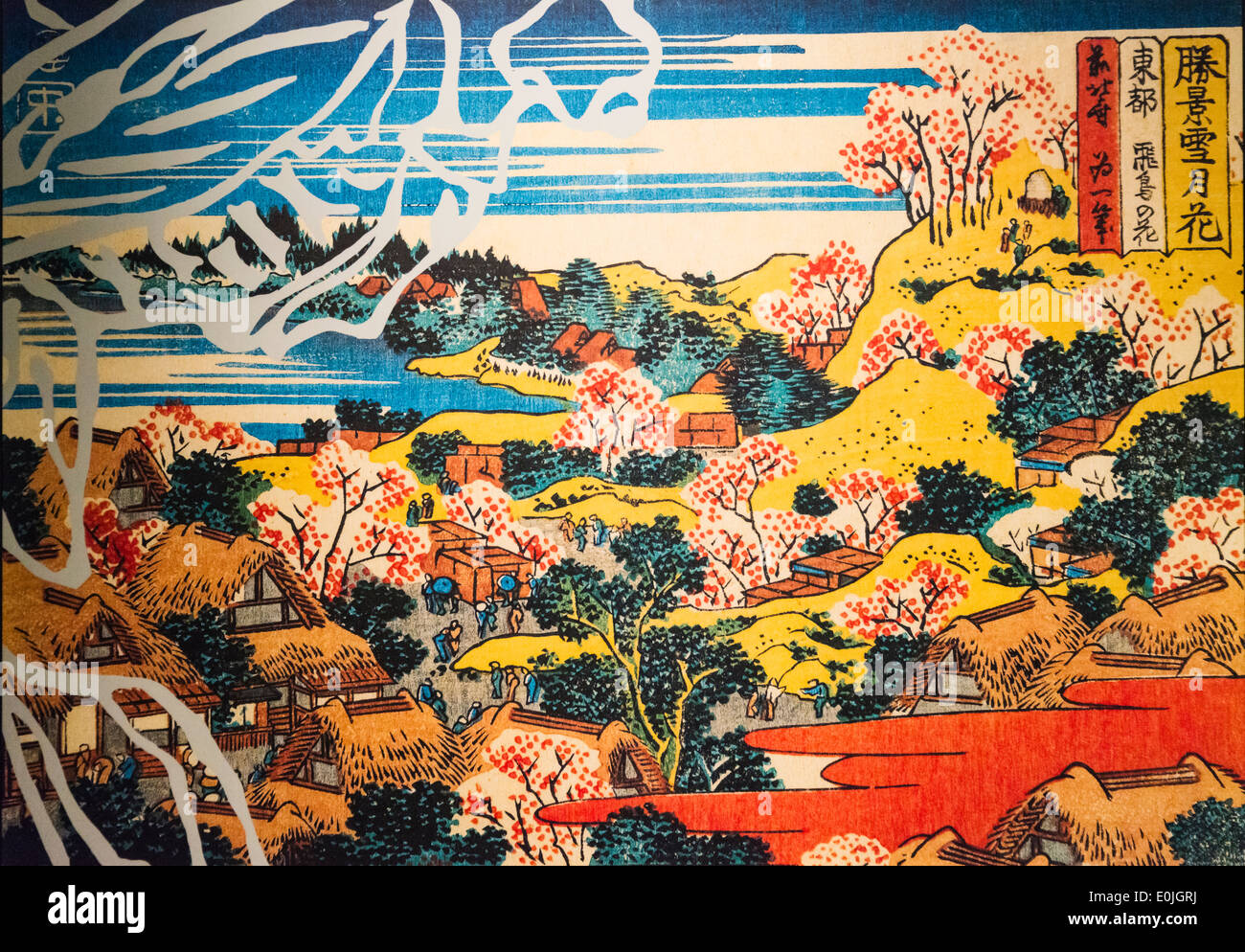 Ukiyo-e landscape painting, Japan Stock Photohttps://www.alamy.com/image-license-details/?v=1https://www.alamy.com/ukiyo-e-landscape-painting-japan-image69249814.html
Ukiyo-e landscape painting, Japan Stock Photohttps://www.alamy.com/image-license-details/?v=1https://www.alamy.com/ukiyo-e-landscape-painting-japan-image69249814.htmlRME0JGRJ–Ukiyo-e landscape painting, Japan
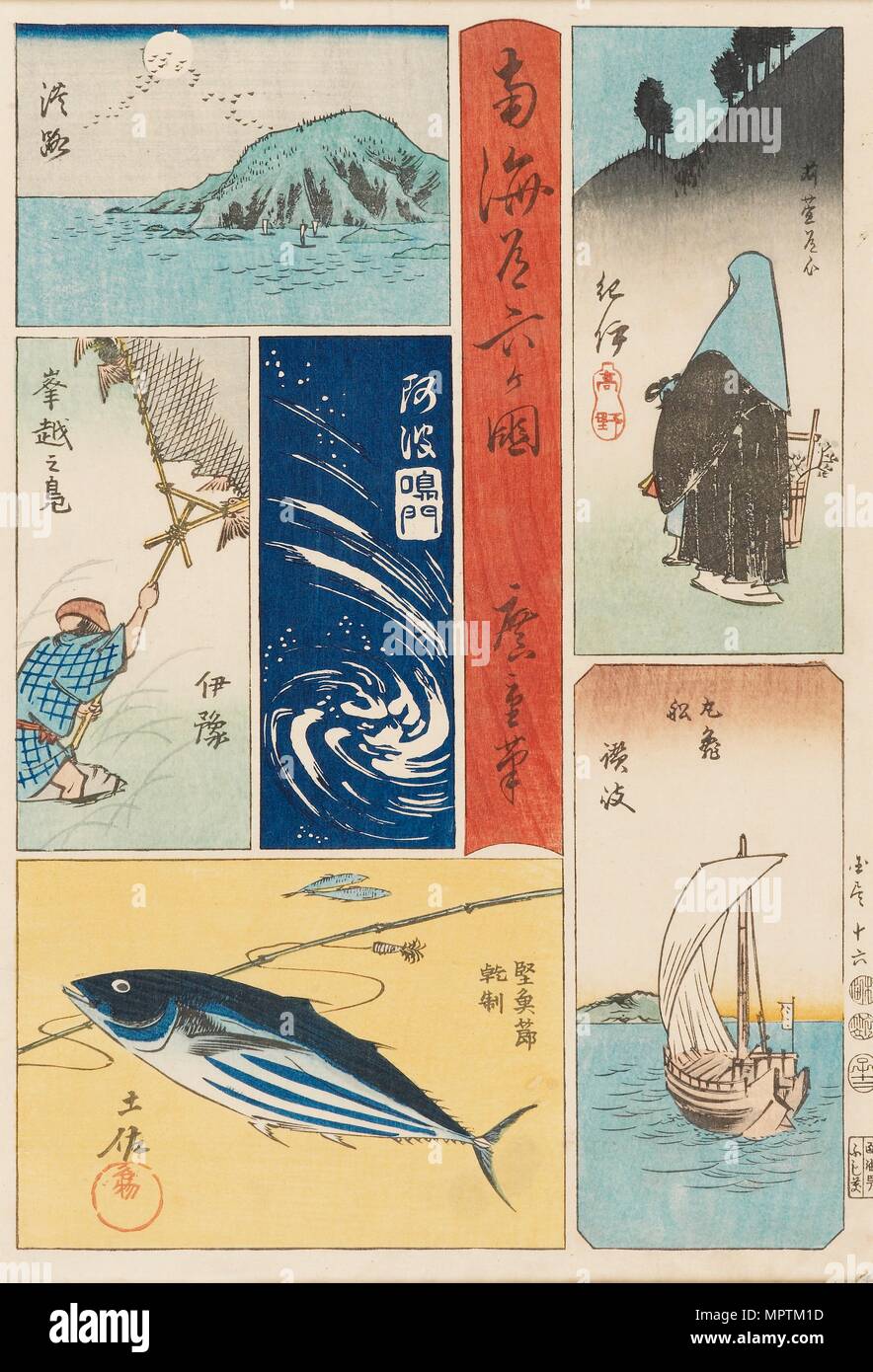 Ukiyo-e print - Nankaido Rokka-koku, 19th century. Artist: Ando Hiroshige. Stock Photohttps://www.alamy.com/image-license-details/?v=1https://www.alamy.com/ukiyo-e-print-nankaido-rokka-koku-19th-century-artist-ando-hiroshige-image186168681.html
Ukiyo-e print - Nankaido Rokka-koku, 19th century. Artist: Ando Hiroshige. Stock Photohttps://www.alamy.com/image-license-details/?v=1https://www.alamy.com/ukiyo-e-print-nankaido-rokka-koku-19th-century-artist-ando-hiroshige-image186168681.htmlRMMPTM1D–Ukiyo-e print - Nankaido Rokka-koku, 19th century. Artist: Ando Hiroshige.
 Japanese Ukiyo e print Stock Photohttps://www.alamy.com/image-license-details/?v=1https://www.alamy.com/stock-photo-japanese-ukiyo-e-print-16351977.html
Japanese Ukiyo e print Stock Photohttps://www.alamy.com/image-license-details/?v=1https://www.alamy.com/stock-photo-japanese-ukiyo-e-print-16351977.htmlRMATMN7P–Japanese Ukiyo e print
 Close-up of a details of a Ukiyo-e Painting depicting Geisha, Kyoto Prefecture, Kinki Region, Honshu, Japan Stock Photohttps://www.alamy.com/image-license-details/?v=1https://www.alamy.com/stock-photo-close-up-of-a-details-of-a-ukiyo-e-painting-depicting-geisha-kyoto-37611399.html
Close-up of a details of a Ukiyo-e Painting depicting Geisha, Kyoto Prefecture, Kinki Region, Honshu, Japan Stock Photohttps://www.alamy.com/image-license-details/?v=1https://www.alamy.com/stock-photo-close-up-of-a-details-of-a-ukiyo-e-painting-depicting-geisha-kyoto-37611399.htmlRMC559M7–Close-up of a details of a Ukiyo-e Painting depicting Geisha, Kyoto Prefecture, Kinki Region, Honshu, Japan
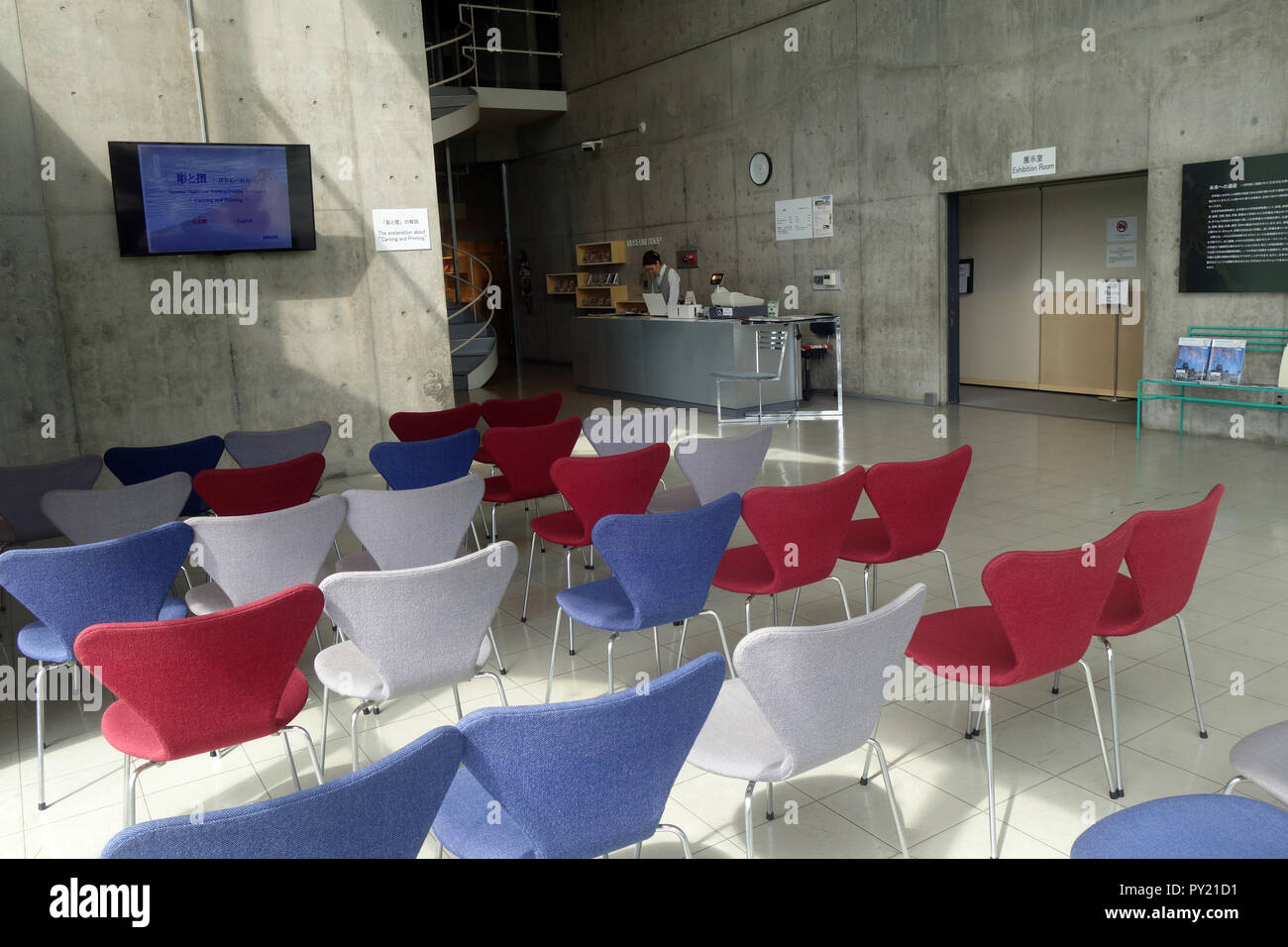 Foyer of the Japan Ukiyo-e Museum, Matsumoto, Japan. No PR or MR Stock Photohttps://www.alamy.com/image-license-details/?v=1https://www.alamy.com/foyer-of-the-japan-ukiyo-e-museum-matsumoto-japan-no-pr-or-mr-image223165181.html
Foyer of the Japan Ukiyo-e Museum, Matsumoto, Japan. No PR or MR Stock Photohttps://www.alamy.com/image-license-details/?v=1https://www.alamy.com/foyer-of-the-japan-ukiyo-e-museum-matsumoto-japan-no-pr-or-mr-image223165181.htmlRMPY21D1–Foyer of the Japan Ukiyo-e Museum, Matsumoto, Japan. No PR or MR
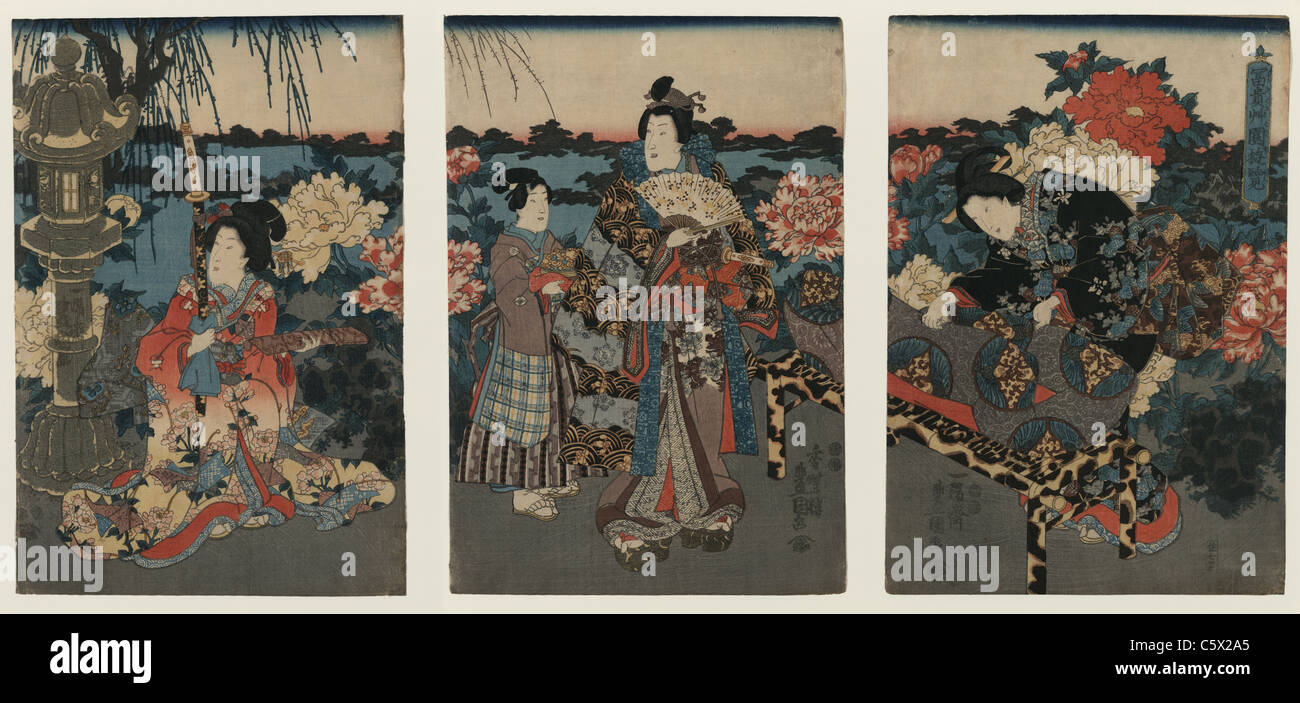 Enjoying a Garden of Peonies - Japanese Edo Ukiyo-e Triptych, circa 1850 Stock Photohttps://www.alamy.com/image-license-details/?v=1https://www.alamy.com/stock-photo-enjoying-a-garden-of-peonies-japanese-edo-ukiyo-e-triptych-circa-1850-38066621.html
Enjoying a Garden of Peonies - Japanese Edo Ukiyo-e Triptych, circa 1850 Stock Photohttps://www.alamy.com/image-license-details/?v=1https://www.alamy.com/stock-photo-enjoying-a-garden-of-peonies-japanese-edo-ukiyo-e-triptych-circa-1850-38066621.htmlRFC5X2A5–Enjoying a Garden of Peonies - Japanese Edo Ukiyo-e Triptych, circa 1850
 Japan, Tokyo, Ukiyo-e Print depicting Japanese Woman Stock Photohttps://www.alamy.com/image-license-details/?v=1https://www.alamy.com/stock-photo-japan-tokyo-ukiyo-e-print-depicting-japanese-woman-39615542.html
Japan, Tokyo, Ukiyo-e Print depicting Japanese Woman Stock Photohttps://www.alamy.com/image-license-details/?v=1https://www.alamy.com/stock-photo-japan-tokyo-ukiyo-e-print-depicting-japanese-woman-39615542.htmlRMC8CJ0P–Japan, Tokyo, Ukiyo-e Print depicting Japanese Woman
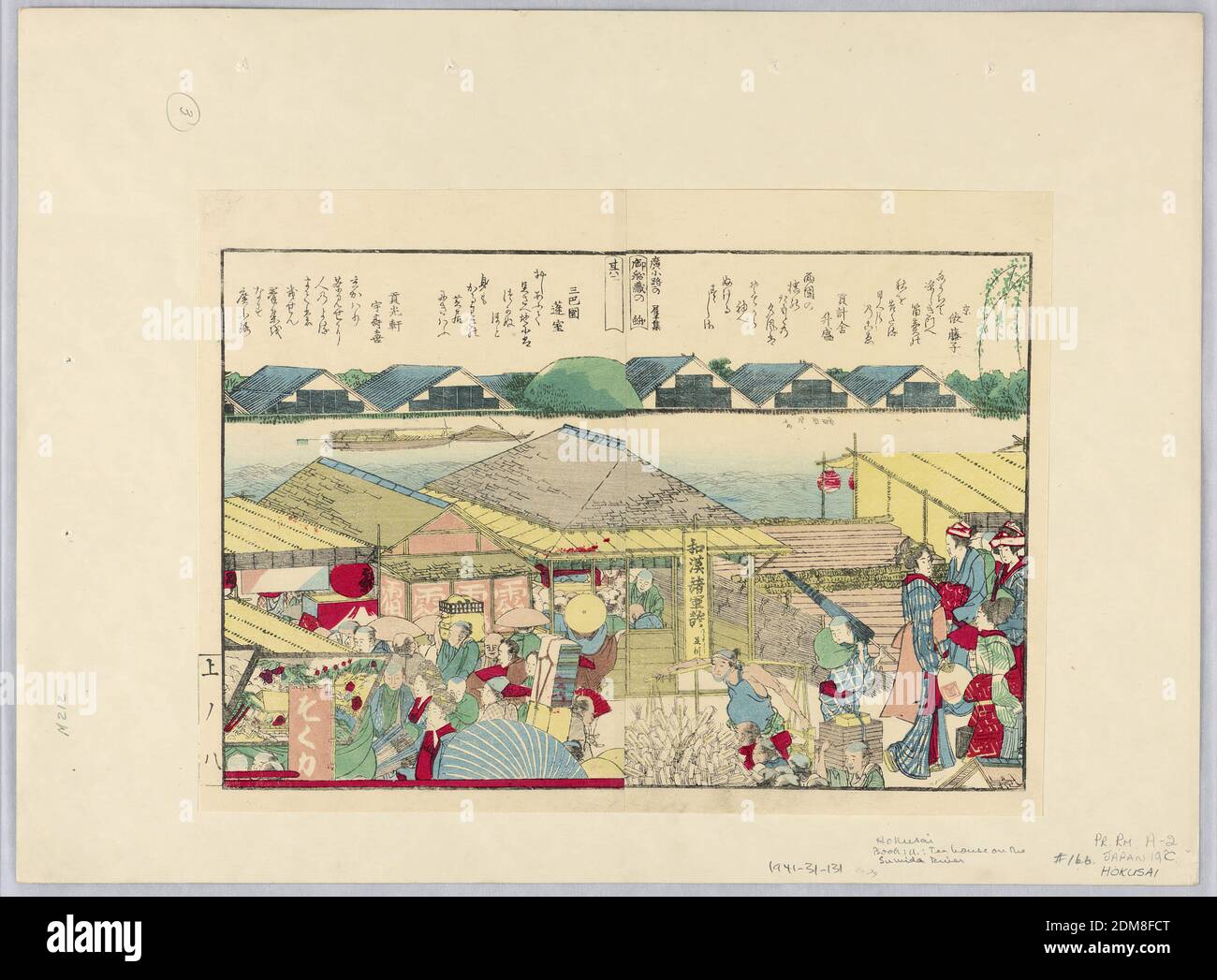 Teahouse on the Sumida River, Woodblock print (ukiyo-e) on mulberry paper (washi), ink with color, Japan, 1760-1849, landscapes, Print Stock Photohttps://www.alamy.com/image-license-details/?v=1https://www.alamy.com/teahouse-on-the-sumida-river-woodblock-print-ukiyo-e-on-mulberry-paper-washi-ink-with-color-japan-1760-1849-landscapes-print-image391108952.html
Teahouse on the Sumida River, Woodblock print (ukiyo-e) on mulberry paper (washi), ink with color, Japan, 1760-1849, landscapes, Print Stock Photohttps://www.alamy.com/image-license-details/?v=1https://www.alamy.com/teahouse-on-the-sumida-river-woodblock-print-ukiyo-e-on-mulberry-paper-washi-ink-with-color-japan-1760-1849-landscapes-print-image391108952.htmlRM2DM8FCT–Teahouse on the Sumida River, Woodblock print (ukiyo-e) on mulberry paper (washi), ink with color, Japan, 1760-1849, landscapes, Print
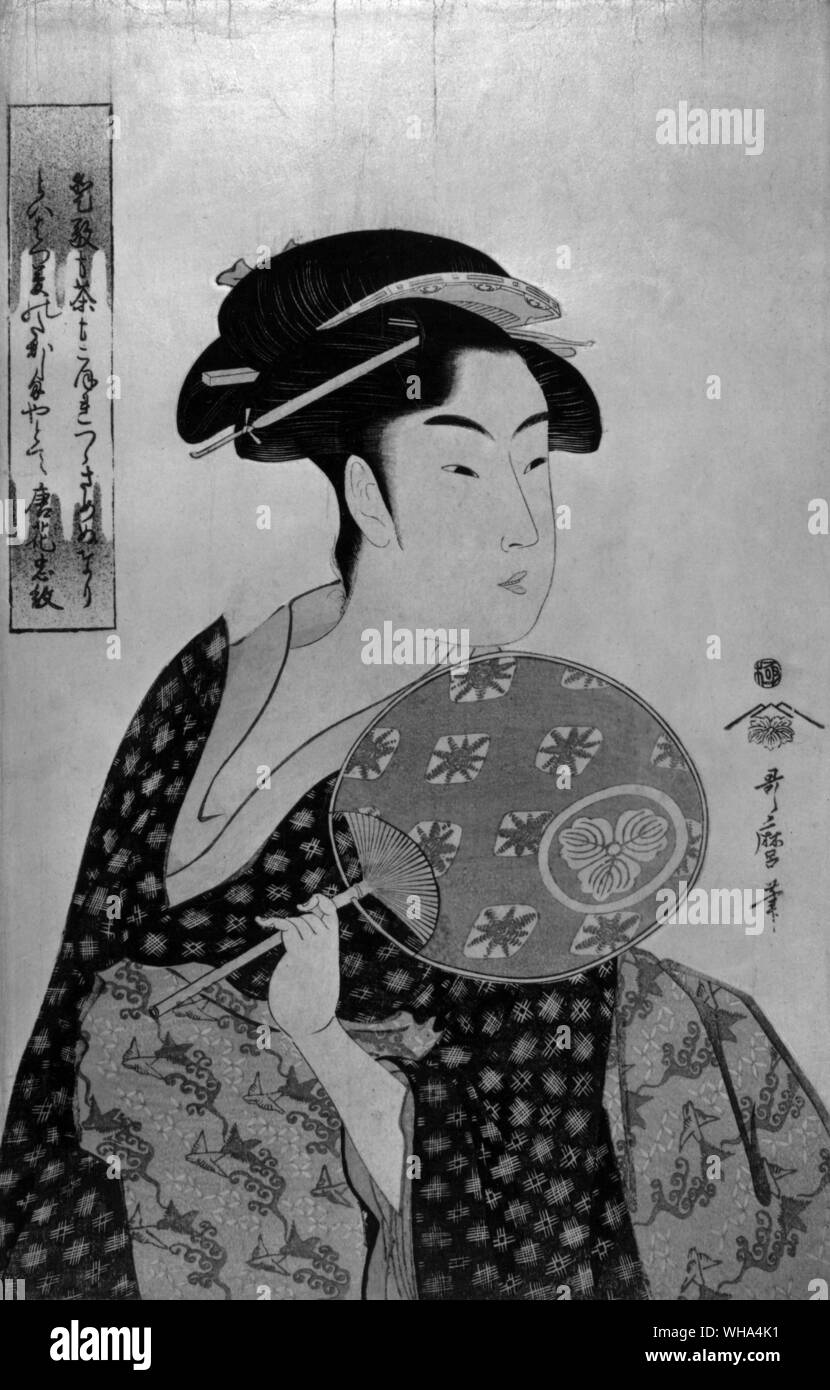 Utamaro Kitagawa is highly appreciated as the dominating ukiyo-e artist of the late eighteenth century. Yet little is known about his life. Neither the precise date of Utamaro's birth, his birthplace, nor any substantial information about his parents are known. 1750-1806 . . The Teahouse Waitress. colour woodcut 1791-92 Stock Photohttps://www.alamy.com/image-license-details/?v=1https://www.alamy.com/utamaro-kitagawa-is-highly-appreciated-as-the-dominating-ukiyo-e-artist-of-the-late-eighteenth-century-yet-little-is-known-about-his-life-neither-the-precise-date-of-utamaros-birth-his-birthplace-nor-any-substantial-information-about-his-parents-are-known-1750-1806-the-teahouse-waitress-colour-woodcut-1791-92-image268827861.html
Utamaro Kitagawa is highly appreciated as the dominating ukiyo-e artist of the late eighteenth century. Yet little is known about his life. Neither the precise date of Utamaro's birth, his birthplace, nor any substantial information about his parents are known. 1750-1806 . . The Teahouse Waitress. colour woodcut 1791-92 Stock Photohttps://www.alamy.com/image-license-details/?v=1https://www.alamy.com/utamaro-kitagawa-is-highly-appreciated-as-the-dominating-ukiyo-e-artist-of-the-late-eighteenth-century-yet-little-is-known-about-his-life-neither-the-precise-date-of-utamaros-birth-his-birthplace-nor-any-substantial-information-about-his-parents-are-known-1750-1806-the-teahouse-waitress-colour-woodcut-1791-92-image268827861.htmlRMWHA4K1–Utamaro Kitagawa is highly appreciated as the dominating ukiyo-e artist of the late eighteenth century. Yet little is known about his life. Neither the precise date of Utamaro's birth, his birthplace, nor any substantial information about his parents are known. 1750-1806 . . The Teahouse Waitress. colour woodcut 1791-92
 Arashi Ryuzo I in the role of Yakko Ukiyo Matabei and otani Stock Photohttps://www.alamy.com/image-license-details/?v=1https://www.alamy.com/stock-photo-arashi-ryuzo-i-in-the-role-of-yakko-ukiyo-matabei-and-otani-83175224.html
Arashi Ryuzo I in the role of Yakko Ukiyo Matabei and otani Stock Photohttps://www.alamy.com/image-license-details/?v=1https://www.alamy.com/stock-photo-arashi-ryuzo-i-in-the-role-of-yakko-ukiyo-matabei-and-otani-83175224.htmlRMER8XRM–Arashi Ryuzo I in the role of Yakko Ukiyo Matabei and otani
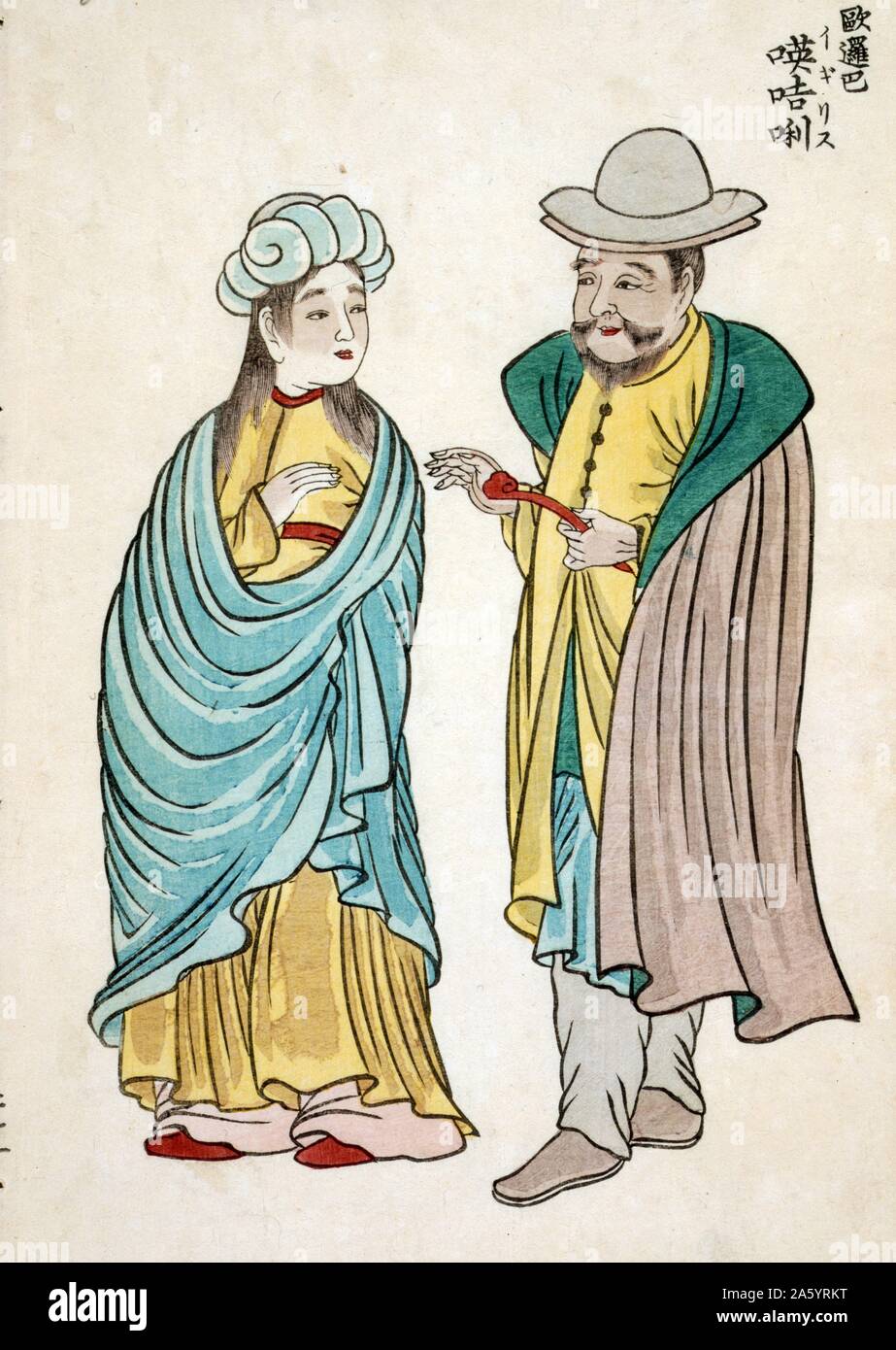 Japanese Ukiyo-e print showing English people and their customs, from a Japanese perspective. 1854 Stock Photohttps://www.alamy.com/image-license-details/?v=1https://www.alamy.com/japanese-ukiyo-e-print-showing-english-people-and-their-customs-from-a-japanese-perspective-1854-image330681564.html
Japanese Ukiyo-e print showing English people and their customs, from a Japanese perspective. 1854 Stock Photohttps://www.alamy.com/image-license-details/?v=1https://www.alamy.com/japanese-ukiyo-e-print-showing-english-people-and-their-customs-from-a-japanese-perspective-1854-image330681564.htmlRM2A5YRKT–Japanese Ukiyo-e print showing English people and their customs, from a Japanese perspective. 1854
 HIROSHIGE Vintage 1800s illustration ‘Utagawa Hiroshige’ : Numazu: Mount Fuji and Mount Ashigara after snow ... Numazu ashigarayama fuji yikihare Series Title: Fifty-three Famous Views, known as Vertical Tokaido (or Famous Places of the Fifty-three Stations of the Tōkaidō) Hiroshiges remarkable skill in rendering snow scenes. Two travelers cross the Kise River over a footbridge as they approach an inn at the Numazu station. This sheet is from the last series that Hiroshige published Utagwa Hiroshige, born Andō Hiroshige, was a Japanese ukiyo-e artist, considered the last great master Stock Photohttps://www.alamy.com/image-license-details/?v=1https://www.alamy.com/hiroshige-vintage-1800s-illustration-utagawa-hiroshige-numazu-mount-fuji-and-mount-ashigara-after-snow-numazu-ashigarayama-fuji-yikihare-series-title-fifty-three-famous-views-known-as-vertical-tokaido-or-famous-places-of-the-fifty-three-stations-of-the-tkaid-hiroshiges-remarkable-skill-in-rendering-snow-scenes-two-travelers-cross-the-kise-river-over-a-footbridge-as-they-approach-an-inn-at-the-numazu-station-this-sheet-is-from-the-last-series-that-hiroshige-published-utagwa-hiroshige-born-and-hiroshige-was-a-japanese-ukiyo-e-artist-considered-the-last-great-master-image353754440.html
HIROSHIGE Vintage 1800s illustration ‘Utagawa Hiroshige’ : Numazu: Mount Fuji and Mount Ashigara after snow ... Numazu ashigarayama fuji yikihare Series Title: Fifty-three Famous Views, known as Vertical Tokaido (or Famous Places of the Fifty-three Stations of the Tōkaidō) Hiroshiges remarkable skill in rendering snow scenes. Two travelers cross the Kise River over a footbridge as they approach an inn at the Numazu station. This sheet is from the last series that Hiroshige published Utagwa Hiroshige, born Andō Hiroshige, was a Japanese ukiyo-e artist, considered the last great master Stock Photohttps://www.alamy.com/image-license-details/?v=1https://www.alamy.com/hiroshige-vintage-1800s-illustration-utagawa-hiroshige-numazu-mount-fuji-and-mount-ashigara-after-snow-numazu-ashigarayama-fuji-yikihare-series-title-fifty-three-famous-views-known-as-vertical-tokaido-or-famous-places-of-the-fifty-three-stations-of-the-tkaid-hiroshiges-remarkable-skill-in-rendering-snow-scenes-two-travelers-cross-the-kise-river-over-a-footbridge-as-they-approach-an-inn-at-the-numazu-station-this-sheet-is-from-the-last-series-that-hiroshige-published-utagwa-hiroshige-born-and-hiroshige-was-a-japanese-ukiyo-e-artist-considered-the-last-great-master-image353754440.htmlRM2BFEWB4–HIROSHIGE Vintage 1800s illustration ‘Utagawa Hiroshige’ : Numazu: Mount Fuji and Mount Ashigara after snow ... Numazu ashigarayama fuji yikihare Series Title: Fifty-three Famous Views, known as Vertical Tokaido (or Famous Places of the Fifty-three Stations of the Tōkaidō) Hiroshiges remarkable skill in rendering snow scenes. Two travelers cross the Kise River over a footbridge as they approach an inn at the Numazu station. This sheet is from the last series that Hiroshige published Utagwa Hiroshige, born Andō Hiroshige, was a Japanese ukiyo-e artist, considered the last great master
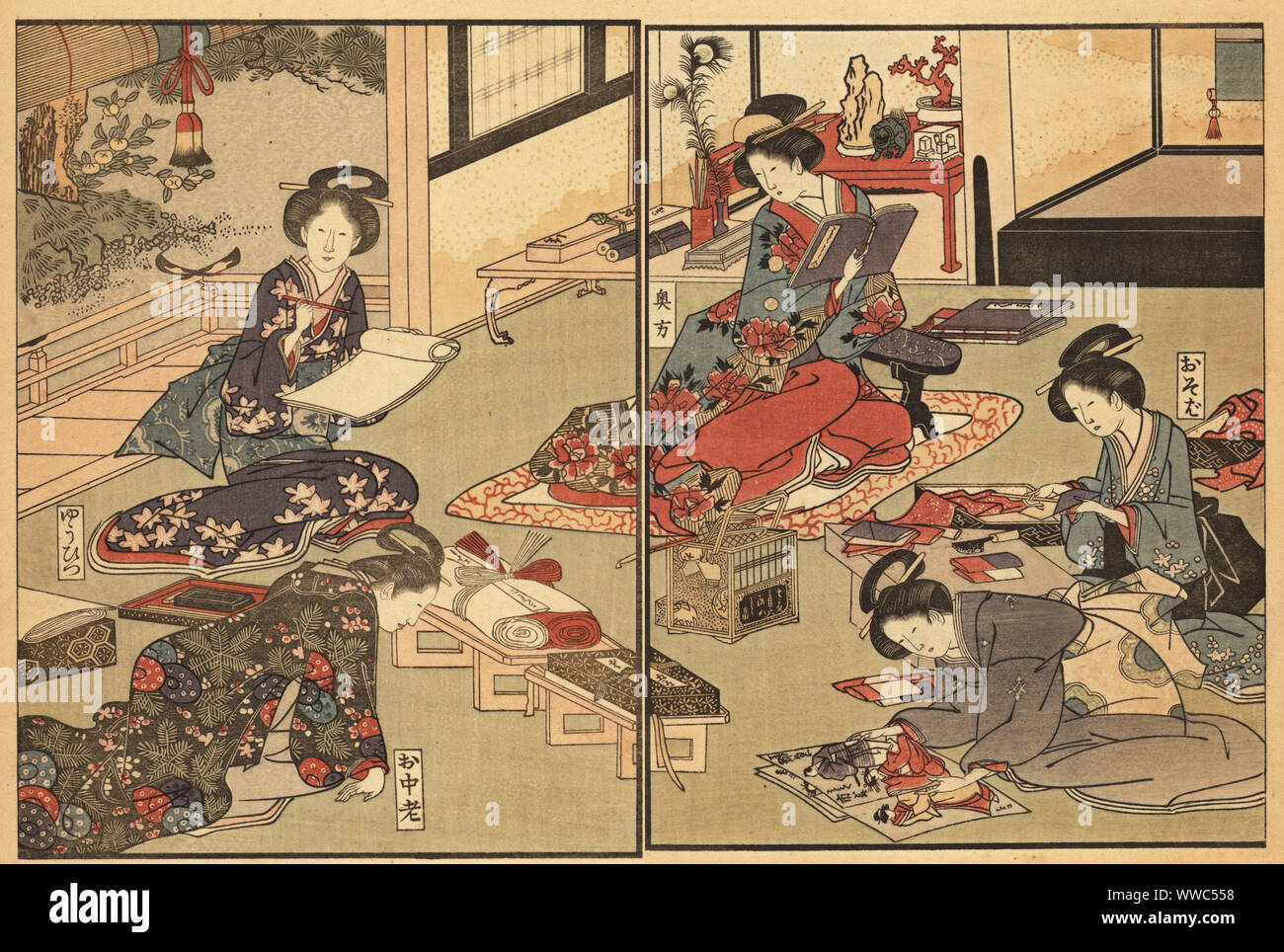 Wife of the elite samurai class reading books, with other women writing with a pen, one looking at ukiyo-e prints, and one folding paper. Another woman delivers reams of paper and ink. The alcove is decorated with coral, scrolls, feathers, etc. Handcoloured ukiyo-e woodblock print by Toyokuni Utagawa from Shikitei Sanba’s Ehon Imayo Sugata (Picture Book of the Modern Forms and Figures, Tokyo, 1916. Reprint of the original from 1802. Stock Photohttps://www.alamy.com/image-license-details/?v=1https://www.alamy.com/wife-of-the-elite-samurai-class-reading-books-with-other-women-writing-with-a-pen-one-looking-at-ukiyo-e-prints-and-one-folding-paper-another-woman-delivers-reams-of-paper-and-ink-the-alcove-is-decorated-with-coral-scrolls-feathers-etc-handcoloured-ukiyo-e-woodblock-print-by-toyokuni-utagawa-from-shikitei-sanbas-ehon-imayo-sugata-picture-book-of-the-modern-forms-and-figures-tokyo-1916-reprint-of-the-original-from-1802-image273789412.html
Wife of the elite samurai class reading books, with other women writing with a pen, one looking at ukiyo-e prints, and one folding paper. Another woman delivers reams of paper and ink. The alcove is decorated with coral, scrolls, feathers, etc. Handcoloured ukiyo-e woodblock print by Toyokuni Utagawa from Shikitei Sanba’s Ehon Imayo Sugata (Picture Book of the Modern Forms and Figures, Tokyo, 1916. Reprint of the original from 1802. Stock Photohttps://www.alamy.com/image-license-details/?v=1https://www.alamy.com/wife-of-the-elite-samurai-class-reading-books-with-other-women-writing-with-a-pen-one-looking-at-ukiyo-e-prints-and-one-folding-paper-another-woman-delivers-reams-of-paper-and-ink-the-alcove-is-decorated-with-coral-scrolls-feathers-etc-handcoloured-ukiyo-e-woodblock-print-by-toyokuni-utagawa-from-shikitei-sanbas-ehon-imayo-sugata-picture-book-of-the-modern-forms-and-figures-tokyo-1916-reprint-of-the-original-from-1802-image273789412.htmlRMWWC558–Wife of the elite samurai class reading books, with other women writing with a pen, one looking at ukiyo-e prints, and one folding paper. Another woman delivers reams of paper and ink. The alcove is decorated with coral, scrolls, feathers, etc. Handcoloured ukiyo-e woodblock print by Toyokuni Utagawa from Shikitei Sanba’s Ehon Imayo Sugata (Picture Book of the Modern Forms and Figures, Tokyo, 1916. Reprint of the original from 1802.
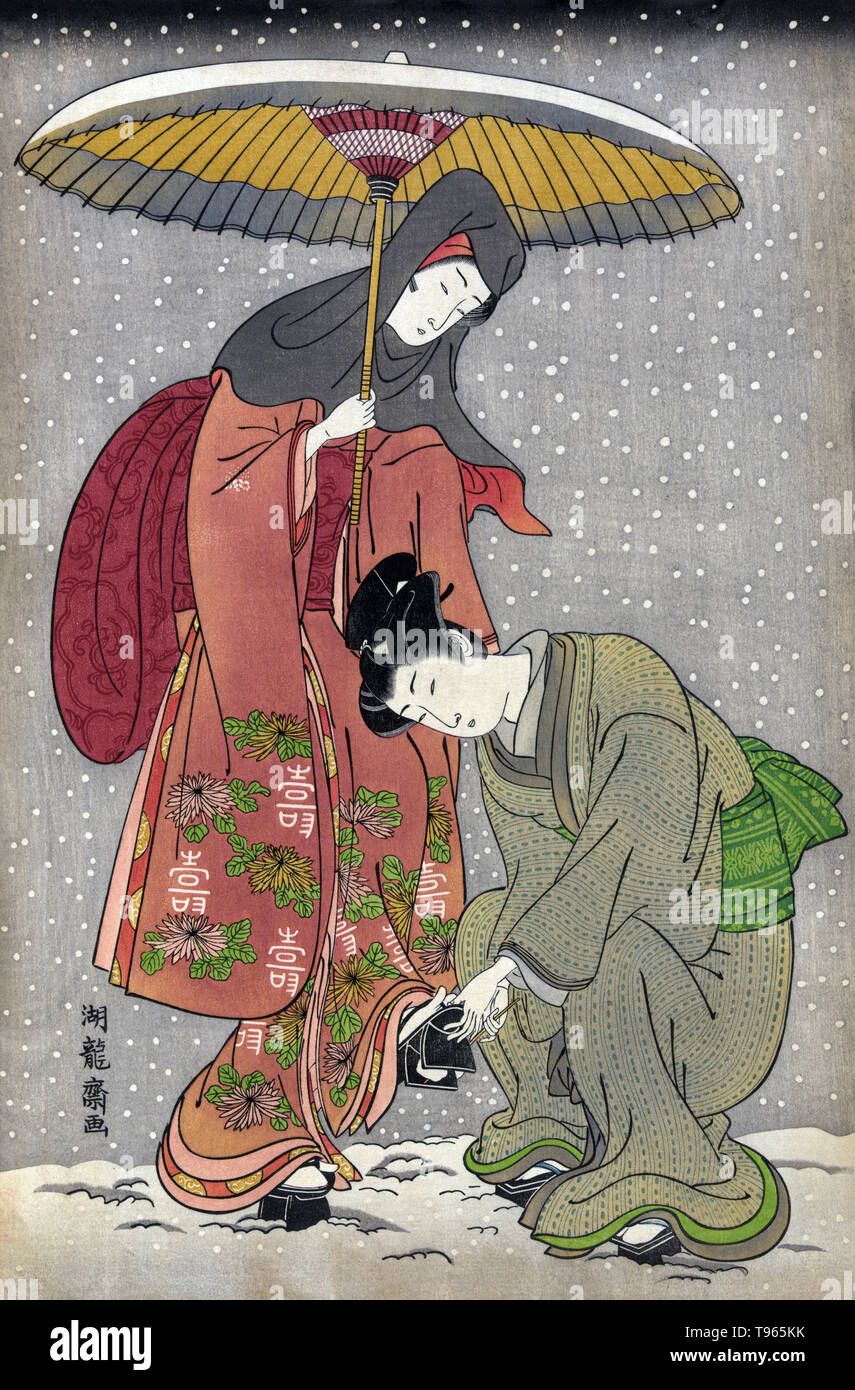 Geta no yukitori. Removing snow from one's clogs. Woman holding an umbrella while a female servant removes snow from her geta. Ukiyo-e (picture of the floating world) is a genre of Japanese art which flourished from the 17th through 19th centuries. Ukiyo-e was central to forming the West's perception of Japanese art in the late 19th century. Isoda Koryusai, 1776. Stock Photohttps://www.alamy.com/image-license-details/?v=1https://www.alamy.com/geta-no-yukitori-removing-snow-from-ones-clogs-woman-holding-an-umbrella-while-a-female-servant-removes-snow-from-her-geta-ukiyo-e-picture-of-the-floating-world-is-a-genre-of-japanese-art-which-flourished-from-the-17th-through-19th-centuries-ukiyo-e-was-central-to-forming-the-wests-perception-of-japanese-art-in-the-late-19th-century-isoda-koryusai-1776-image246613239.html
Geta no yukitori. Removing snow from one's clogs. Woman holding an umbrella while a female servant removes snow from her geta. Ukiyo-e (picture of the floating world) is a genre of Japanese art which flourished from the 17th through 19th centuries. Ukiyo-e was central to forming the West's perception of Japanese art in the late 19th century. Isoda Koryusai, 1776. Stock Photohttps://www.alamy.com/image-license-details/?v=1https://www.alamy.com/geta-no-yukitori-removing-snow-from-ones-clogs-woman-holding-an-umbrella-while-a-female-servant-removes-snow-from-her-geta-ukiyo-e-picture-of-the-floating-world-is-a-genre-of-japanese-art-which-flourished-from-the-17th-through-19th-centuries-ukiyo-e-was-central-to-forming-the-wests-perception-of-japanese-art-in-the-late-19th-century-isoda-koryusai-1776-image246613239.htmlRMT965KK–Geta no yukitori. Removing snow from one's clogs. Woman holding an umbrella while a female servant removes snow from her geta. Ukiyo-e (picture of the floating world) is a genre of Japanese art which flourished from the 17th through 19th centuries. Ukiyo-e was central to forming the West's perception of Japanese art in the late 19th century. Isoda Koryusai, 1776.
 Katsushika Hokusai, was a Japanese artist, ukiyo-e painter and printmaker of the Edo period. Stock Photohttps://www.alamy.com/image-license-details/?v=1https://www.alamy.com/stock-photo-katsushika-hokusai-was-a-japanese-artist-ukiyo-e-painter-and-printmaker-29211045.html
Katsushika Hokusai, was a Japanese artist, ukiyo-e painter and printmaker of the Edo period. Stock Photohttps://www.alamy.com/image-license-details/?v=1https://www.alamy.com/stock-photo-katsushika-hokusai-was-a-japanese-artist-ukiyo-e-painter-and-printmaker-29211045.htmlRMBKEJYH–Katsushika Hokusai, was a Japanese artist, ukiyo-e painter and printmaker of the Edo period.
 Japan: Woman nursing infant. Ukiyo-e woodblock by Kitagawa Utamaro (c. 1753 - 31 October 1806), late 18th century. Kitagawa Utamaro was a Japanese printmaker and painter, who is considered one of the greatest artists of woodblock prints (ukiyo-e). He is known especially for his masterfully composed studies of women, known as bijinga. He also produced nature studies, particularly illustrated books of insects. Stock Photohttps://www.alamy.com/image-license-details/?v=1https://www.alamy.com/japan-woman-nursing-infant-ukiyo-e-woodblock-by-kitagawa-utamaro-c-1753-31-october-1806-late-18th-century-kitagawa-utamaro-was-a-japanese-printmaker-and-painter-who-is-considered-one-of-the-greatest-artists-of-woodblock-prints-ukiyo-e-he-is-known-especially-for-his-masterfully-composed-studies-of-women-known-as-bijinga-he-also-produced-nature-studies-particularly-illustrated-books-of-insects-image344243978.html
Japan: Woman nursing infant. Ukiyo-e woodblock by Kitagawa Utamaro (c. 1753 - 31 October 1806), late 18th century. Kitagawa Utamaro was a Japanese printmaker and painter, who is considered one of the greatest artists of woodblock prints (ukiyo-e). He is known especially for his masterfully composed studies of women, known as bijinga. He also produced nature studies, particularly illustrated books of insects. Stock Photohttps://www.alamy.com/image-license-details/?v=1https://www.alamy.com/japan-woman-nursing-infant-ukiyo-e-woodblock-by-kitagawa-utamaro-c-1753-31-october-1806-late-18th-century-kitagawa-utamaro-was-a-japanese-printmaker-and-painter-who-is-considered-one-of-the-greatest-artists-of-woodblock-prints-ukiyo-e-he-is-known-especially-for-his-masterfully-composed-studies-of-women-known-as-bijinga-he-also-produced-nature-studies-particularly-illustrated-books-of-insects-image344243978.htmlRM2B01JKP–Japan: Woman nursing infant. Ukiyo-e woodblock by Kitagawa Utamaro (c. 1753 - 31 October 1806), late 18th century. Kitagawa Utamaro was a Japanese printmaker and painter, who is considered one of the greatest artists of woodblock prints (ukiyo-e). He is known especially for his masterfully composed studies of women, known as bijinga. He also produced nature studies, particularly illustrated books of insects.
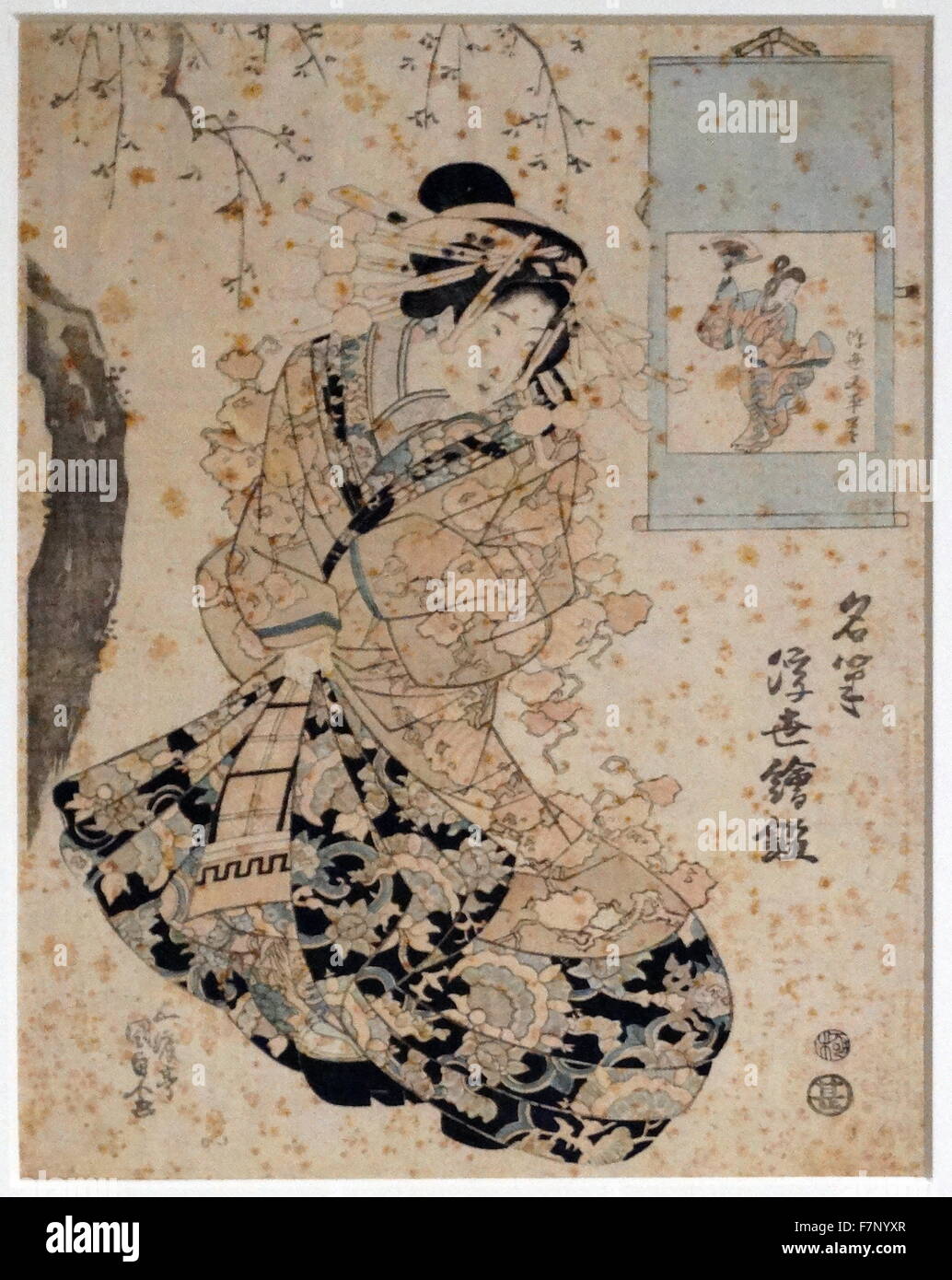 Ukiyo Matabei (Meishitsu ukiyo-e kagami) by Utagawa Kunisada (1786-1865) Japanese designer of ukiyo-e woodblock prints. Dated 1820 Stock Photohttps://www.alamy.com/image-license-details/?v=1https://www.alamy.com/stock-photo-ukiyo-matabei-meishitsu-ukiyo-e-kagami-by-utagawa-kunisada-1786-1865-90837343.html
Ukiyo Matabei (Meishitsu ukiyo-e kagami) by Utagawa Kunisada (1786-1865) Japanese designer of ukiyo-e woodblock prints. Dated 1820 Stock Photohttps://www.alamy.com/image-license-details/?v=1https://www.alamy.com/stock-photo-ukiyo-matabei-meishitsu-ukiyo-e-kagami-by-utagawa-kunisada-1786-1865-90837343.htmlRMF7NYXR–Ukiyo Matabei (Meishitsu ukiyo-e kagami) by Utagawa Kunisada (1786-1865) Japanese designer of ukiyo-e woodblock prints. Dated 1820
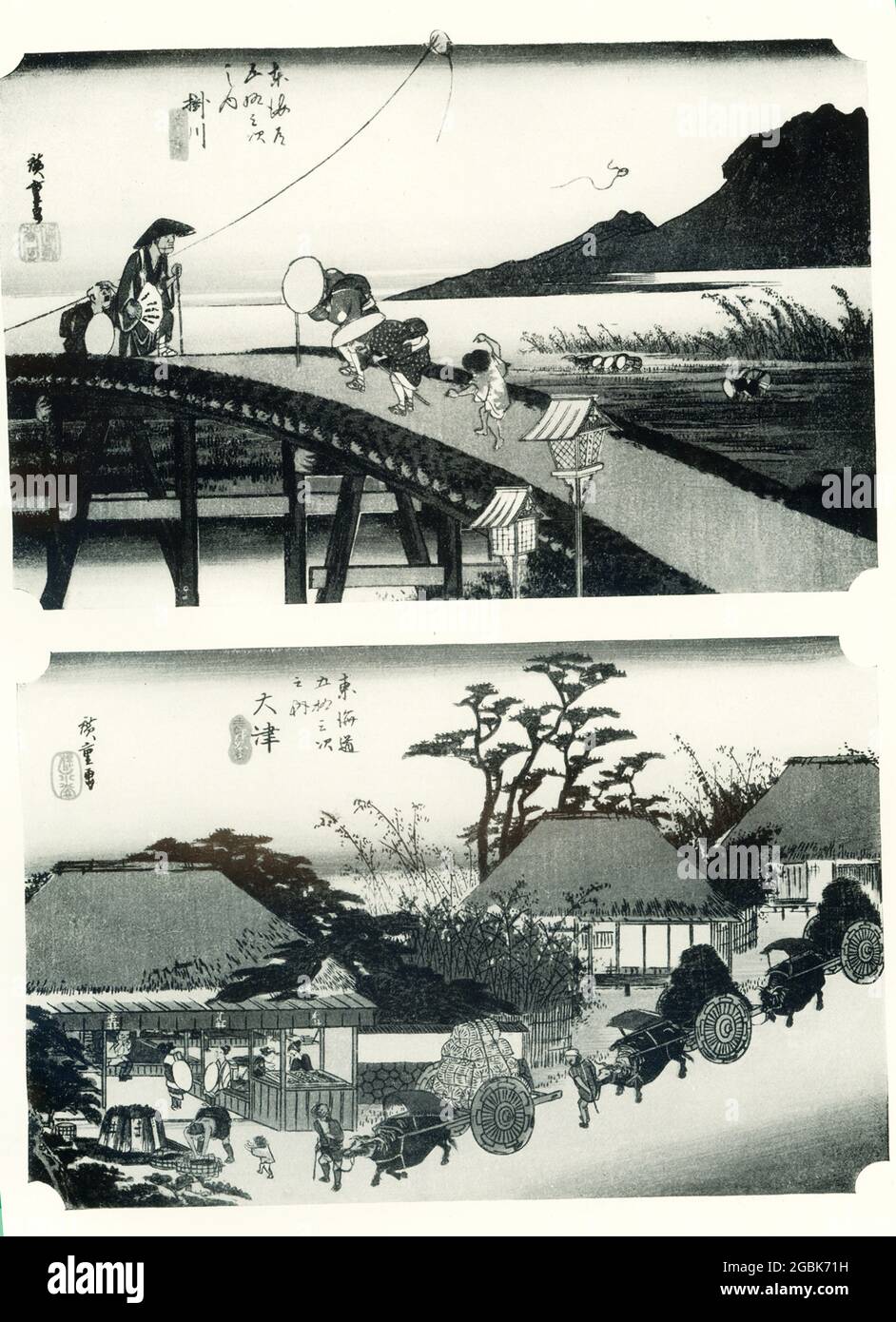 The caption reads: “Hiroshige - Stations Kakegawa and Otsu on the Tokaido.” Utagawa Hiroshige, born Andō Hiroshige, was a Japanese ukiyo-e artist, considered the last great master of that tradition. Stock Photohttps://www.alamy.com/image-license-details/?v=1https://www.alamy.com/the-caption-reads-hiroshige-stations-kakegawa-and-otsu-on-the-tokaido-utagawa-hiroshige-born-and-hiroshige-was-a-japanese-ukiyo-e-artist-considered-the-last-great-master-of-that-tradition-image437443037.html
The caption reads: “Hiroshige - Stations Kakegawa and Otsu on the Tokaido.” Utagawa Hiroshige, born Andō Hiroshige, was a Japanese ukiyo-e artist, considered the last great master of that tradition. Stock Photohttps://www.alamy.com/image-license-details/?v=1https://www.alamy.com/the-caption-reads-hiroshige-stations-kakegawa-and-otsu-on-the-tokaido-utagawa-hiroshige-born-and-hiroshige-was-a-japanese-ukiyo-e-artist-considered-the-last-great-master-of-that-tradition-image437443037.htmlRF2GBK71H–The caption reads: “Hiroshige - Stations Kakegawa and Otsu on the Tokaido.” Utagawa Hiroshige, born Andō Hiroshige, was a Japanese ukiyo-e artist, considered the last great master of that tradition.
 Japan, Honshu, Tokyo, Tokyo City Old Meets New Advertising Poster depicting Ukiyo-e Artwork Figure Stock Photohttps://www.alamy.com/image-license-details/?v=1https://www.alamy.com/japan-honshu-tokyo-tokyo-city-old-meets-new-advertising-poster-depicting-ukiyo-e-artwork-figure-image545450657.html
Japan, Honshu, Tokyo, Tokyo City Old Meets New Advertising Poster depicting Ukiyo-e Artwork Figure Stock Photohttps://www.alamy.com/image-license-details/?v=1https://www.alamy.com/japan-honshu-tokyo-tokyo-city-old-meets-new-advertising-poster-depicting-ukiyo-e-artwork-figure-image545450657.htmlRM2PKBBTH–Japan, Honshu, Tokyo, Tokyo City Old Meets New Advertising Poster depicting Ukiyo-e Artwork Figure
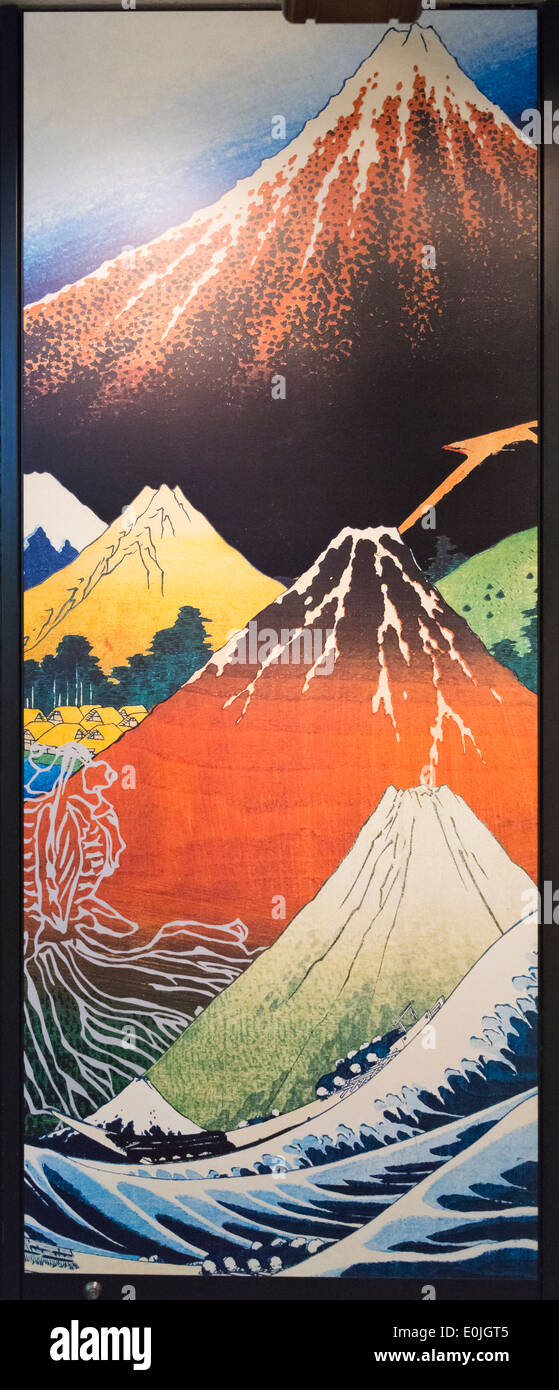 Ukiyo-e landscape painting depicting mountain, Japan Stock Photohttps://www.alamy.com/image-license-details/?v=1https://www.alamy.com/ukiyo-e-landscape-painting-depicting-mountain-japan-image69249829.html
Ukiyo-e landscape painting depicting mountain, Japan Stock Photohttps://www.alamy.com/image-license-details/?v=1https://www.alamy.com/ukiyo-e-landscape-painting-depicting-mountain-japan-image69249829.htmlRME0JGT5–Ukiyo-e landscape painting depicting mountain, Japan
 Ukiyo-e print - A woman holding a comb, c19th century. Artist: Kitagawa Utamaro. Stock Photohttps://www.alamy.com/image-license-details/?v=1https://www.alamy.com/ukiyo-e-print-a-woman-holding-a-comb-c19th-century-artist-kitagawa-utamaro-image186168684.html
Ukiyo-e print - A woman holding a comb, c19th century. Artist: Kitagawa Utamaro. Stock Photohttps://www.alamy.com/image-license-details/?v=1https://www.alamy.com/ukiyo-e-print-a-woman-holding-a-comb-c19th-century-artist-kitagawa-utamaro-image186168684.htmlRMMPTM1G–Ukiyo-e print - A woman holding a comb, c19th century. Artist: Kitagawa Utamaro.
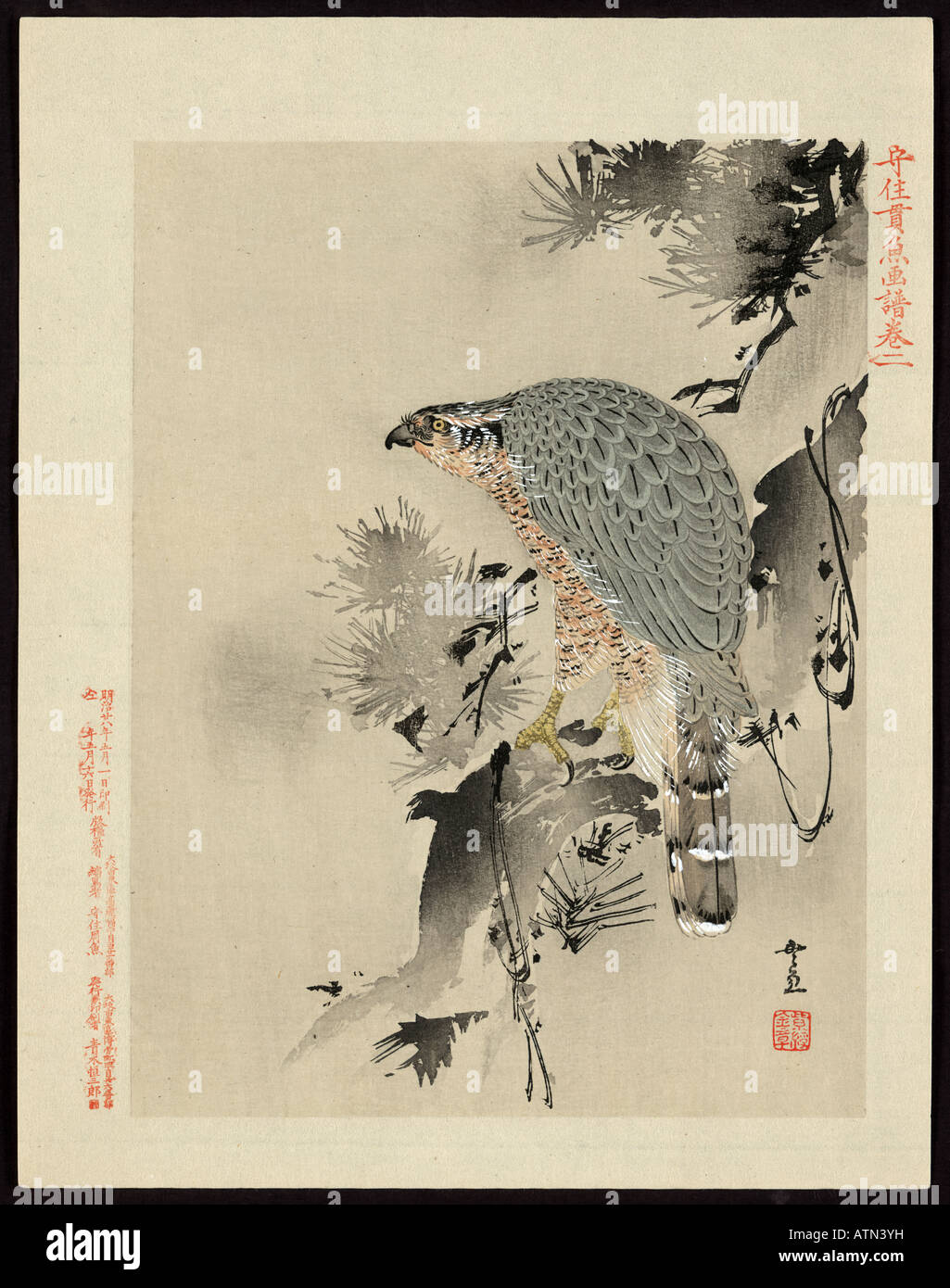 Japanese Ukiyo e print Stock Photohttps://www.alamy.com/image-license-details/?v=1https://www.alamy.com/stock-photo-japanese-ukiyo-e-print-16355572.html
Japanese Ukiyo e print Stock Photohttps://www.alamy.com/image-license-details/?v=1https://www.alamy.com/stock-photo-japanese-ukiyo-e-print-16355572.htmlRMATN3YH–Japanese Ukiyo e print
 Details of Ukiyo-e painting depicting Kabuki Characters, Minami-za Theatre, Kyoto Prefecture, Kinki Region, Honshu, Japan Stock Photohttps://www.alamy.com/image-license-details/?v=1https://www.alamy.com/stock-photo-details-of-ukiyo-e-painting-depicting-kabuki-characters-minami-za-37611481.html
Details of Ukiyo-e painting depicting Kabuki Characters, Minami-za Theatre, Kyoto Prefecture, Kinki Region, Honshu, Japan Stock Photohttps://www.alamy.com/image-license-details/?v=1https://www.alamy.com/stock-photo-details-of-ukiyo-e-painting-depicting-kabuki-characters-minami-za-37611481.htmlRMC559R5–Details of Ukiyo-e painting depicting Kabuki Characters, Minami-za Theatre, Kyoto Prefecture, Kinki Region, Honshu, Japan
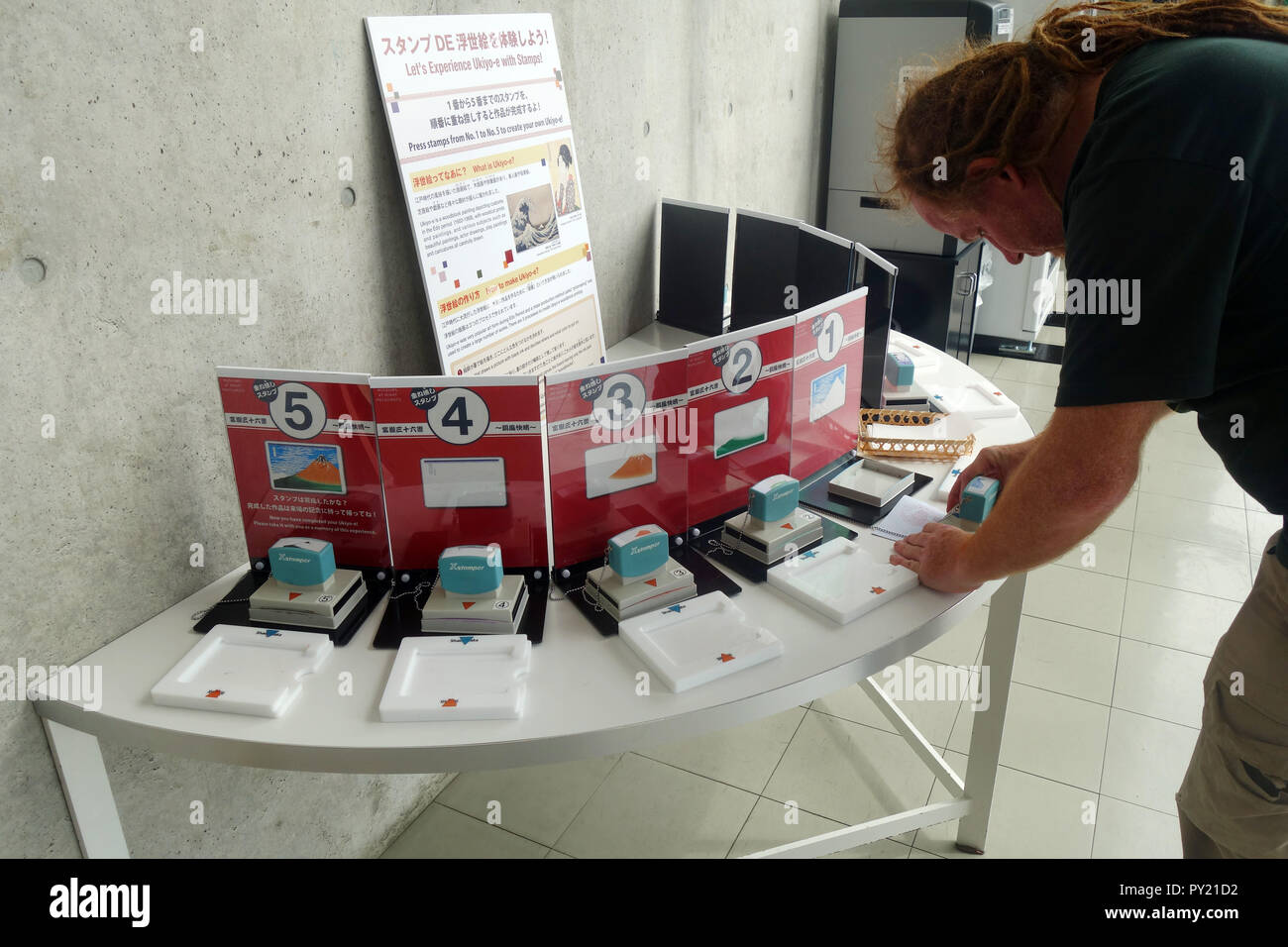 Special layered stamps for visitors that mimic woodblock printing process, Japan Ukiyo-e Museum, Matsumoto, Japan. No PR or MR Stock Photohttps://www.alamy.com/image-license-details/?v=1https://www.alamy.com/special-layered-stamps-for-visitors-that-mimic-woodblock-printing-process-japan-ukiyo-e-museum-matsumoto-japan-no-pr-or-mr-image223165182.html
Special layered stamps for visitors that mimic woodblock printing process, Japan Ukiyo-e Museum, Matsumoto, Japan. No PR or MR Stock Photohttps://www.alamy.com/image-license-details/?v=1https://www.alamy.com/special-layered-stamps-for-visitors-that-mimic-woodblock-printing-process-japan-ukiyo-e-museum-matsumoto-japan-no-pr-or-mr-image223165182.htmlRMPY21D2–Special layered stamps for visitors that mimic woodblock printing process, Japan Ukiyo-e Museum, Matsumoto, Japan. No PR or MR
 The Kyoto workshop of Japanese ukiyo-e artist and woodblock printer Mamoru Ichimura. Stock Photohttps://www.alamy.com/image-license-details/?v=1https://www.alamy.com/stock-photo-the-kyoto-workshop-of-japanese-ukiyo-e-artist-and-woodblock-printer-54199525.html
The Kyoto workshop of Japanese ukiyo-e artist and woodblock printer Mamoru Ichimura. Stock Photohttps://www.alamy.com/image-license-details/?v=1https://www.alamy.com/stock-photo-the-kyoto-workshop-of-japanese-ukiyo-e-artist-and-woodblock-printer-54199525.htmlRMD45019–The Kyoto workshop of Japanese ukiyo-e artist and woodblock printer Mamoru Ichimura.
 Japan, Tokyo, Ukiyo-e Style Artwork on Seafood Restaurant Facade Stock Photohttps://www.alamy.com/image-license-details/?v=1https://www.alamy.com/stock-photo-japan-tokyo-ukiyo-e-style-artwork-on-seafood-restaurant-facade-39615508.html
Japan, Tokyo, Ukiyo-e Style Artwork on Seafood Restaurant Facade Stock Photohttps://www.alamy.com/image-license-details/?v=1https://www.alamy.com/stock-photo-japan-tokyo-ukiyo-e-style-artwork-on-seafood-restaurant-facade-39615508.htmlRMC8CHYG–Japan, Tokyo, Ukiyo-e Style Artwork on Seafood Restaurant Facade
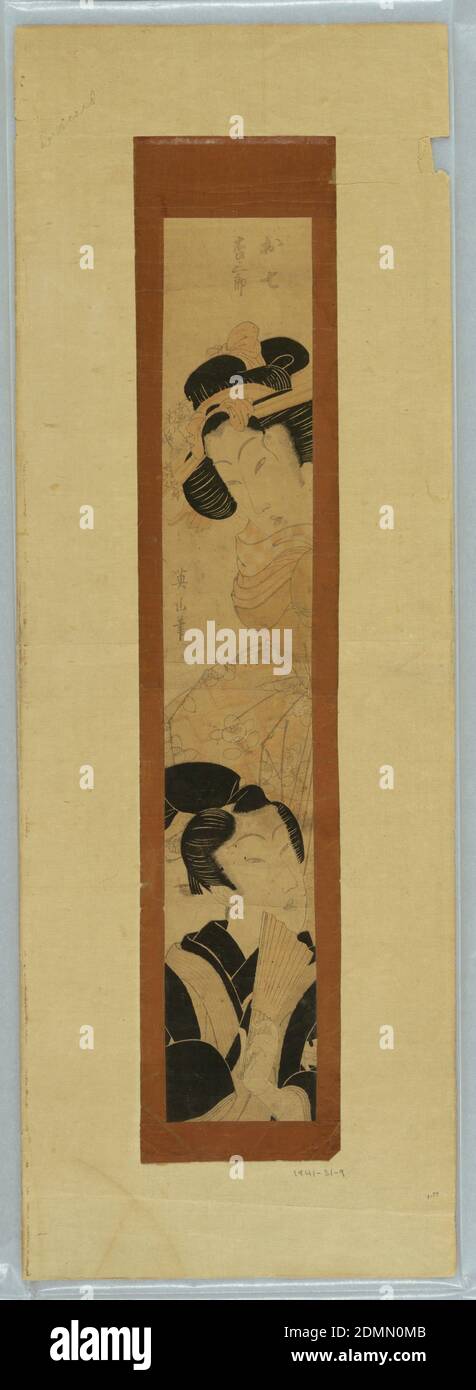 Two Actors, Kikugana Eizan, Woodblock print (ukiyo-e) on mulberry paper (washi), ink with color, Japan, ca. 1800, figures, Print Stock Photohttps://www.alamy.com/image-license-details/?v=1https://www.alamy.com/two-actors-kikugana-eizan-woodblock-print-ukiyo-e-on-mulberry-paper-washi-ink-with-color-japan-ca-1800-figures-print-image391382779.html
Two Actors, Kikugana Eizan, Woodblock print (ukiyo-e) on mulberry paper (washi), ink with color, Japan, ca. 1800, figures, Print Stock Photohttps://www.alamy.com/image-license-details/?v=1https://www.alamy.com/two-actors-kikugana-eizan-woodblock-print-ukiyo-e-on-mulberry-paper-washi-ink-with-color-japan-ca-1800-figures-print-image391382779.htmlRM2DMN0MB–Two Actors, Kikugana Eizan, Woodblock print (ukiyo-e) on mulberry paper (washi), ink with color, Japan, ca. 1800, figures, Print
 Inspired by Early Ukiyo-e Painting, Ink, color and gold on paper, Japan, 1625-1640, Edo Period, 10 7/16 x 13 13/16 in., 26.5 x 35.1 cm, Reimagined by Artotop. Classic art reinvented with a modern twist. Design of warm cheerful glowing of brightness and light ray radiance. Photography inspired by surrealism and futurism, embracing dynamic energy of modern technology, movement, speed and revolutionize culture Stock Photohttps://www.alamy.com/image-license-details/?v=1https://www.alamy.com/inspired-by-early-ukiyo-e-painting-ink-color-and-gold-on-paper-japan-1625-1640-edo-period-10-716-x-13-1316-in-265-x-351-cm-reimagined-by-artotop-classic-art-reinvented-with-a-modern-twist-design-of-warm-cheerful-glowing-of-brightness-and-light-ray-radiance-photography-inspired-by-surrealism-and-futurism-embracing-dynamic-energy-of-modern-technology-movement-speed-and-revolutionize-culture-image459263036.html
Inspired by Early Ukiyo-e Painting, Ink, color and gold on paper, Japan, 1625-1640, Edo Period, 10 7/16 x 13 13/16 in., 26.5 x 35.1 cm, Reimagined by Artotop. Classic art reinvented with a modern twist. Design of warm cheerful glowing of brightness and light ray radiance. Photography inspired by surrealism and futurism, embracing dynamic energy of modern technology, movement, speed and revolutionize culture Stock Photohttps://www.alamy.com/image-license-details/?v=1https://www.alamy.com/inspired-by-early-ukiyo-e-painting-ink-color-and-gold-on-paper-japan-1625-1640-edo-period-10-716-x-13-1316-in-265-x-351-cm-reimagined-by-artotop-classic-art-reinvented-with-a-modern-twist-design-of-warm-cheerful-glowing-of-brightness-and-light-ray-radiance-photography-inspired-by-surrealism-and-futurism-embracing-dynamic-energy-of-modern-technology-movement-speed-and-revolutionize-culture-image459263036.htmlRF2HK56K8–Inspired by Early Ukiyo-e Painting, Ink, color and gold on paper, Japan, 1625-1640, Edo Period, 10 7/16 x 13 13/16 in., 26.5 x 35.1 cm, Reimagined by Artotop. Classic art reinvented with a modern twist. Design of warm cheerful glowing of brightness and light ray radiance. Photography inspired by surrealism and futurism, embracing dynamic energy of modern technology, movement, speed and revolutionize culture
 Ukiyo-e beauty, half-length studio portrait of a woman, facing slightly right. Date ca. 1877. Stock Photohttps://www.alamy.com/image-license-details/?v=1https://www.alamy.com/stock-photo-ukiyo-e-beauty-half-length-studio-portrait-of-a-woman-facing-slightly-83179101.html
Ukiyo-e beauty, half-length studio portrait of a woman, facing slightly right. Date ca. 1877. Stock Photohttps://www.alamy.com/image-license-details/?v=1https://www.alamy.com/stock-photo-ukiyo-e-beauty-half-length-studio-portrait-of-a-woman-facing-slightly-83179101.htmlRMER93P5–Ukiyo-e beauty, half-length studio portrait of a woman, facing slightly right. Date ca. 1877.
 The actor Morika Kanya (kabuki Theartre), by T?sh?sai Sharaku (1794ñ1795); Japanese ukiyo-e print artist Stock Photohttps://www.alamy.com/image-license-details/?v=1https://www.alamy.com/the-actor-morika-kanya-kabuki-theartre-by-tshsai-sharaku-17941795-japanese-ukiyo-e-print-artist-image330678805.html
The actor Morika Kanya (kabuki Theartre), by T?sh?sai Sharaku (1794ñ1795); Japanese ukiyo-e print artist Stock Photohttps://www.alamy.com/image-license-details/?v=1https://www.alamy.com/the-actor-morika-kanya-kabuki-theartre-by-tshsai-sharaku-17941795-japanese-ukiyo-e-print-artist-image330678805.htmlRM2A5YM59–The actor Morika Kanya (kabuki Theartre), by T?sh?sai Sharaku (1794ñ1795); Japanese ukiyo-e print artist
 Mounted Russian Horseman Bids Adieu to Woman Stock Photohttps://www.alamy.com/image-license-details/?v=1https://www.alamy.com/stock-photo-mounted-russian-horseman-bids-adieu-to-woman-23915260.html
Mounted Russian Horseman Bids Adieu to Woman Stock Photohttps://www.alamy.com/image-license-details/?v=1https://www.alamy.com/stock-photo-mounted-russian-horseman-bids-adieu-to-woman-23915260.htmlRMBAWC4C–Mounted Russian Horseman Bids Adieu to Woman
 Woman of the nobility or courtier in silk kimono with cypress fan walking in a garden under cherry blossoms. Handcoloured ukiyo-e woodblock print by Toyokuni Utagawa from Shikitei Sanba’s Ehon Imayo Sugata (Picture Book of the Modern Forms and Figures, Tokyo, 1916. Reprint of the original from 1802. Stock Photohttps://www.alamy.com/image-license-details/?v=1https://www.alamy.com/woman-of-the-nobility-or-courtier-in-silk-kimono-with-cypress-fan-walking-in-a-garden-under-cherry-blossoms-handcoloured-ukiyo-e-woodblock-print-by-toyokuni-utagawa-from-shikitei-sanbas-ehon-imayo-sugata-picture-book-of-the-modern-forms-and-figures-tokyo-1916-reprint-of-the-original-from-1802-image273789408.html
Woman of the nobility or courtier in silk kimono with cypress fan walking in a garden under cherry blossoms. Handcoloured ukiyo-e woodblock print by Toyokuni Utagawa from Shikitei Sanba’s Ehon Imayo Sugata (Picture Book of the Modern Forms and Figures, Tokyo, 1916. Reprint of the original from 1802. Stock Photohttps://www.alamy.com/image-license-details/?v=1https://www.alamy.com/woman-of-the-nobility-or-courtier-in-silk-kimono-with-cypress-fan-walking-in-a-garden-under-cherry-blossoms-handcoloured-ukiyo-e-woodblock-print-by-toyokuni-utagawa-from-shikitei-sanbas-ehon-imayo-sugata-picture-book-of-the-modern-forms-and-figures-tokyo-1916-reprint-of-the-original-from-1802-image273789408.htmlRMWWC554–Woman of the nobility or courtier in silk kimono with cypress fan walking in a garden under cherry blossoms. Handcoloured ukiyo-e woodblock print by Toyokuni Utagawa from Shikitei Sanba’s Ehon Imayo Sugata (Picture Book of the Modern Forms and Figures, Tokyo, 1916. Reprint of the original from 1802.
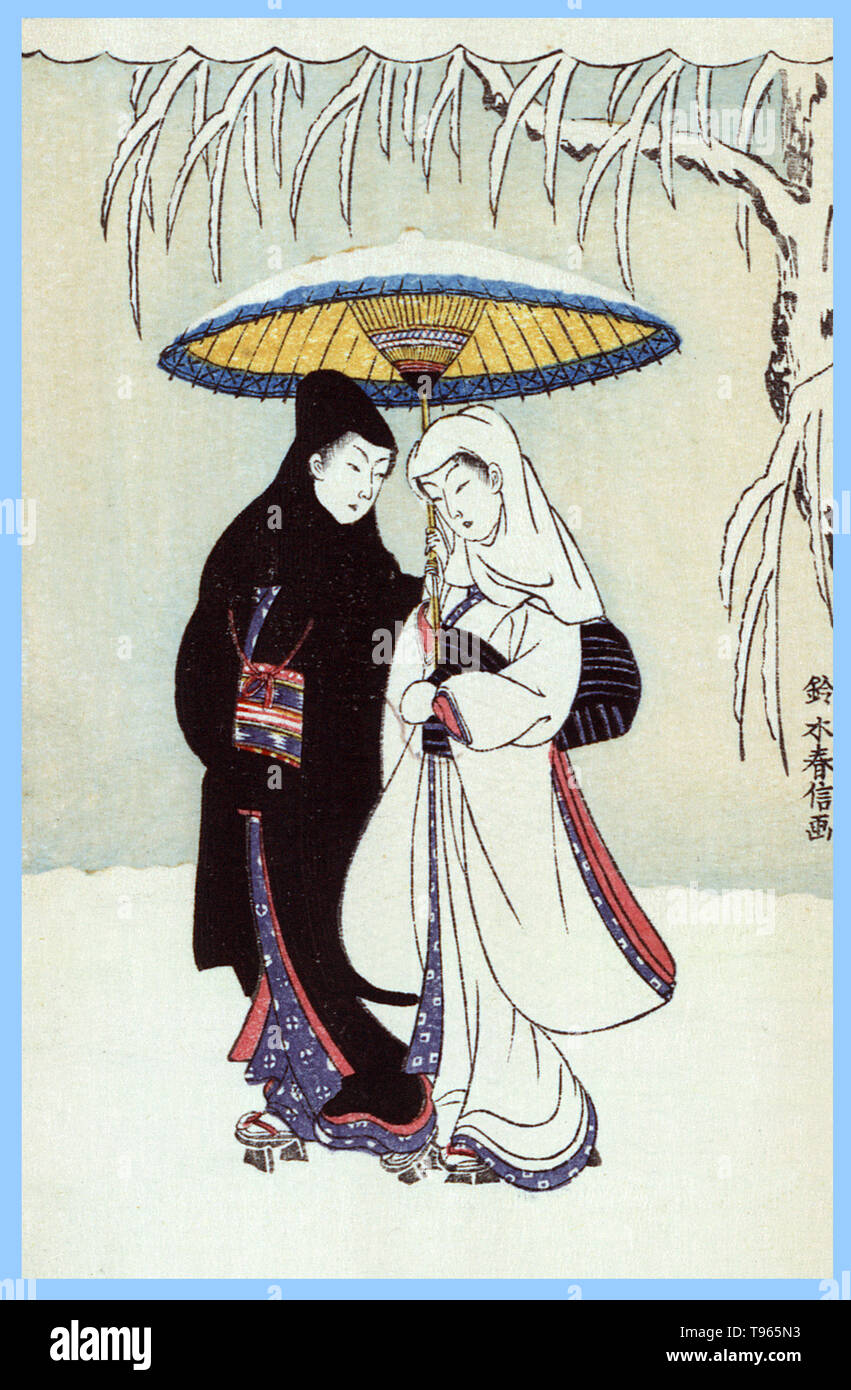 Secchu aiaigasa. Couple under umbrella in the snow (crow and heron). a man and a woman standing in the snow beneath a snow-covered umbrella. Ukiyo-e (picture of the floating world) is a genre of Japanese art which flourished from the 17th through 19th centuries. Ukiyo-e was central to forming the West's perception of Japanese art in the late 19th century. Stock Photohttps://www.alamy.com/image-license-details/?v=1https://www.alamy.com/secchu-aiaigasa-couple-under-umbrella-in-the-snow-crow-and-heron-a-man-and-a-woman-standing-in-the-snow-beneath-a-snow-covered-umbrella-ukiyo-e-picture-of-the-floating-world-is-a-genre-of-japanese-art-which-flourished-from-the-17th-through-19th-centuries-ukiyo-e-was-central-to-forming-the-wests-perception-of-japanese-art-in-the-late-19th-century-image246613279.html
Secchu aiaigasa. Couple under umbrella in the snow (crow and heron). a man and a woman standing in the snow beneath a snow-covered umbrella. Ukiyo-e (picture of the floating world) is a genre of Japanese art which flourished from the 17th through 19th centuries. Ukiyo-e was central to forming the West's perception of Japanese art in the late 19th century. Stock Photohttps://www.alamy.com/image-license-details/?v=1https://www.alamy.com/secchu-aiaigasa-couple-under-umbrella-in-the-snow-crow-and-heron-a-man-and-a-woman-standing-in-the-snow-beneath-a-snow-covered-umbrella-ukiyo-e-picture-of-the-floating-world-is-a-genre-of-japanese-art-which-flourished-from-the-17th-through-19th-centuries-ukiyo-e-was-central-to-forming-the-wests-perception-of-japanese-art-in-the-late-19th-century-image246613279.htmlRMT965N3–Secchu aiaigasa. Couple under umbrella in the snow (crow and heron). a man and a woman standing in the snow beneath a snow-covered umbrella. Ukiyo-e (picture of the floating world) is a genre of Japanese art which flourished from the 17th through 19th centuries. Ukiyo-e was central to forming the West's perception of Japanese art in the late 19th century.
 Katsushika Hokusai, was a Japanese artist, ukiyo-e painter and printmaker of the Edo period. Stock Photohttps://www.alamy.com/image-license-details/?v=1https://www.alamy.com/stock-photo-katsushika-hokusai-was-a-japanese-artist-ukiyo-e-painter-and-printmaker-29211075.html
Katsushika Hokusai, was a Japanese artist, ukiyo-e painter and printmaker of the Edo period. Stock Photohttps://www.alamy.com/image-license-details/?v=1https://www.alamy.com/stock-photo-katsushika-hokusai-was-a-japanese-artist-ukiyo-e-painter-and-printmaker-29211075.htmlRMBKEK0K–Katsushika Hokusai, was a Japanese artist, ukiyo-e painter and printmaker of the Edo period.
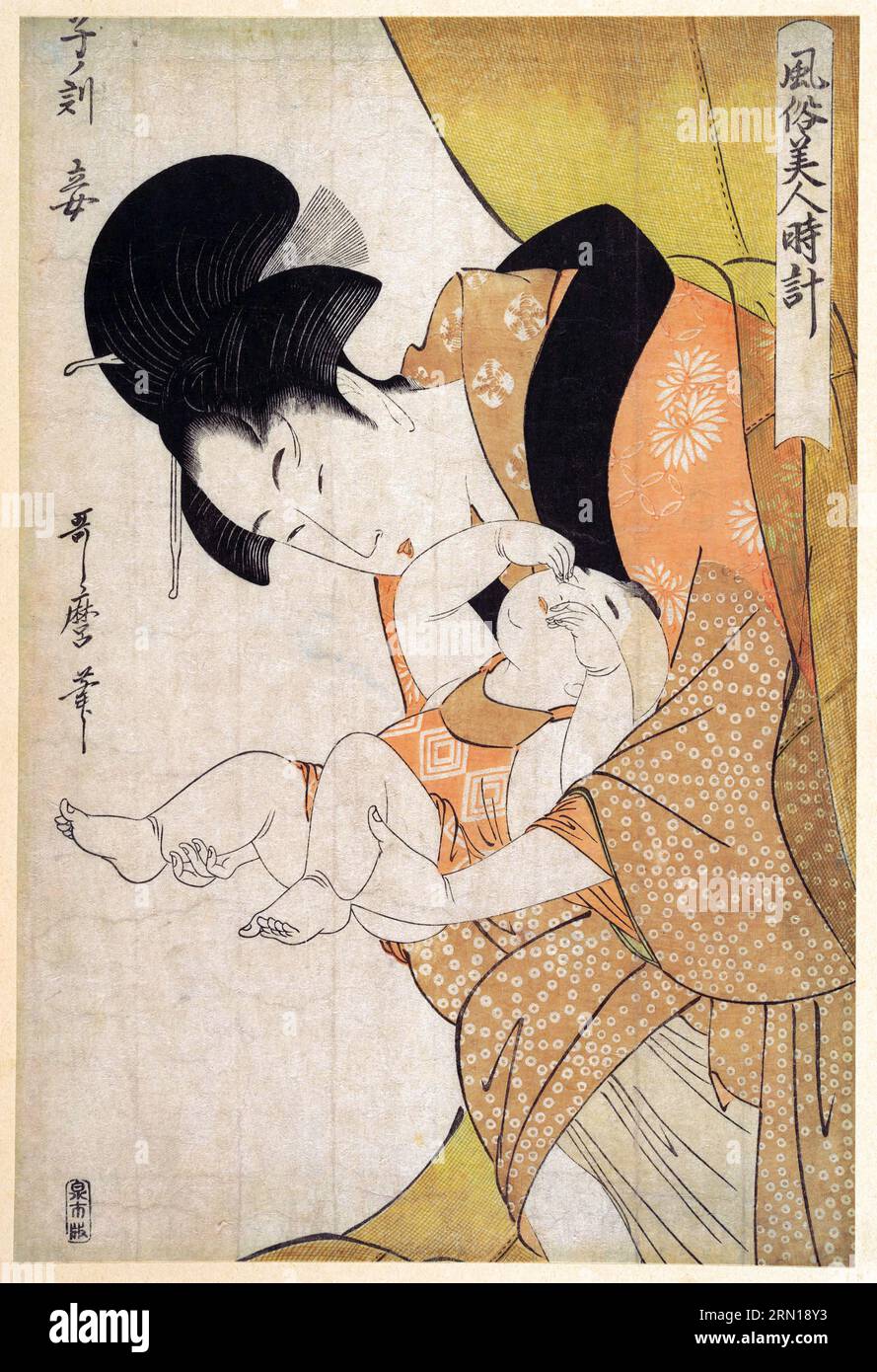 Japan: Midnight - Mother and Sleepy Child. Ukiyo-e woodblock print by Kitagawa Utamaro (c. 1753 - 31 October 1806), 1790. Kitagawa Utamaro was a Japanese printmaker and painter, who is considered one of the greatest artists of woodblock prints (ukiyo-e). He is known especially for his masterfully composed studies of women, known as bijinga. He also produced nature studies, particularly illustrated books of insects. Stock Photohttps://www.alamy.com/image-license-details/?v=1https://www.alamy.com/japan-midnight-mother-and-sleepy-child-ukiyo-e-woodblock-print-by-kitagawa-utamaro-c-1753-31-october-1806-1790-kitagawa-utamaro-was-a-japanese-printmaker-and-painter-who-is-considered-one-of-the-greatest-artists-of-woodblock-prints-ukiyo-e-he-is-known-especially-for-his-masterfully-composed-studies-of-women-known-as-bijinga-he-also-produced-nature-studies-particularly-illustrated-books-of-insects-image563668535.html
Japan: Midnight - Mother and Sleepy Child. Ukiyo-e woodblock print by Kitagawa Utamaro (c. 1753 - 31 October 1806), 1790. Kitagawa Utamaro was a Japanese printmaker and painter, who is considered one of the greatest artists of woodblock prints (ukiyo-e). He is known especially for his masterfully composed studies of women, known as bijinga. He also produced nature studies, particularly illustrated books of insects. Stock Photohttps://www.alamy.com/image-license-details/?v=1https://www.alamy.com/japan-midnight-mother-and-sleepy-child-ukiyo-e-woodblock-print-by-kitagawa-utamaro-c-1753-31-october-1806-1790-kitagawa-utamaro-was-a-japanese-printmaker-and-painter-who-is-considered-one-of-the-greatest-artists-of-woodblock-prints-ukiyo-e-he-is-known-especially-for-his-masterfully-composed-studies-of-women-known-as-bijinga-he-also-produced-nature-studies-particularly-illustrated-books-of-insects-image563668535.htmlRM2RN18Y3–Japan: Midnight - Mother and Sleepy Child. Ukiyo-e woodblock print by Kitagawa Utamaro (c. 1753 - 31 October 1806), 1790. Kitagawa Utamaro was a Japanese printmaker and painter, who is considered one of the greatest artists of woodblock prints (ukiyo-e). He is known especially for his masterfully composed studies of women, known as bijinga. He also produced nature studies, particularly illustrated books of insects.
 Japanese Ukiyo-e print text, describing English people and their customs, economy, and other practical matters from a Japanese perspective. 1854 Stock Photohttps://www.alamy.com/image-license-details/?v=1https://www.alamy.com/stock-photo-japanese-ukiyo-e-print-text-describing-english-people-and-their-customs-84977557.html
Japanese Ukiyo-e print text, describing English people and their customs, economy, and other practical matters from a Japanese perspective. 1854 Stock Photohttps://www.alamy.com/image-license-details/?v=1https://www.alamy.com/stock-photo-japanese-ukiyo-e-print-text-describing-english-people-and-their-customs-84977557.htmlRMEX71MN–Japanese Ukiyo-e print text, describing English people and their customs, economy, and other practical matters from a Japanese perspective. 1854
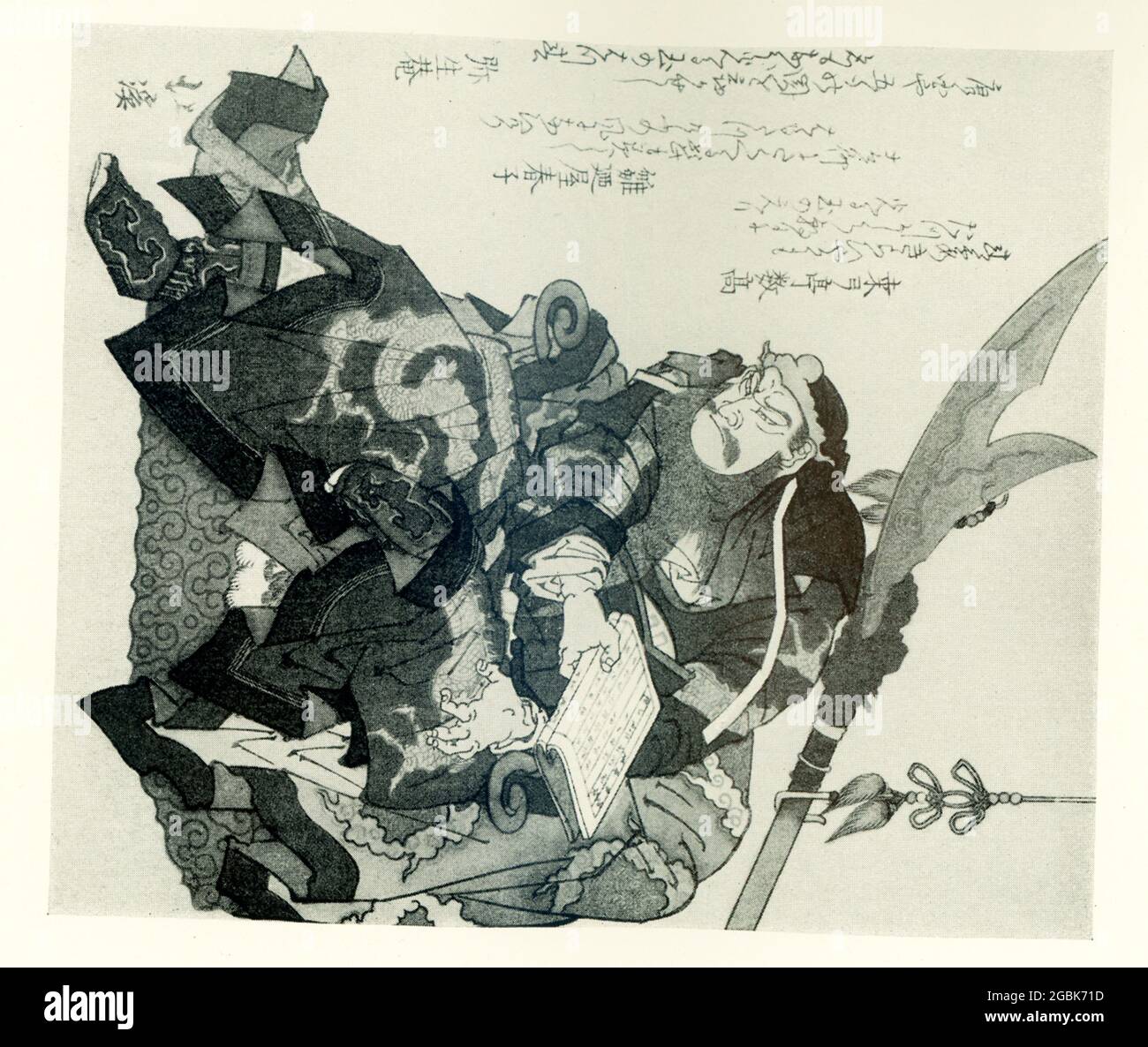 The 1920 caption reads: “Surimono: Kwanyu studying a book on strategy. It is signed by Hokkei.” Totoya Hokkei (1780–1850) was a Japanese artist best known for his prints in the ukiyo-e style. Stock Photohttps://www.alamy.com/image-license-details/?v=1https://www.alamy.com/the-1920-caption-reads-surimono-kwanyu-studying-a-book-on-strategy-it-is-signed-by-hokkei-totoya-hokkei17801850was-a-japanese-artist-best-known-for-his-prints-in-the-ukiyo-e-style-image437443033.html
The 1920 caption reads: “Surimono: Kwanyu studying a book on strategy. It is signed by Hokkei.” Totoya Hokkei (1780–1850) was a Japanese artist best known for his prints in the ukiyo-e style. Stock Photohttps://www.alamy.com/image-license-details/?v=1https://www.alamy.com/the-1920-caption-reads-surimono-kwanyu-studying-a-book-on-strategy-it-is-signed-by-hokkei-totoya-hokkei17801850was-a-japanese-artist-best-known-for-his-prints-in-the-ukiyo-e-style-image437443033.htmlRF2GBK71D–The 1920 caption reads: “Surimono: Kwanyu studying a book on strategy. It is signed by Hokkei.” Totoya Hokkei (1780–1850) was a Japanese artist best known for his prints in the ukiyo-e style.
 Japanese Ukiyo e print Japan Japanese crossing bamboo wood wooden bridge rain downpour shower wet deluge river cross rice paper Stock Photohttps://www.alamy.com/image-license-details/?v=1https://www.alamy.com/stock-photo-japanese-ukiyo-e-print-japan-japanese-crossing-bamboo-wood-wooden-15639532.html
Japanese Ukiyo e print Japan Japanese crossing bamboo wood wooden bridge rain downpour shower wet deluge river cross rice paper Stock Photohttps://www.alamy.com/image-license-details/?v=1https://www.alamy.com/stock-photo-japanese-ukiyo-e-print-japan-japanese-crossing-bamboo-wood-wooden-15639532.htmlRMAP10WH–Japanese Ukiyo e print Japan Japanese crossing bamboo wood wooden bridge rain downpour shower wet deluge river cross rice paper
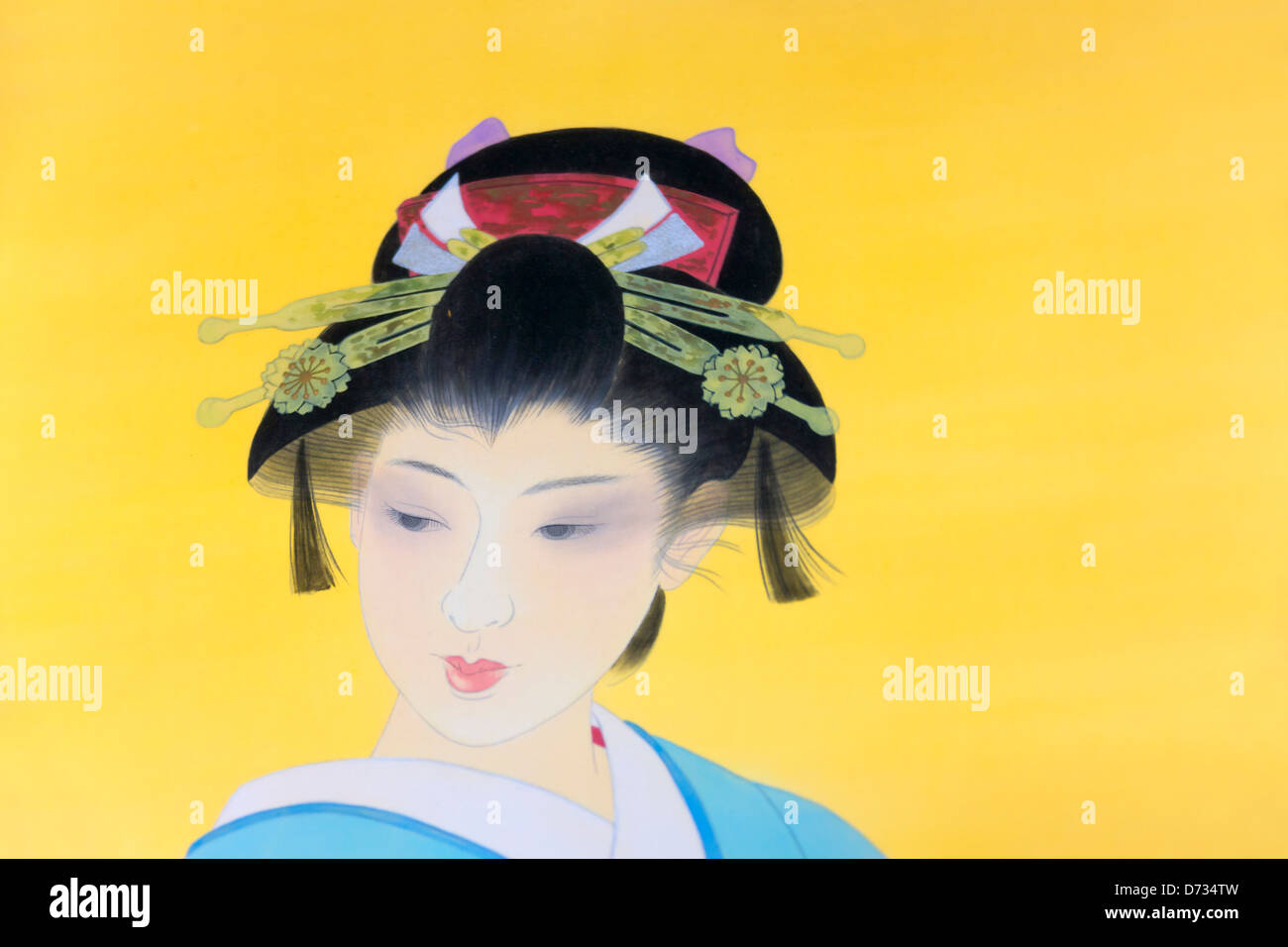 Ukiyo-e wood block prints of traditional Japanese ladies, Japan Stock Photohttps://www.alamy.com/image-license-details/?v=1https://www.alamy.com/stock-photo-ukiyo-e-wood-block-prints-of-traditional-japanese-ladies-japan-56003385.html
Ukiyo-e wood block prints of traditional Japanese ladies, Japan Stock Photohttps://www.alamy.com/image-license-details/?v=1https://www.alamy.com/stock-photo-ukiyo-e-wood-block-prints-of-traditional-japanese-ladies-japan-56003385.htmlRMD734TW–Ukiyo-e wood block prints of traditional Japanese ladies, Japan
 Ukiyo-e print - Bird on a branch in blue, c1820-1858. Artist: Ando Hiroshige. Stock Photohttps://www.alamy.com/image-license-details/?v=1https://www.alamy.com/ukiyo-e-print-bird-on-a-branch-in-blue-c1820-1858-artist-ando-hiroshige-image186168685.html
Ukiyo-e print - Bird on a branch in blue, c1820-1858. Artist: Ando Hiroshige. Stock Photohttps://www.alamy.com/image-license-details/?v=1https://www.alamy.com/ukiyo-e-print-bird-on-a-branch-in-blue-c1820-1858-artist-ando-hiroshige-image186168685.htmlRMMPTM1H–Ukiyo-e print - Bird on a branch in blue, c1820-1858. Artist: Ando Hiroshige.
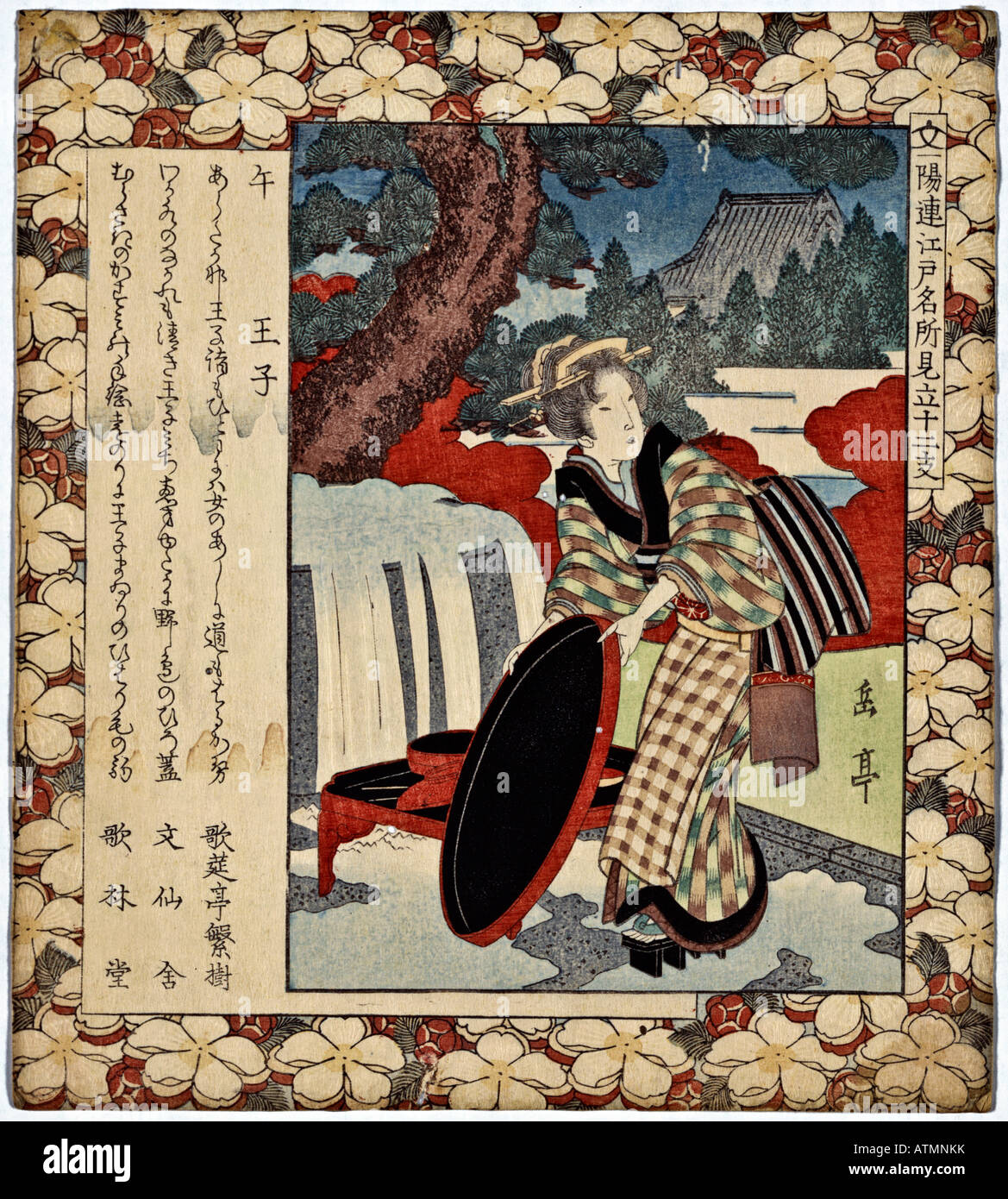 Japanese Ukiyo e print Stock Photohttps://www.alamy.com/image-license-details/?v=1https://www.alamy.com/stock-photo-japanese-ukiyo-e-print-16352118.html
Japanese Ukiyo e print Stock Photohttps://www.alamy.com/image-license-details/?v=1https://www.alamy.com/stock-photo-japanese-ukiyo-e-print-16352118.htmlRMATMNKK–Japanese Ukiyo e print
 Original Japanese Ukiyo-e Woodblock Print by TOYOKUNI 18th Century Stock Photohttps://www.alamy.com/image-license-details/?v=1https://www.alamy.com/original-japanese-ukiyo-e-woodblock-print-by-toyokuni-18th-century-image623917834.html
Original Japanese Ukiyo-e Woodblock Print by TOYOKUNI 18th Century Stock Photohttps://www.alamy.com/image-license-details/?v=1https://www.alamy.com/original-japanese-ukiyo-e-woodblock-print-by-toyokuni-18th-century-image623917834.htmlRM2Y71WFP–Original Japanese Ukiyo-e Woodblock Print by TOYOKUNI 18th Century
 World's smallest Ukiyo-e museum, Gion, Kyoto, Japan. No PR Stock Photohttps://www.alamy.com/image-license-details/?v=1https://www.alamy.com/worlds-smallest-ukiyo-e-museum-gion-kyoto-japan-no-pr-image219596318.html
World's smallest Ukiyo-e museum, Gion, Kyoto, Japan. No PR Stock Photohttps://www.alamy.com/image-license-details/?v=1https://www.alamy.com/worlds-smallest-ukiyo-e-museum-gion-kyoto-japan-no-pr-image219596318.htmlRMPN7D9J–World's smallest Ukiyo-e museum, Gion, Kyoto, Japan. No PR
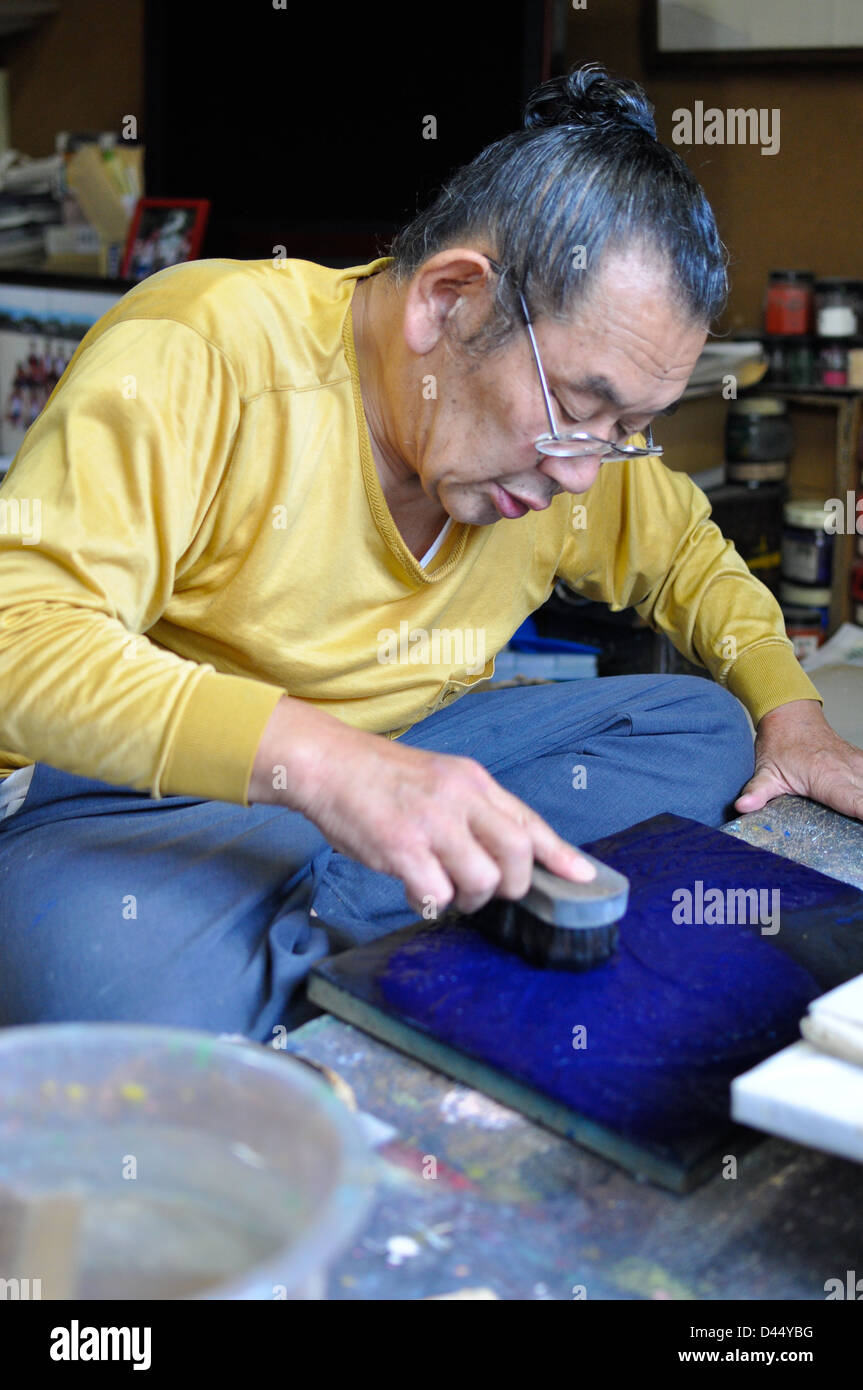 The Kyoto workshop of Japanese ukiyo-e artist and woodblock printer Mamoru Ichimura. Stock Photohttps://www.alamy.com/image-license-details/?v=1https://www.alamy.com/stock-photo-the-kyoto-workshop-of-japanese-ukiyo-e-artist-and-woodblock-printer-54199028.html
The Kyoto workshop of Japanese ukiyo-e artist and woodblock printer Mamoru Ichimura. Stock Photohttps://www.alamy.com/image-license-details/?v=1https://www.alamy.com/stock-photo-the-kyoto-workshop-of-japanese-ukiyo-e-artist-and-woodblock-printer-54199028.htmlRMD44YBG–The Kyoto workshop of Japanese ukiyo-e artist and woodblock printer Mamoru Ichimura.
 Japan, Tokyo, Ukiyo-e Style Artwork on Seafood Restaurant Facade Stock Photohttps://www.alamy.com/image-license-details/?v=1https://www.alamy.com/stock-photo-japan-tokyo-ukiyo-e-style-artwork-on-seafood-restaurant-facade-39615525.html
Japan, Tokyo, Ukiyo-e Style Artwork on Seafood Restaurant Facade Stock Photohttps://www.alamy.com/image-license-details/?v=1https://www.alamy.com/stock-photo-japan-tokyo-ukiyo-e-style-artwork-on-seafood-restaurant-facade-39615525.htmlRMC8CJ05–Japan, Tokyo, Ukiyo-e Style Artwork on Seafood Restaurant Facade
 Kites at Tsuiji, Katsushika Hokusai, 1760 – 1849, Woodblock print (ukiyo-e) on mulberry paper (washi), ink with color, Japan, 1760-1849, landscapes, Print Stock Photohttps://www.alamy.com/image-license-details/?v=1https://www.alamy.com/kites-at-tsuiji-katsushika-hokusai-1760-1849-woodblock-print-ukiyo-e-on-mulberry-paper-washi-ink-with-color-japan-1760-1849-landscapes-print-image391118516.html
Kites at Tsuiji, Katsushika Hokusai, 1760 – 1849, Woodblock print (ukiyo-e) on mulberry paper (washi), ink with color, Japan, 1760-1849, landscapes, Print Stock Photohttps://www.alamy.com/image-license-details/?v=1https://www.alamy.com/kites-at-tsuiji-katsushika-hokusai-1760-1849-woodblock-print-ukiyo-e-on-mulberry-paper-washi-ink-with-color-japan-1760-1849-landscapes-print-image391118516.htmlRM2DM8YJC–Kites at Tsuiji, Katsushika Hokusai, 1760 – 1849, Woodblock print (ukiyo-e) on mulberry paper (washi), ink with color, Japan, 1760-1849, landscapes, Print
 Inspired by Actor Onoe Kikugorō III as Sugawara Michizane, Ukiyo Shigekatsu, Japanese, active ca. 1820, Woodblock print with metallic ink, Japan, 1820, Edo period, 8 1/2 x 7 1/2 in., 21.6 x 19.1 cm, Reimagined by Artotop. Classic art reinvented with a modern twist. Design of warm cheerful glowing of brightness and light ray radiance. Photography inspired by surrealism and futurism, embracing dynamic energy of modern technology, movement, speed and revolutionize culture Stock Photohttps://www.alamy.com/image-license-details/?v=1https://www.alamy.com/inspired-by-actor-onoe-kikugor-iii-as-sugawara-michizane-ukiyo-shigekatsu-japanese-active-ca-1820-woodblock-print-with-metallic-ink-japan-1820-edo-period-8-12-x-7-12-in-216-x-191-cm-reimagined-by-artotop-classic-art-reinvented-with-a-modern-twist-design-of-warm-cheerful-glowing-of-brightness-and-light-ray-radiance-photography-inspired-by-surrealism-and-futurism-embracing-dynamic-energy-of-modern-technology-movement-speed-and-revolutionize-culture-image459259759.html
Inspired by Actor Onoe Kikugorō III as Sugawara Michizane, Ukiyo Shigekatsu, Japanese, active ca. 1820, Woodblock print with metallic ink, Japan, 1820, Edo period, 8 1/2 x 7 1/2 in., 21.6 x 19.1 cm, Reimagined by Artotop. Classic art reinvented with a modern twist. Design of warm cheerful glowing of brightness and light ray radiance. Photography inspired by surrealism and futurism, embracing dynamic energy of modern technology, movement, speed and revolutionize culture Stock Photohttps://www.alamy.com/image-license-details/?v=1https://www.alamy.com/inspired-by-actor-onoe-kikugor-iii-as-sugawara-michizane-ukiyo-shigekatsu-japanese-active-ca-1820-woodblock-print-with-metallic-ink-japan-1820-edo-period-8-12-x-7-12-in-216-x-191-cm-reimagined-by-artotop-classic-art-reinvented-with-a-modern-twist-design-of-warm-cheerful-glowing-of-brightness-and-light-ray-radiance-photography-inspired-by-surrealism-and-futurism-embracing-dynamic-energy-of-modern-technology-movement-speed-and-revolutionize-culture-image459259759.htmlRF2HK52E7–Inspired by Actor Onoe Kikugorō III as Sugawara Michizane, Ukiyo Shigekatsu, Japanese, active ca. 1820, Woodblock print with metallic ink, Japan, 1820, Edo period, 8 1/2 x 7 1/2 in., 21.6 x 19.1 cm, Reimagined by Artotop. Classic art reinvented with a modern twist. Design of warm cheerful glowing of brightness and light ray radiance. Photography inspired by surrealism and futurism, embracing dynamic energy of modern technology, movement, speed and revolutionize culture
 Yama-chichi kills man in sleep. Ukiyo-e print illustration showing scene from traditional tale in which a Yeti-like creature inhales the life force from sleeping travelers; opposite page contains text; covers from other volumes also shown. Date 1841. Stock Photohttps://www.alamy.com/image-license-details/?v=1https://www.alamy.com/stock-photo-yama-chichi-kills-man-in-sleep-ukiyo-e-print-illustration-showing-83148385.html
Yama-chichi kills man in sleep. Ukiyo-e print illustration showing scene from traditional tale in which a Yeti-like creature inhales the life force from sleeping travelers; opposite page contains text; covers from other volumes also shown. Date 1841. Stock Photohttps://www.alamy.com/image-license-details/?v=1https://www.alamy.com/stock-photo-yama-chichi-kills-man-in-sleep-ukiyo-e-print-illustration-showing-83148385.htmlRMER7MH5–Yama-chichi kills man in sleep. Ukiyo-e print illustration showing scene from traditional tale in which a Yeti-like creature inhales the life force from sleeping travelers; opposite page contains text; covers from other volumes also shown. Date 1841.
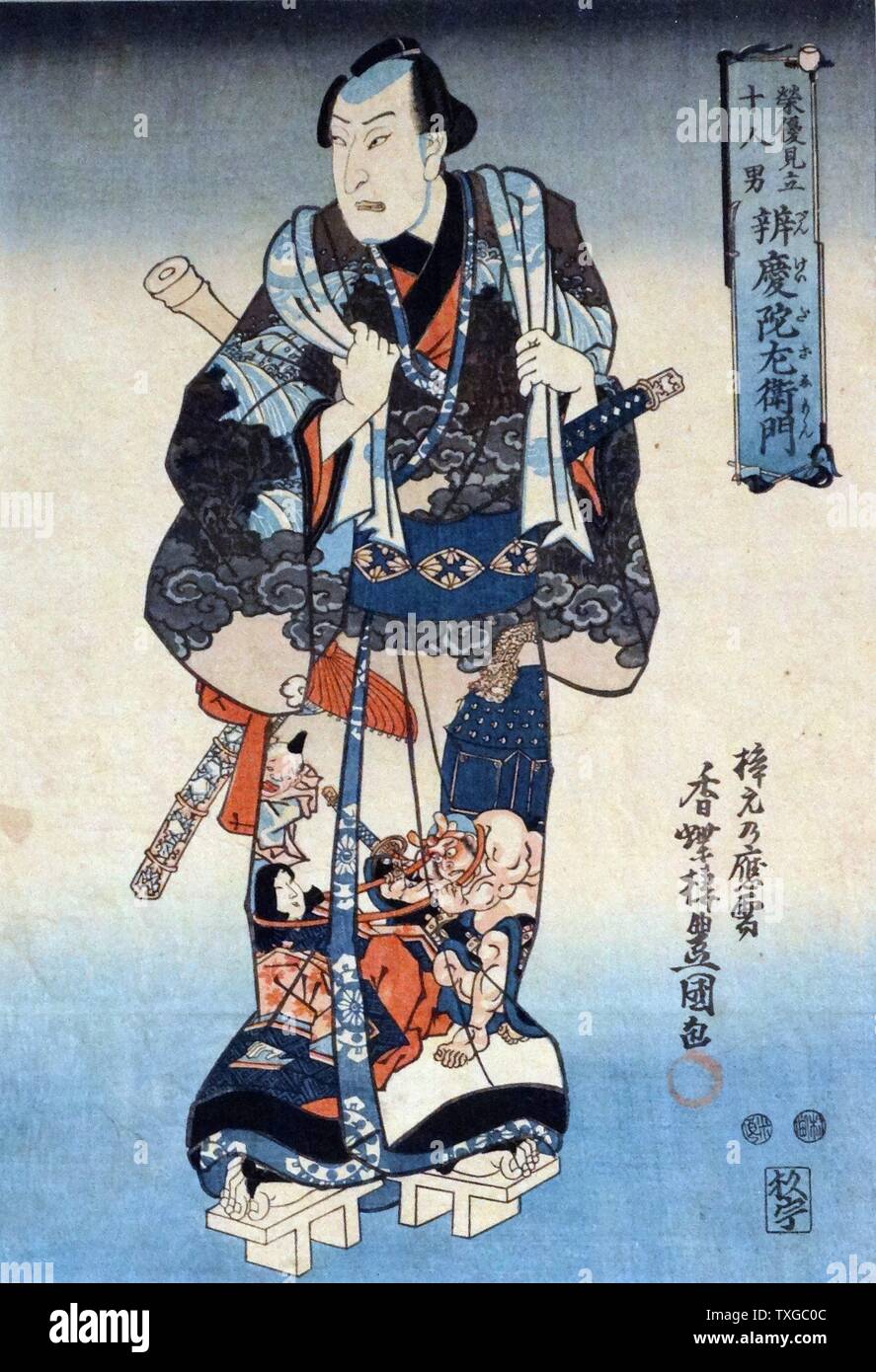 Benkei Dazaemon by Utagawa Kunisada (1786-1865) Japanese designer of ukiyo-e woodblock prints. Dated 1820 Stock Photohttps://www.alamy.com/image-license-details/?v=1https://www.alamy.com/benkei-dazaemon-by-utagawa-kunisada-1786-1865-japanese-designer-of-ukiyo-e-woodblock-prints-dated-1820-image257286860.html
Benkei Dazaemon by Utagawa Kunisada (1786-1865) Japanese designer of ukiyo-e woodblock prints. Dated 1820 Stock Photohttps://www.alamy.com/image-license-details/?v=1https://www.alamy.com/benkei-dazaemon-by-utagawa-kunisada-1786-1865-japanese-designer-of-ukiyo-e-woodblock-prints-dated-1820-image257286860.htmlRMTXGC0C–Benkei Dazaemon by Utagawa Kunisada (1786-1865) Japanese designer of ukiyo-e woodblock prints. Dated 1820
 Chinese Ship with Sails Stock Photohttps://www.alamy.com/image-license-details/?v=1https://www.alamy.com/stock-photo-chinese-ship-with-sails-23915210.html
Chinese Ship with Sails Stock Photohttps://www.alamy.com/image-license-details/?v=1https://www.alamy.com/stock-photo-chinese-ship-with-sails-23915210.htmlRMBAWC2J–Chinese Ship with Sails
 Edo street scene, 18th century. A dance teacher and pupil on the left, a nori (glue) seller is beckoned by workers in a small family business. Handcoloured ukiyo-e woodblock print by Toyokuni Utagawa from Shikitei Sanba’s Ehon Imayo Sugata (Picture Book of the Modern Forms and Figures, Tokyo, 1916. Reprint of the original from 1802. Stock Photohttps://www.alamy.com/image-license-details/?v=1https://www.alamy.com/edo-street-scene-18th-century-a-dance-teacher-and-pupil-on-the-left-a-nori-glue-seller-is-beckoned-by-workers-in-a-small-family-business-handcoloured-ukiyo-e-woodblock-print-by-toyokuni-utagawa-from-shikitei-sanbas-ehon-imayo-sugata-picture-book-of-the-modern-forms-and-figures-tokyo-1916-reprint-of-the-original-from-1802-image273789477.html
Edo street scene, 18th century. A dance teacher and pupil on the left, a nori (glue) seller is beckoned by workers in a small family business. Handcoloured ukiyo-e woodblock print by Toyokuni Utagawa from Shikitei Sanba’s Ehon Imayo Sugata (Picture Book of the Modern Forms and Figures, Tokyo, 1916. Reprint of the original from 1802. Stock Photohttps://www.alamy.com/image-license-details/?v=1https://www.alamy.com/edo-street-scene-18th-century-a-dance-teacher-and-pupil-on-the-left-a-nori-glue-seller-is-beckoned-by-workers-in-a-small-family-business-handcoloured-ukiyo-e-woodblock-print-by-toyokuni-utagawa-from-shikitei-sanbas-ehon-imayo-sugata-picture-book-of-the-modern-forms-and-figures-tokyo-1916-reprint-of-the-original-from-1802-image273789477.htmlRMWWC57H–Edo street scene, 18th century. A dance teacher and pupil on the left, a nori (glue) seller is beckoned by workers in a small family business. Handcoloured ukiyo-e woodblock print by Toyokuni Utagawa from Shikitei Sanba’s Ehon Imayo Sugata (Picture Book of the Modern Forms and Figures, Tokyo, 1916. Reprint of the original from 1802.
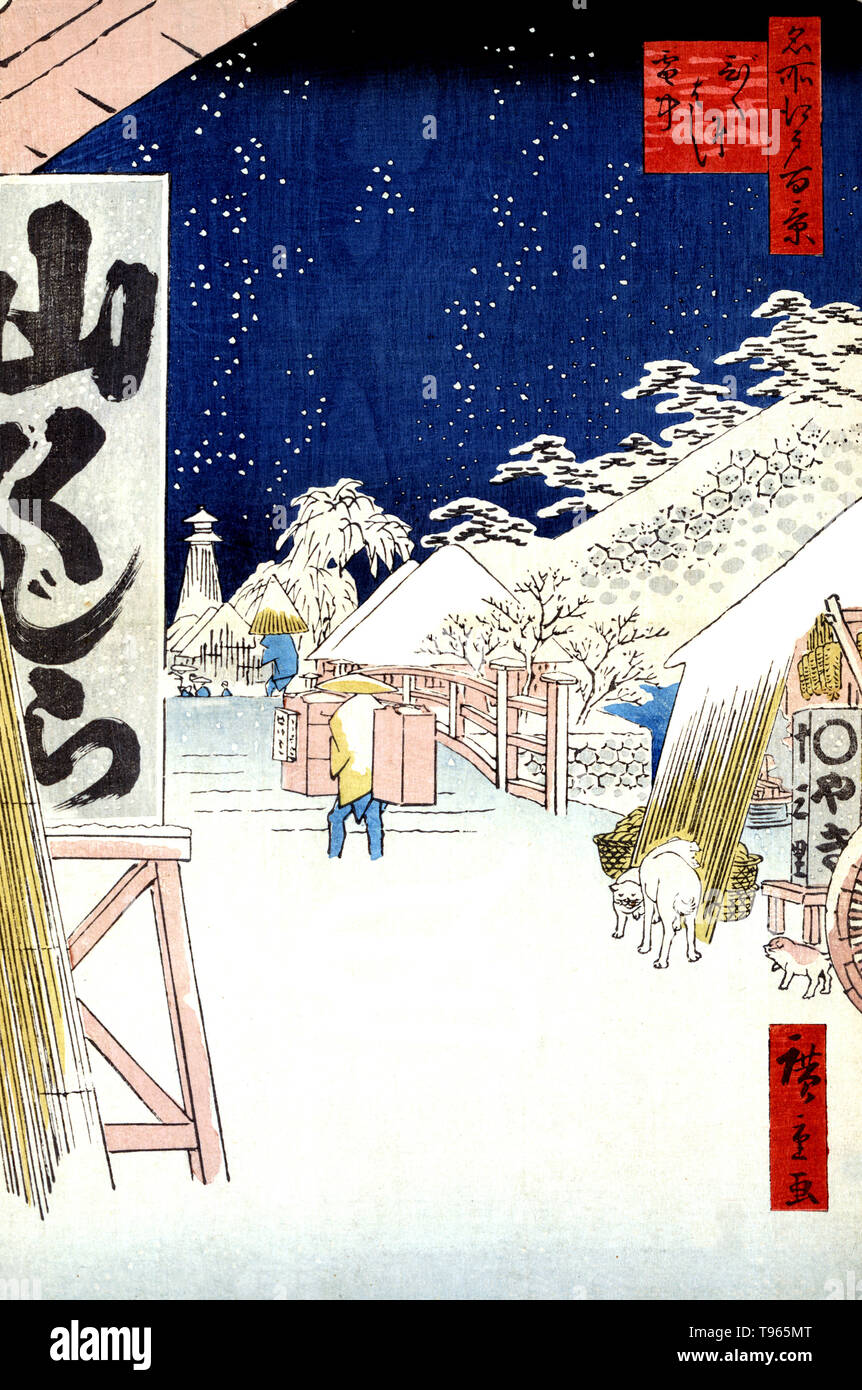 Bikunibashi setchu. Bikuni bridge in snow. Porter walking in ankle-deep snow at the approach to the Bikuni bridge. Ukiyo-e (picture of the floating world) is a genre of Japanese art which flourished from the 17th through 19th centuries. Ukiyo-e was central to forming the West's perception of Japanese art in the late 19th century. The landscape genre has come to dominate Western perceptions of ukiyo-e. Stock Photohttps://www.alamy.com/image-license-details/?v=1https://www.alamy.com/bikunibashi-setchu-bikuni-bridge-in-snow-porter-walking-in-ankle-deep-snow-at-the-approach-to-the-bikuni-bridge-ukiyo-e-picture-of-the-floating-world-is-a-genre-of-japanese-art-which-flourished-from-the-17th-through-19th-centuries-ukiyo-e-was-central-to-forming-the-wests-perception-of-japanese-art-in-the-late-19th-century-the-landscape-genre-has-come-to-dominate-western-perceptions-of-ukiyo-e-image246613272.html
Bikunibashi setchu. Bikuni bridge in snow. Porter walking in ankle-deep snow at the approach to the Bikuni bridge. Ukiyo-e (picture of the floating world) is a genre of Japanese art which flourished from the 17th through 19th centuries. Ukiyo-e was central to forming the West's perception of Japanese art in the late 19th century. The landscape genre has come to dominate Western perceptions of ukiyo-e. Stock Photohttps://www.alamy.com/image-license-details/?v=1https://www.alamy.com/bikunibashi-setchu-bikuni-bridge-in-snow-porter-walking-in-ankle-deep-snow-at-the-approach-to-the-bikuni-bridge-ukiyo-e-picture-of-the-floating-world-is-a-genre-of-japanese-art-which-flourished-from-the-17th-through-19th-centuries-ukiyo-e-was-central-to-forming-the-wests-perception-of-japanese-art-in-the-late-19th-century-the-landscape-genre-has-come-to-dominate-western-perceptions-of-ukiyo-e-image246613272.htmlRMT965MT–Bikunibashi setchu. Bikuni bridge in snow. Porter walking in ankle-deep snow at the approach to the Bikuni bridge. Ukiyo-e (picture of the floating world) is a genre of Japanese art which flourished from the 17th through 19th centuries. Ukiyo-e was central to forming the West's perception of Japanese art in the late 19th century. The landscape genre has come to dominate Western perceptions of ukiyo-e.
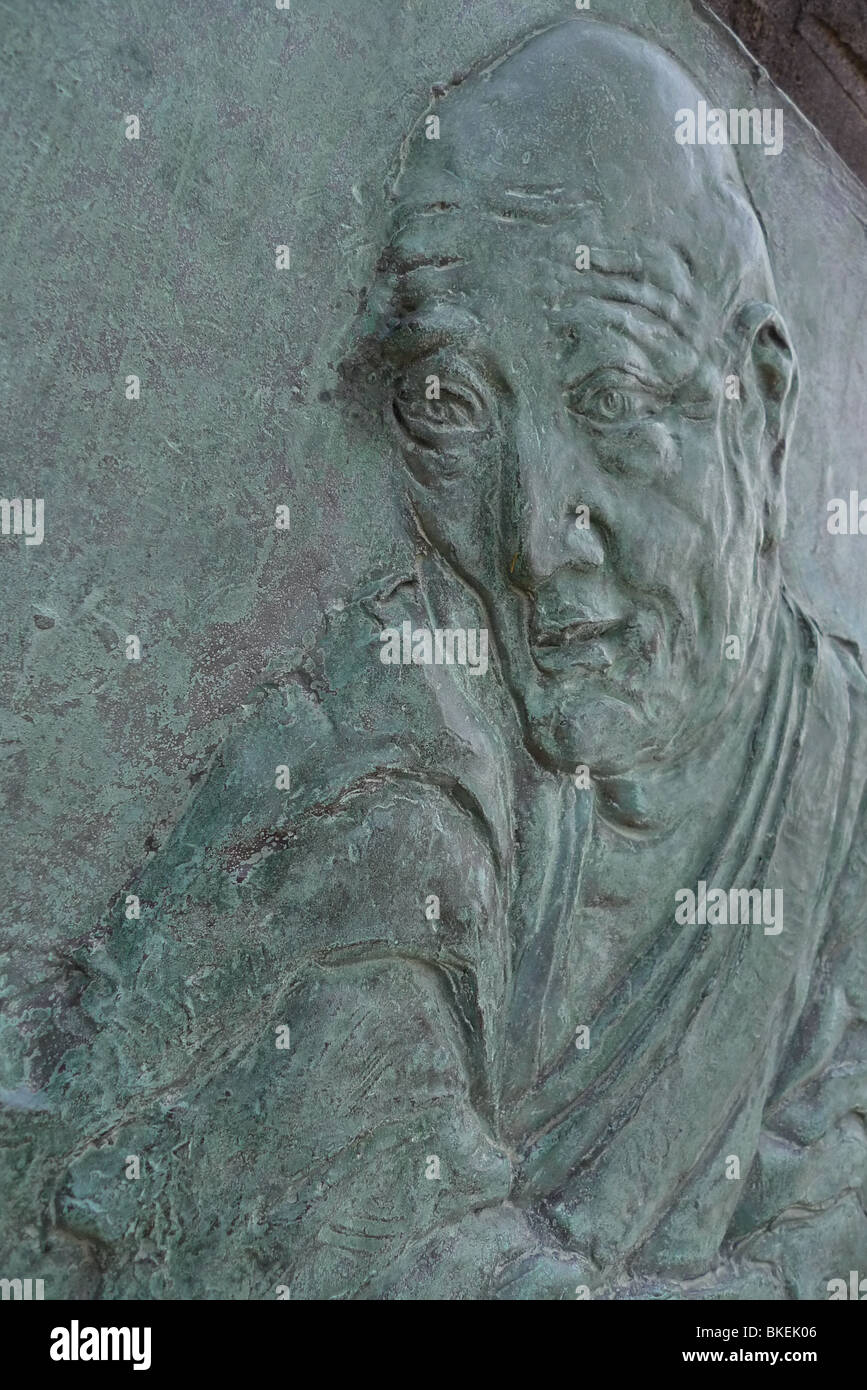 Katsushika Hokusai, was a Japanese artist, ukiyo-e painter and printmaker of the Edo period. Stock Photohttps://www.alamy.com/image-license-details/?v=1https://www.alamy.com/stock-photo-katsushika-hokusai-was-a-japanese-artist-ukiyo-e-painter-and-printmaker-29211062.html
Katsushika Hokusai, was a Japanese artist, ukiyo-e painter and printmaker of the Edo period. Stock Photohttps://www.alamy.com/image-license-details/?v=1https://www.alamy.com/stock-photo-katsushika-hokusai-was-a-japanese-artist-ukiyo-e-painter-and-printmaker-29211062.htmlRMBKEK06–Katsushika Hokusai, was a Japanese artist, ukiyo-e painter and printmaker of the Edo period.
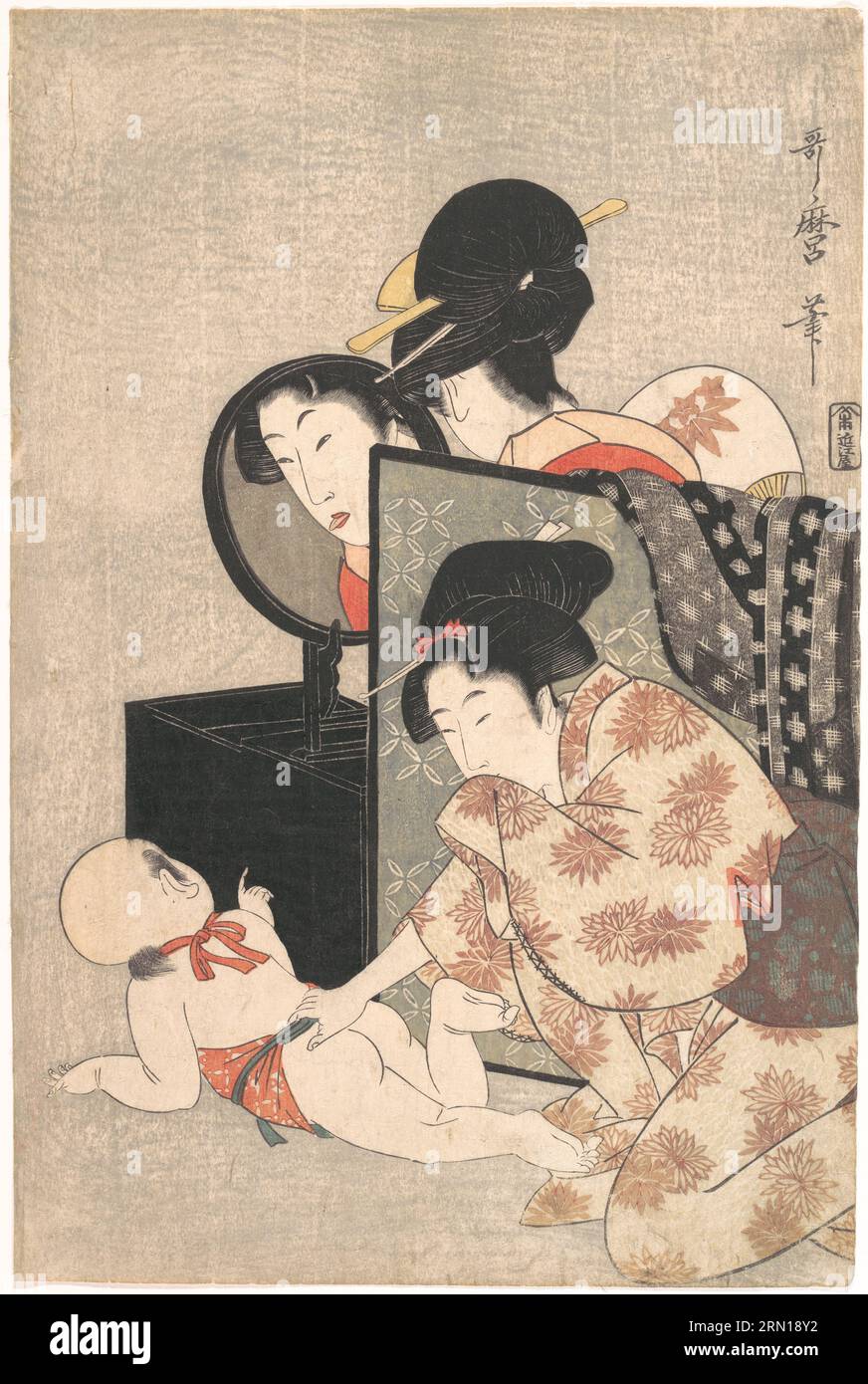 Japan: Two Women With Infant. Ukiyo-e woodblock print by Kitagawa Utamaro (1753 - 31 October 1806), c. 1793. Kitagawa Utamaro was a Japanese printmaker and painter, who is considered one of the greatest artists of woodblock prints (ukiyo-e). He is known especially for his masterfully composed studies of women, known as bijinga. He also produced nature studies, particularly illustrated books of insects. Stock Photohttps://www.alamy.com/image-license-details/?v=1https://www.alamy.com/japan-two-women-with-infant-ukiyo-e-woodblock-print-by-kitagawa-utamaro-1753-31-october-1806-c-1793-kitagawa-utamaro-was-a-japanese-printmaker-and-painter-who-is-considered-one-of-the-greatest-artists-of-woodblock-prints-ukiyo-e-he-is-known-especially-for-his-masterfully-composed-studies-of-women-known-as-bijinga-he-also-produced-nature-studies-particularly-illustrated-books-of-insects-image563668534.html
Japan: Two Women With Infant. Ukiyo-e woodblock print by Kitagawa Utamaro (1753 - 31 October 1806), c. 1793. Kitagawa Utamaro was a Japanese printmaker and painter, who is considered one of the greatest artists of woodblock prints (ukiyo-e). He is known especially for his masterfully composed studies of women, known as bijinga. He also produced nature studies, particularly illustrated books of insects. Stock Photohttps://www.alamy.com/image-license-details/?v=1https://www.alamy.com/japan-two-women-with-infant-ukiyo-e-woodblock-print-by-kitagawa-utamaro-1753-31-october-1806-c-1793-kitagawa-utamaro-was-a-japanese-printmaker-and-painter-who-is-considered-one-of-the-greatest-artists-of-woodblock-prints-ukiyo-e-he-is-known-especially-for-his-masterfully-composed-studies-of-women-known-as-bijinga-he-also-produced-nature-studies-particularly-illustrated-books-of-insects-image563668534.htmlRM2RN18Y2–Japan: Two Women With Infant. Ukiyo-e woodblock print by Kitagawa Utamaro (1753 - 31 October 1806), c. 1793. Kitagawa Utamaro was a Japanese printmaker and painter, who is considered one of the greatest artists of woodblock prints (ukiyo-e). He is known especially for his masterfully composed studies of women, known as bijinga. He also produced nature studies, particularly illustrated books of insects.
 Woodcut, colour, poster of Ukiyo-e print illustration showing boys enjoying the first of five sekku holidays, the Seiyo, or spring holiday. Artist, Kuniyoshi Utagawa (1798-1861). Stock Photohttps://www.alamy.com/image-license-details/?v=1https://www.alamy.com/stock-photo-woodcut-colour-poster-of-ukiyo-e-print-illustration-showing-boys-enjoying-90844854.html
Woodcut, colour, poster of Ukiyo-e print illustration showing boys enjoying the first of five sekku holidays, the Seiyo, or spring holiday. Artist, Kuniyoshi Utagawa (1798-1861). Stock Photohttps://www.alamy.com/image-license-details/?v=1https://www.alamy.com/stock-photo-woodcut-colour-poster-of-ukiyo-e-print-illustration-showing-boys-enjoying-90844854.htmlRMF7P9F2–Woodcut, colour, poster of Ukiyo-e print illustration showing boys enjoying the first of five sekku holidays, the Seiyo, or spring holiday. Artist, Kuniyoshi Utagawa (1798-1861).
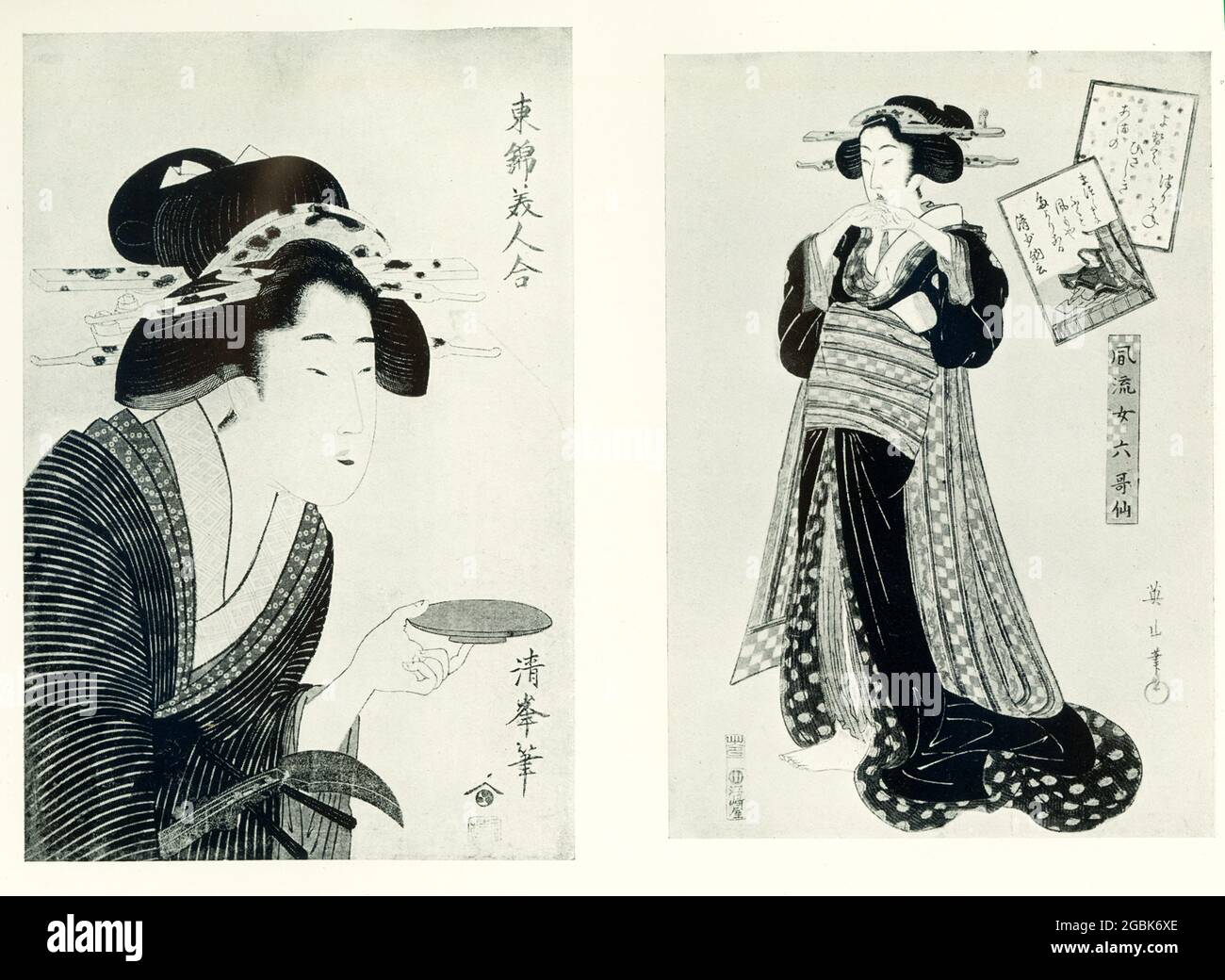 LEFT: Kiyomine-Woman holding out a sake cup signed Kiyomine. RIGHT:Yeizan-full-length figure-study of a geisha signed Yeizan The Japanese artist Kiyomine Torii lived from 1787 to 1868. Kikukawa Eizan (died 1867) was a designer of ukiyo-e style Japanese woodblock. prints. Stock Photohttps://www.alamy.com/image-license-details/?v=1https://www.alamy.com/left-kiyomine-woman-holding-out-a-sake-cup-signed-kiyomine-rightyeizan-full-length-figure-study-of-a-geisha-signed-yeizan-the-japanese-artist-kiyomine-torii-lived-from-1787-to-1868-kikukawa-eizan-died-1867-was-a-designer-of-ukiyo-e-style-japanese-woodblock-prints-image437442950.html
LEFT: Kiyomine-Woman holding out a sake cup signed Kiyomine. RIGHT:Yeizan-full-length figure-study of a geisha signed Yeizan The Japanese artist Kiyomine Torii lived from 1787 to 1868. Kikukawa Eizan (died 1867) was a designer of ukiyo-e style Japanese woodblock. prints. Stock Photohttps://www.alamy.com/image-license-details/?v=1https://www.alamy.com/left-kiyomine-woman-holding-out-a-sake-cup-signed-kiyomine-rightyeizan-full-length-figure-study-of-a-geisha-signed-yeizan-the-japanese-artist-kiyomine-torii-lived-from-1787-to-1868-kikukawa-eizan-died-1867-was-a-designer-of-ukiyo-e-style-japanese-woodblock-prints-image437442950.htmlRF2GBK6XE–LEFT: Kiyomine-Woman holding out a sake cup signed Kiyomine. RIGHT:Yeizan-full-length figure-study of a geisha signed Yeizan The Japanese artist Kiyomine Torii lived from 1787 to 1868. Kikukawa Eizan (died 1867) was a designer of ukiyo-e style Japanese woodblock. prints.
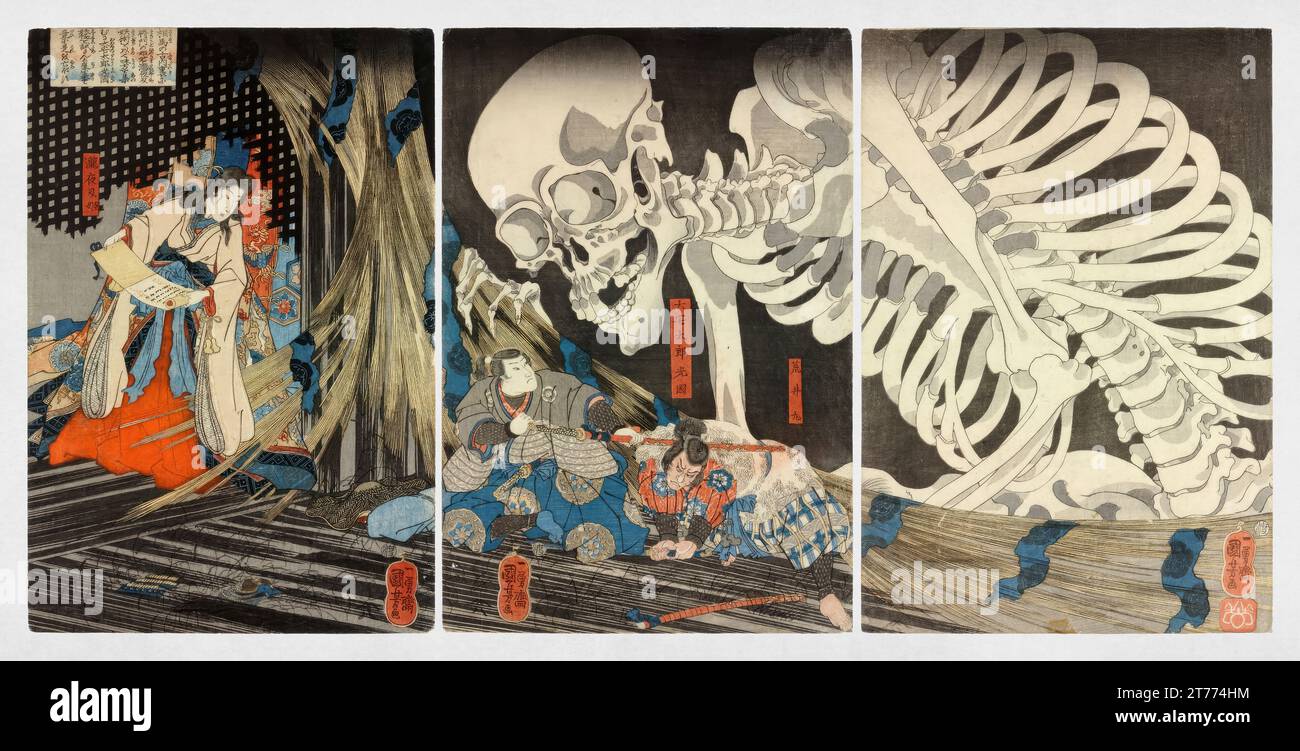 Takiyasha the Witch and the Skeleton Spectre is an ukiyo-e woodblock triptych made in 1844 by Japanese artist Utagawa Kuniyoshi (1798-1861). Stock Photohttps://www.alamy.com/image-license-details/?v=1https://www.alamy.com/takiyasha-the-witch-and-the-skeleton-spectre-is-an-ukiyo-e-woodblock-triptych-made-in-1844-by-japanese-artist-utagawa-kuniyoshi-1798-1861-image572402032.html
Takiyasha the Witch and the Skeleton Spectre is an ukiyo-e woodblock triptych made in 1844 by Japanese artist Utagawa Kuniyoshi (1798-1861). Stock Photohttps://www.alamy.com/image-license-details/?v=1https://www.alamy.com/takiyasha-the-witch-and-the-skeleton-spectre-is-an-ukiyo-e-woodblock-triptych-made-in-1844-by-japanese-artist-utagawa-kuniyoshi-1798-1861-image572402032.htmlRF2T774HM–Takiyasha the Witch and the Skeleton Spectre is an ukiyo-e woodblock triptych made in 1844 by Japanese artist Utagawa Kuniyoshi (1798-1861).
 Ukiyo-e landscape painting depicting historic map in the old days, Japan Stock Photohttps://www.alamy.com/image-license-details/?v=1https://www.alamy.com/ukiyo-e-landscape-painting-depicting-historic-map-in-the-old-days-image69249853.html
Ukiyo-e landscape painting depicting historic map in the old days, Japan Stock Photohttps://www.alamy.com/image-license-details/?v=1https://www.alamy.com/ukiyo-e-landscape-painting-depicting-historic-map-in-the-old-days-image69249853.htmlRME0JGW1–Ukiyo-e landscape painting depicting historic map in the old days, Japan
 Yellow (Ki), from the series Comparison of Five Colors in the Floating World (Ukiyo goshiki awase), by Utagawa Kunisada (Toyokuni III), Edo period Stock Photohttps://www.alamy.com/image-license-details/?v=1https://www.alamy.com/yellow-ki-from-the-series-comparison-of-five-colors-in-the-floating-world-ukiyo-goshiki-awase-by-utagawa-kunisada-toyokuni-iii-edo-period-image327644618.html
Yellow (Ki), from the series Comparison of Five Colors in the Floating World (Ukiyo goshiki awase), by Utagawa Kunisada (Toyokuni III), Edo period Stock Photohttps://www.alamy.com/image-license-details/?v=1https://www.alamy.com/yellow-ki-from-the-series-comparison-of-five-colors-in-the-floating-world-ukiyo-goshiki-awase-by-utagawa-kunisada-toyokuni-iii-edo-period-image327644618.htmlRF2A11E1E–Yellow (Ki), from the series Comparison of Five Colors in the Floating World (Ukiyo goshiki awase), by Utagawa Kunisada (Toyokuni III), Edo period
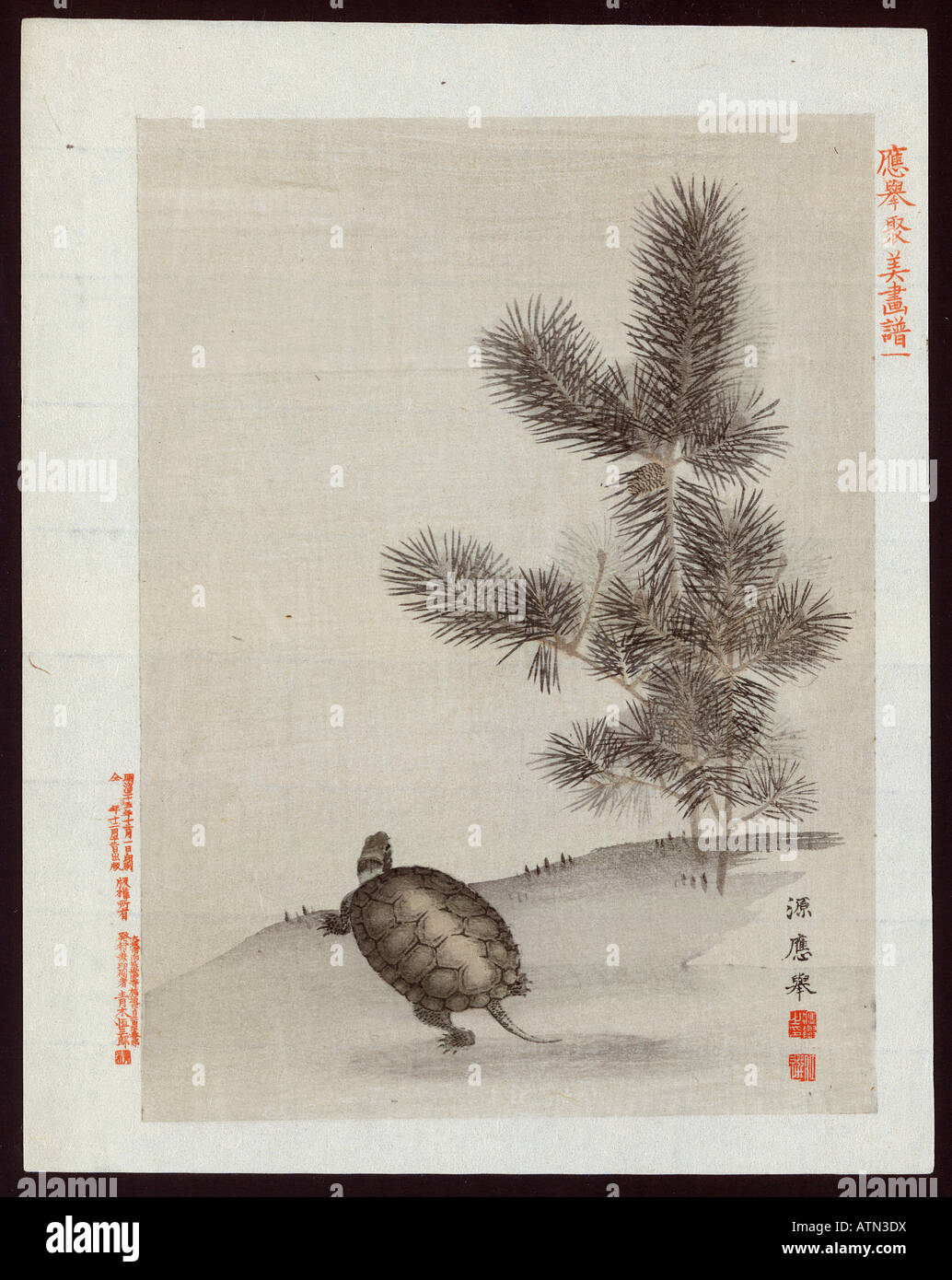 Japanese Ukiyo e print Stock Photohttps://www.alamy.com/image-license-details/?v=1https://www.alamy.com/stock-photo-japanese-ukiyo-e-print-16355413.html
Japanese Ukiyo e print Stock Photohttps://www.alamy.com/image-license-details/?v=1https://www.alamy.com/stock-photo-japanese-ukiyo-e-print-16355413.htmlRMATN3DX–Japanese Ukiyo e print
 Original Japanese Ukiyo-e Woodblock Print by TOYOKUNI 18th Century Stock Photohttps://www.alamy.com/image-license-details/?v=1https://www.alamy.com/original-japanese-ukiyo-e-woodblock-print-by-toyokuni-18th-century-image623917830.html
Original Japanese Ukiyo-e Woodblock Print by TOYOKUNI 18th Century Stock Photohttps://www.alamy.com/image-license-details/?v=1https://www.alamy.com/original-japanese-ukiyo-e-woodblock-print-by-toyokuni-18th-century-image623917830.htmlRM2Y71WFJ–Original Japanese Ukiyo-e Woodblock Print by TOYOKUNI 18th Century
 Non-Japanese female foreigner has a hand at painting a copy of old Ukiyo-e woodblock print at fair in Odawara, Kanagawa, Japan. Stock Photohttps://www.alamy.com/image-license-details/?v=1https://www.alamy.com/stock-photo-non-japanese-female-foreigner-has-a-hand-at-painting-a-copy-of-old-53767181.html
Non-Japanese female foreigner has a hand at painting a copy of old Ukiyo-e woodblock print at fair in Odawara, Kanagawa, Japan. Stock Photohttps://www.alamy.com/image-license-details/?v=1https://www.alamy.com/stock-photo-non-japanese-female-foreigner-has-a-hand-at-painting-a-copy-of-old-53767181.htmlRMD3D8GD–Non-Japanese female foreigner has a hand at painting a copy of old Ukiyo-e woodblock print at fair in Odawara, Kanagawa, Japan.
 The Kyoto workshop of Japanese ukiyo-e artist and woodblock printer Mamoru Ichimura. Stock Photohttps://www.alamy.com/image-license-details/?v=1https://www.alamy.com/stock-photo-the-kyoto-workshop-of-japanese-ukiyo-e-artist-and-woodblock-printer-54199056.html
The Kyoto workshop of Japanese ukiyo-e artist and woodblock printer Mamoru Ichimura. Stock Photohttps://www.alamy.com/image-license-details/?v=1https://www.alamy.com/stock-photo-the-kyoto-workshop-of-japanese-ukiyo-e-artist-and-woodblock-printer-54199056.htmlRMD44YCG–The Kyoto workshop of Japanese ukiyo-e artist and woodblock printer Mamoru Ichimura.
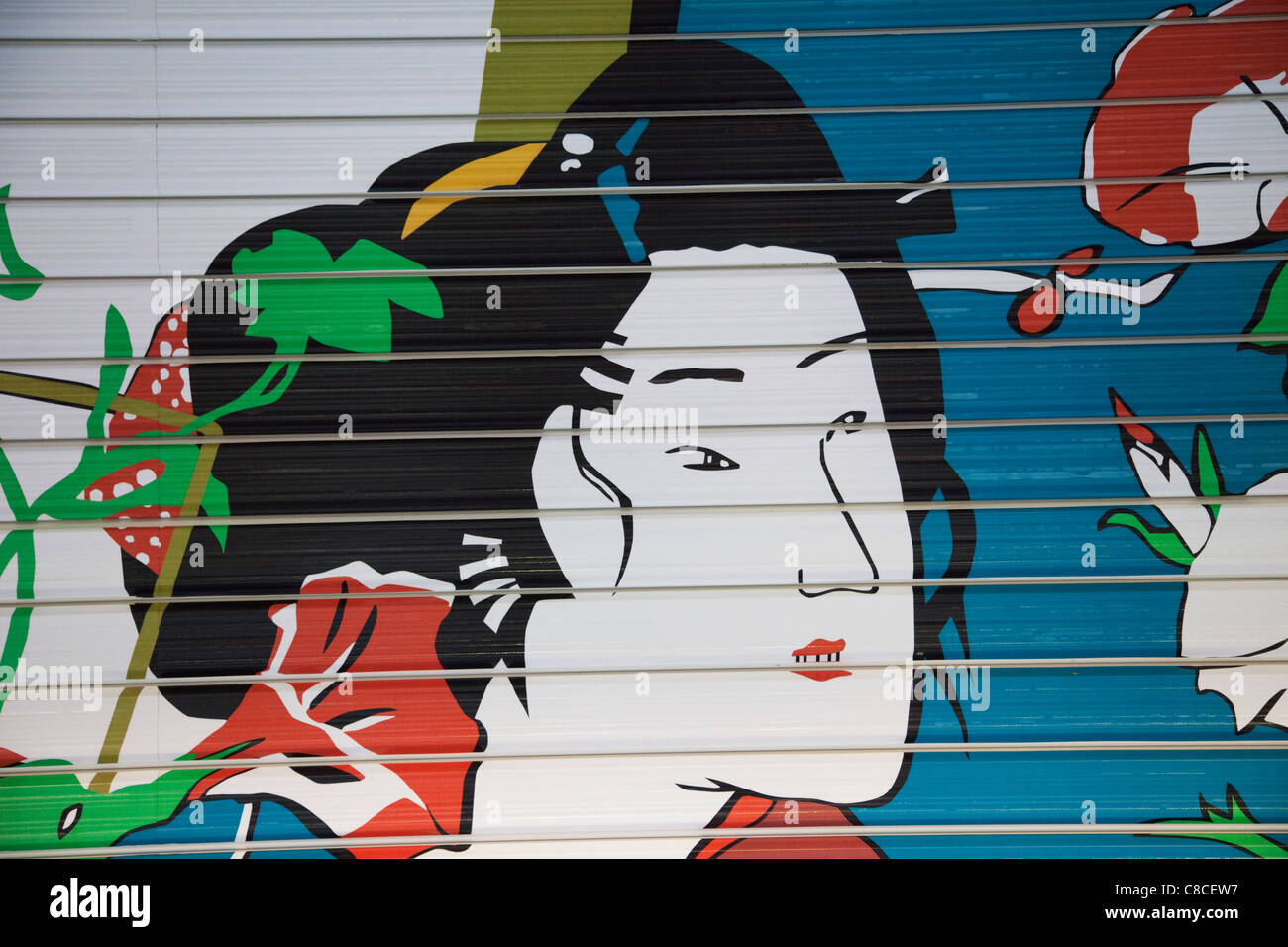 Japan, Tokyo, Asakusa, Ukiyo-e Style Artwork on Shop Shutters Stock Photohttps://www.alamy.com/image-license-details/?v=1https://www.alamy.com/stock-photo-japan-tokyo-asakusa-ukiyo-e-style-artwork-on-shop-shutters-39613091.html
Japan, Tokyo, Asakusa, Ukiyo-e Style Artwork on Shop Shutters Stock Photohttps://www.alamy.com/image-license-details/?v=1https://www.alamy.com/stock-photo-japan-tokyo-asakusa-ukiyo-e-style-artwork-on-shop-shutters-39613091.htmlRMC8CEW7–Japan, Tokyo, Asakusa, Ukiyo-e Style Artwork on Shop Shutters
 The actor Yae Misazo, Utagawa Kunisada, Japanese, 1786 – 1864, Woodblock print (ukiyo-e) on mulberry paper (washi), ink with color, Japan, 1858, theater, Print Stock Photohttps://www.alamy.com/image-license-details/?v=1https://www.alamy.com/the-actor-yae-misazo-utagawa-kunisada-japanese-1786-1864-woodblock-print-ukiyo-e-on-mulberry-paper-washi-ink-with-color-japan-1858-theater-print-image391238081.html
The actor Yae Misazo, Utagawa Kunisada, Japanese, 1786 – 1864, Woodblock print (ukiyo-e) on mulberry paper (washi), ink with color, Japan, 1858, theater, Print Stock Photohttps://www.alamy.com/image-license-details/?v=1https://www.alamy.com/the-actor-yae-misazo-utagawa-kunisada-japanese-1786-1864-woodblock-print-ukiyo-e-on-mulberry-paper-washi-ink-with-color-japan-1858-theater-print-image391238081.htmlRM2DMEC4H–The actor Yae Misazo, Utagawa Kunisada, Japanese, 1786 – 1864, Woodblock print (ukiyo-e) on mulberry paper (washi), ink with color, Japan, 1858, theater, Print
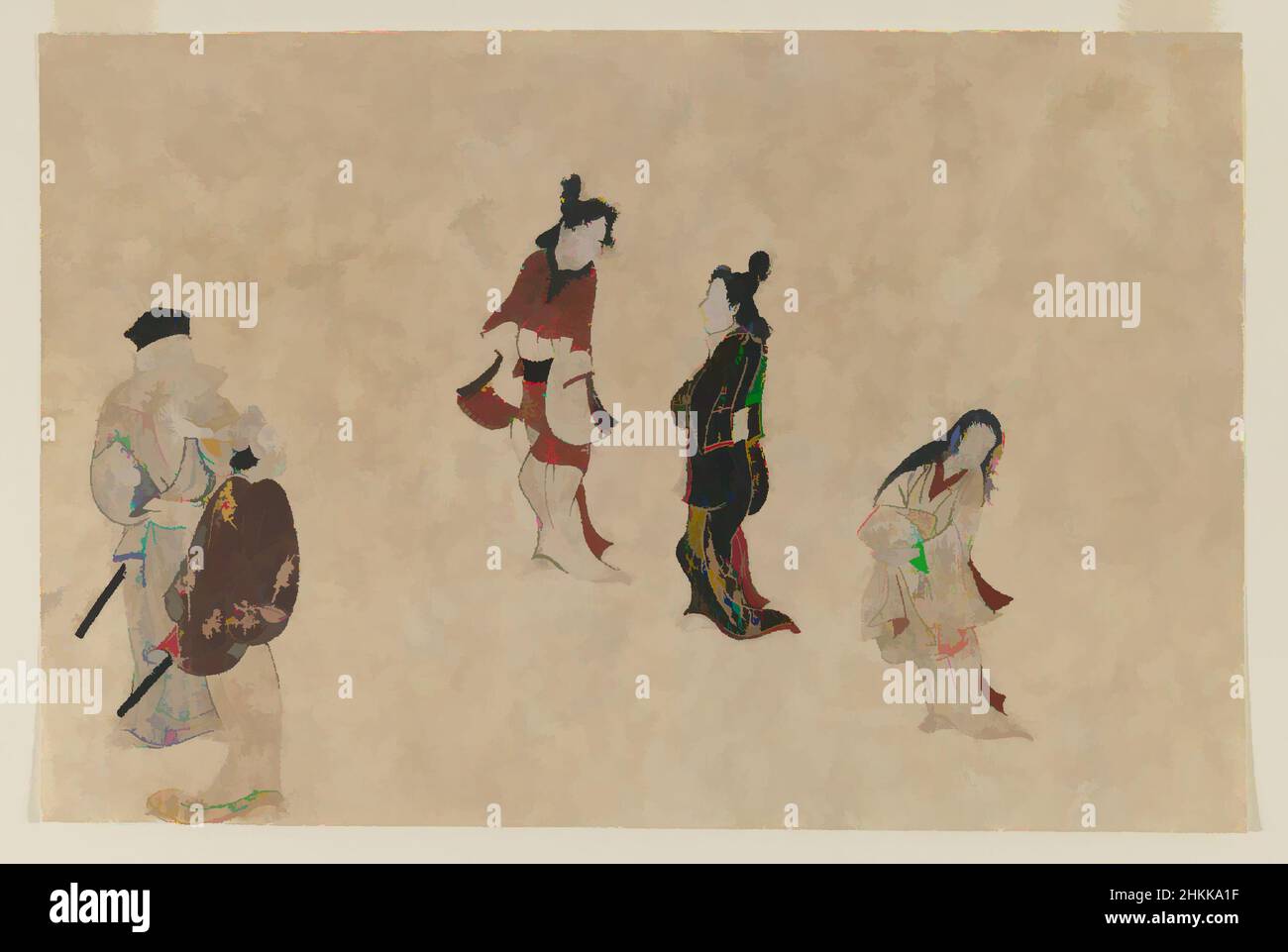 Art inspired by Early Ukiyo-e Painting, Ink, color and gold on paper, Japan, 1625-1640, Edo Period, 10 7/16 x 13 13/16 in., 26.5 x 35.1 cm, Classic works modernized by Artotop with a splash of modernity. Shapes, color and value, eye-catching visual impact on art. Emotions through freedom of artworks in a contemporary way. A timeless message pursuing a wildly creative new direction. Artists turning to the digital medium and creating the Artotop NFT Stock Photohttps://www.alamy.com/image-license-details/?v=1https://www.alamy.com/art-inspired-by-early-ukiyo-e-painting-ink-color-and-gold-on-paper-japan-1625-1640-edo-period-10-716-x-13-1316-in-265-x-351-cm-classic-works-modernized-by-artotop-with-a-splash-of-modernity-shapes-color-and-value-eye-catching-visual-impact-on-art-emotions-through-freedom-of-artworks-in-a-contemporary-way-a-timeless-message-pursuing-a-wildly-creative-new-direction-artists-turning-to-the-digital-medium-and-creating-the-artotop-nft-image459573003.html
Art inspired by Early Ukiyo-e Painting, Ink, color and gold on paper, Japan, 1625-1640, Edo Period, 10 7/16 x 13 13/16 in., 26.5 x 35.1 cm, Classic works modernized by Artotop with a splash of modernity. Shapes, color and value, eye-catching visual impact on art. Emotions through freedom of artworks in a contemporary way. A timeless message pursuing a wildly creative new direction. Artists turning to the digital medium and creating the Artotop NFT Stock Photohttps://www.alamy.com/image-license-details/?v=1https://www.alamy.com/art-inspired-by-early-ukiyo-e-painting-ink-color-and-gold-on-paper-japan-1625-1640-edo-period-10-716-x-13-1316-in-265-x-351-cm-classic-works-modernized-by-artotop-with-a-splash-of-modernity-shapes-color-and-value-eye-catching-visual-impact-on-art-emotions-through-freedom-of-artworks-in-a-contemporary-way-a-timeless-message-pursuing-a-wildly-creative-new-direction-artists-turning-to-the-digital-medium-and-creating-the-artotop-nft-image459573003.htmlRF2HKKA1F–Art inspired by Early Ukiyo-e Painting, Ink, color and gold on paper, Japan, 1625-1640, Edo Period, 10 7/16 x 13 13/16 in., 26.5 x 35.1 cm, Classic works modernized by Artotop with a splash of modernity. Shapes, color and value, eye-catching visual impact on art. Emotions through freedom of artworks in a contemporary way. A timeless message pursuing a wildly creative new direction. Artists turning to the digital medium and creating the Artotop NFT
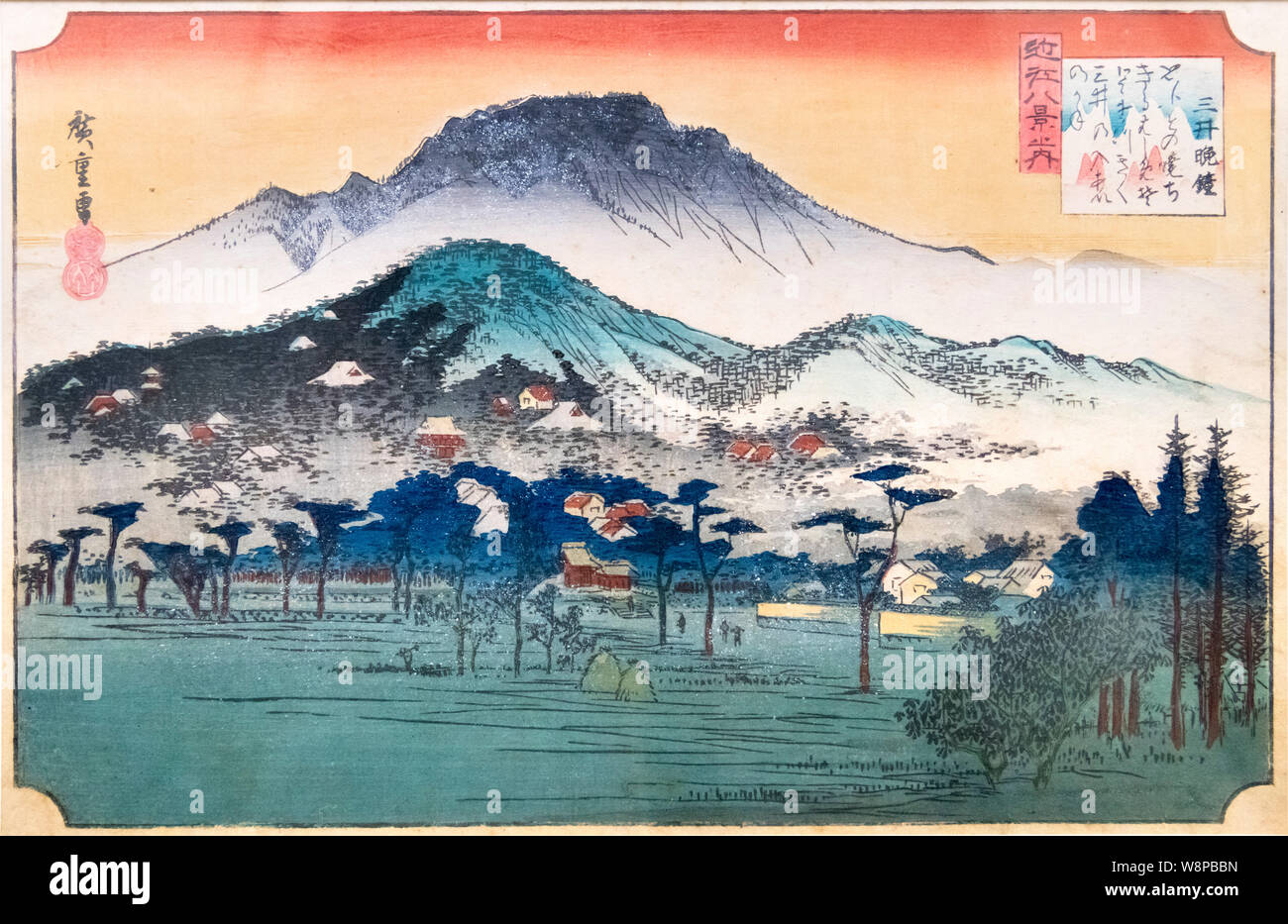 The Eight Scenes of Omi Province: Evening Bell at Mii Temple by Utagawa Hiroshige (1797 -1858), Edo period, 19th century, National Museum, Tokyo, Japan Stock Photohttps://www.alamy.com/image-license-details/?v=1https://www.alamy.com/the-eight-scenes-of-omi-province-evening-bell-at-mii-temple-by-utagawa-hiroshige-1797-1858-edo-period-19th-century-national-museum-tokyo-japan-image263564665.html
The Eight Scenes of Omi Province: Evening Bell at Mii Temple by Utagawa Hiroshige (1797 -1858), Edo period, 19th century, National Museum, Tokyo, Japan Stock Photohttps://www.alamy.com/image-license-details/?v=1https://www.alamy.com/the-eight-scenes-of-omi-province-evening-bell-at-mii-temple-by-utagawa-hiroshige-1797-1858-edo-period-19th-century-national-museum-tokyo-japan-image263564665.htmlRMW8PBBN–The Eight Scenes of Omi Province: Evening Bell at Mii Temple by Utagawa Hiroshige (1797 -1858), Edo period, 19th century, National Museum, Tokyo, Japan
 Yuranosuke, Kumagai and Jiraiya by Utagawa Kunisada (1786-1865) Japanese designer of ukiyo-e woodblock prints. Dated 1854 Stock Photohttps://www.alamy.com/image-license-details/?v=1https://www.alamy.com/yuranosuke-kumagai-and-jiraiya-by-utagawa-kunisada-1786-1865-japanese-designer-of-ukiyo-e-woodblock-prints-dated-1854-image257286840.html
Yuranosuke, Kumagai and Jiraiya by Utagawa Kunisada (1786-1865) Japanese designer of ukiyo-e woodblock prints. Dated 1854 Stock Photohttps://www.alamy.com/image-license-details/?v=1https://www.alamy.com/yuranosuke-kumagai-and-jiraiya-by-utagawa-kunisada-1786-1865-japanese-designer-of-ukiyo-e-woodblock-prints-dated-1854-image257286840.htmlRMTXGBYM–Yuranosuke, Kumagai and Jiraiya by Utagawa Kunisada (1786-1865) Japanese designer of ukiyo-e woodblock prints. Dated 1854
 Chinese Ship Stock Photohttps://www.alamy.com/image-license-details/?v=1https://www.alamy.com/stock-photo-chinese-ship-23915186.html
Chinese Ship Stock Photohttps://www.alamy.com/image-license-details/?v=1https://www.alamy.com/stock-photo-chinese-ship-23915186.htmlRMBAWC1P–Chinese Ship
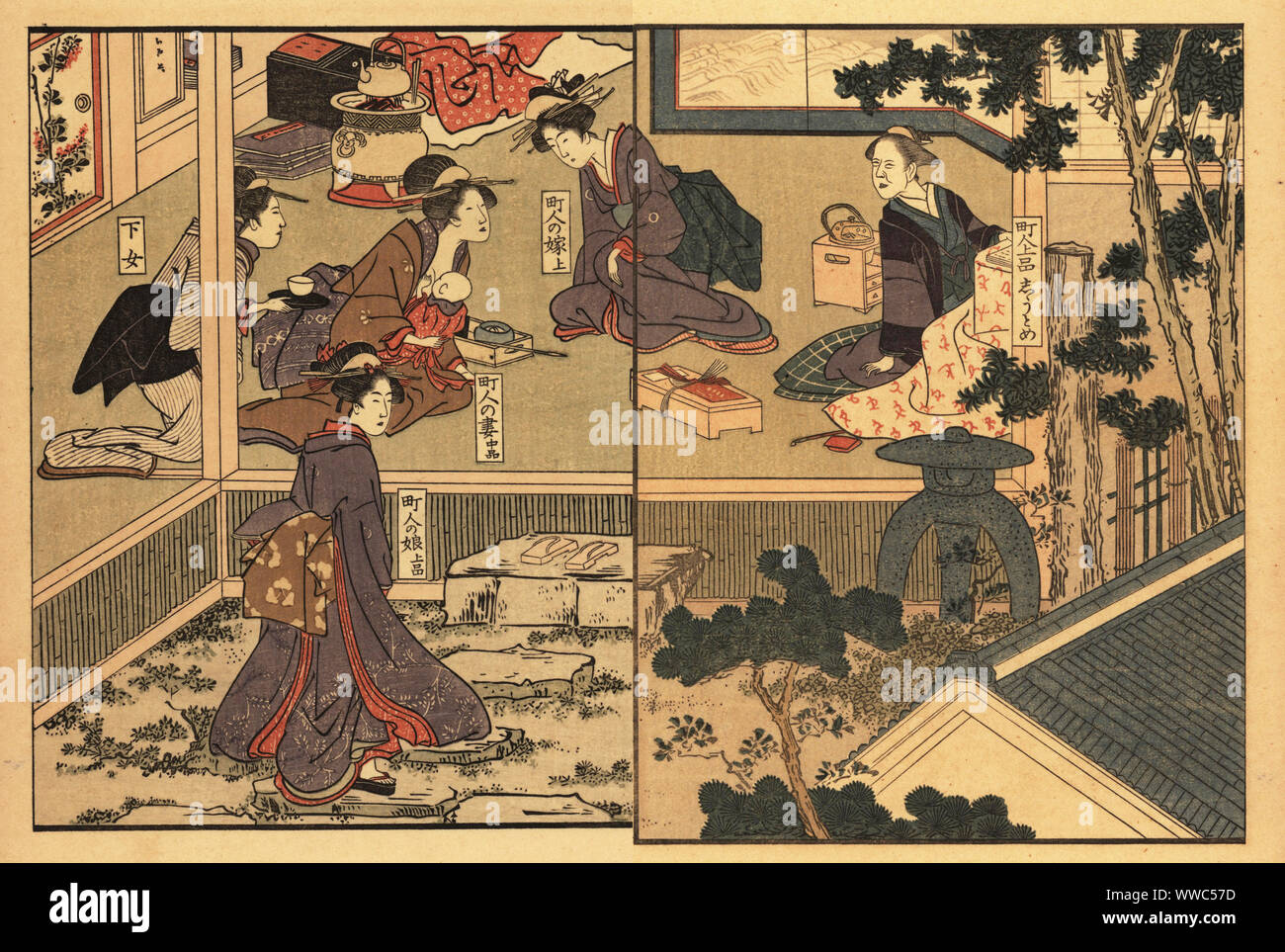 Wealthy townswomen, Tokyo, 18th century. Three young chonin women gather at the house of an older woman for a meeting. A maid brings tea to a young nursing mother. Handcoloured ukiyo-e woodblock print by Toyokuni Utagawa from Shikitei Sanba’s Ehon Imayo Sugata (Picture Book of the Modern Forms and Figures, Tokyo, 1916. Reprint of the original from 1802. Stock Photohttps://www.alamy.com/image-license-details/?v=1https://www.alamy.com/wealthy-townswomen-tokyo-18th-century-three-young-chonin-women-gather-at-the-house-of-an-older-woman-for-a-meeting-a-maid-brings-tea-to-a-young-nursing-mother-handcoloured-ukiyo-e-woodblock-print-by-toyokuni-utagawa-from-shikitei-sanbas-ehon-imayo-sugata-picture-book-of-the-modern-forms-and-figures-tokyo-1916-reprint-of-the-original-from-1802-image273789473.html
Wealthy townswomen, Tokyo, 18th century. Three young chonin women gather at the house of an older woman for a meeting. A maid brings tea to a young nursing mother. Handcoloured ukiyo-e woodblock print by Toyokuni Utagawa from Shikitei Sanba’s Ehon Imayo Sugata (Picture Book of the Modern Forms and Figures, Tokyo, 1916. Reprint of the original from 1802. Stock Photohttps://www.alamy.com/image-license-details/?v=1https://www.alamy.com/wealthy-townswomen-tokyo-18th-century-three-young-chonin-women-gather-at-the-house-of-an-older-woman-for-a-meeting-a-maid-brings-tea-to-a-young-nursing-mother-handcoloured-ukiyo-e-woodblock-print-by-toyokuni-utagawa-from-shikitei-sanbas-ehon-imayo-sugata-picture-book-of-the-modern-forms-and-figures-tokyo-1916-reprint-of-the-original-from-1802-image273789473.htmlRMWWC57D–Wealthy townswomen, Tokyo, 18th century. Three young chonin women gather at the house of an older woman for a meeting. A maid brings tea to a young nursing mother. Handcoloured ukiyo-e woodblock print by Toyokuni Utagawa from Shikitei Sanba’s Ehon Imayo Sugata (Picture Book of the Modern Forms and Figures, Tokyo, 1916. Reprint of the original from 1802.
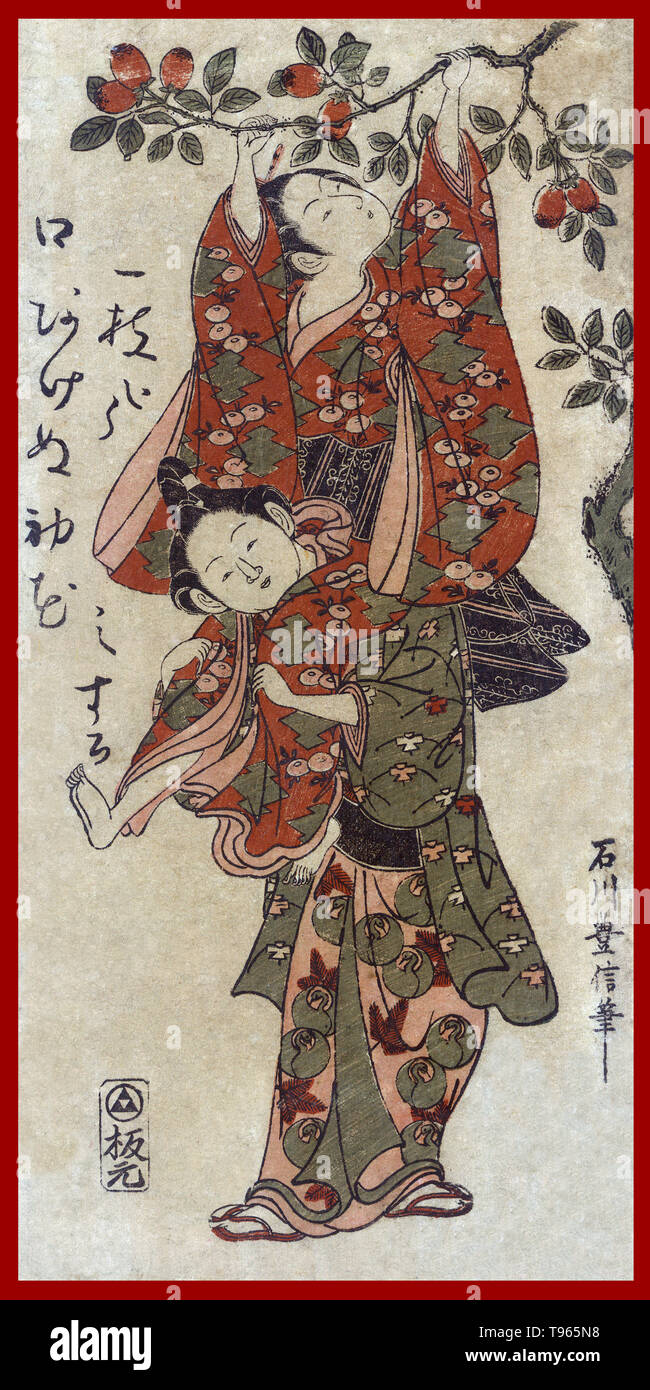 Kaki mogi. Picking persimmons. A young man holding a young woman on his shoulders as she reaches to pick persimmons from a branch above them. Ukiyo-e (picture of the floating world) is a genre of Japanese art which flourished from the 17th through 19th centuries. Ukiyo-e was central to forming the West's perception of Japanese art in the late 19th century. Stock Photohttps://www.alamy.com/image-license-details/?v=1https://www.alamy.com/kaki-mogi-picking-persimmons-a-young-man-holding-a-young-woman-on-his-shoulders-as-she-reaches-to-pick-persimmons-from-a-branch-above-them-ukiyo-e-picture-of-the-floating-world-is-a-genre-of-japanese-art-which-flourished-from-the-17th-through-19th-centuries-ukiyo-e-was-central-to-forming-the-wests-perception-of-japanese-art-in-the-late-19th-century-image246613284.html
Kaki mogi. Picking persimmons. A young man holding a young woman on his shoulders as she reaches to pick persimmons from a branch above them. Ukiyo-e (picture of the floating world) is a genre of Japanese art which flourished from the 17th through 19th centuries. Ukiyo-e was central to forming the West's perception of Japanese art in the late 19th century. Stock Photohttps://www.alamy.com/image-license-details/?v=1https://www.alamy.com/kaki-mogi-picking-persimmons-a-young-man-holding-a-young-woman-on-his-shoulders-as-she-reaches-to-pick-persimmons-from-a-branch-above-them-ukiyo-e-picture-of-the-floating-world-is-a-genre-of-japanese-art-which-flourished-from-the-17th-through-19th-centuries-ukiyo-e-was-central-to-forming-the-wests-perception-of-japanese-art-in-the-late-19th-century-image246613284.htmlRMT965N8–Kaki mogi. Picking persimmons. A young man holding a young woman on his shoulders as she reaches to pick persimmons from a branch above them. Ukiyo-e (picture of the floating world) is a genre of Japanese art which flourished from the 17th through 19th centuries. Ukiyo-e was central to forming the West's perception of Japanese art in the late 19th century.